
ancient amazon
arqueologia no entorno | an arqueologia no entorno an archaeology in the surroundings in the



arqueologia no entorno | an arqueologia no entorno an archaeology in the surroundings in the

A Amazônia tornou-se o símbolo verde da esperança de um mundo em constante transformação, e busca-se, através da evolução econômica, científica e tecnológica, contribuir para preservar e divulgar uma das regiões mais importantes de nosso planeta.
É por isso que, no momento em que todos os olhares se voltam para a Amazônia, torna-se fundamental a edição deste livro. Ele estabelece o elo fundamental que liga épocas e culturas no tempo e na história, lembrando-nos de que só poderemos compreender o presente se nos reportarmos ao passado e só poderemos projetar o futuro se construirmos o presente. Em Amazônia antiga, a arte e a ciência estão interligadas, retratando a integração harmônica e atemporal da vida humana.
O fotógrafo Maurício de Paiva e a jornalista Mônica Trindade Canejo passaram anos pesquisando e captando belas imagens que pudessem mostrar a interação e a preservação dos elementos pré-históricos encontrados na Amazônia com a dinâmica atual da vida cotidiana, os sítios arqueológicos e seu entorno: os caboclos, os rios e as matas. O resultado, como vocês poderão comprovar, é excepcional.
Assim sendo, a Fosfertil – uma empresa que atua segundo os mais modernos princípios de sustentabilidade e responsabilidade social – sente-se honrada em participar da edição de Amazônia antiga
Vital Jorge Lopes presidenteThe Amazon has become the green symbol of hope for a constantly changing world, one that seeks through economic, scientific and technological evolution to contribute to preserve and spread information about one of our planet’s most important regions.
This is why this book’s release becomes fundamental at a moment when everybody’s eyes are turned to the Amazon. It establishes the fundamental link in time and history between epochs and cultures, reminding us that we can only understand the present with the past as a reference, and that we can only project the future if we build the present. In Ancient Amazon, art and science are intertwined, portraying the harmonic and timeless integration of human life.
Photographer Maurício de Paiva and journalist Mônica Trindade Canejo have spent years researching and capturing beautiful images that could show the preservation and the interaction of prehistoric elements found in the Amazon with the current workings of everyday life, the archaeological sites and their surroundings: the Caboclos, the rivers and the forest. The result, as you will be able to attest, is outstanding.
Thus, Fosfertil – a company that works within the most modern principles of sustainability and social responsibility – feels honored in participating in the publishing of Ancient Amazon
 Vital Jorge Lopes President
Vital Jorge Lopes President
www.fosfertil.com.br



arqueologia no entorno | an archaeology in the surroundings
Estatueta antropomorfa da cultura tapajônica, região de Santarém, Estatueta da cultura de Santarém, Pará Idade desconhecida, provavelmente início do segundo milênio Pará. Idade desconhecida, início do milênio d C Acervo do MAE USP d. C. Acervo do MAE-USP
Anthropomorphic statuette of the Tapajós culture, Santarém region, Pará
Anthropomorphic statuette of the Tapajós culture, Santarém region, Pará. Age unknown, probably the early second millennium AD Collection of unknown, the second millennium AD. Collection of the University of São Paulo’s Museum of Archaeology and Ethnography, the of São Paulo’s Museum of and Ethnography, MAE USP MAE-USP

Dedico este livro à presença de meus filhos, Enrique e Helena; à memória de meu pai, Nelson, que, junto com meu avô Jorge, despertou na infância de Dedico este livro à presença de meus filhos, e Helena; à memória de meu Nelson, que, com meu avô na minhas mãos o tato para a página impressa e o apreço pela cor; ao padrinho Eduardo Góes Neves; a Daniel Brasil, o menino que primeiro me recebeu em minhas mãos o tato para a e o apreço cor; ao Eduardo Góes Neves; a Daniel Brasil, o menino que me em Vila Tessalônica, na ilha de Marajó, mostrando me o fragmento cerâmico de “índio deitado” que encontrara à beira do rio Araramã; e a Mônica Trindade Vila Tessalônica, na ilha de mostrando-me o cerâmico de “índio deitado” que encontrara à beira do rio Araramã; e a Mônica Trindade Canejo, profundamente esperançosa Com carinho e respeito por todas as pessoas que fazem a Amazônia Hoje, ontem e nos últimos 11 200 anos profundamente esperançosa. Com carinho e respeito por todas as pessoas que fazem a Amazônia. Hoje, ontem e nos últimos 11 200 anos.
I dedicate this book to the presence of my children, Enrique and Helena; to the memory of my father, Nelson, who along with my grandfather Jorge I dedicate this book to the presence of my children, and Helena; to the memory of my father, Nelson, who with my awoke my hands’ childhood to the feel of a printed page and the appreciation of color; to my mentor awoke my hands’ childhood to the feel of a page and the of color; to my mentor Eduardo Góes Neves; to Daniel Brasil, the boy Eduardo Góes Neves; to Daniel Brasil, the who first received me at Vila Tessalônica, on Marajó Island, showing me the ceramic fragment of a ‘lying Indian’ he had found on the bank of the who first received me at Vila Tessalônica, on Island, me the ceramic of a Indian’ he had found on Araramã River; and to a deeply hopeful Mônica Trindade Canejo Araramã River; and to a Mônica Trindade Canejo. With fondness and respect for all the people who make the Amazon what it is With fondness and respect for all the who make the Amazon what it is. Today, yesterday, and in the last 11,200 years and in the last 11,200 years.
LUZ NO
Sabedoria e instinto milenar, a imagem pode ser considerada a técnica mais antiga de transmitir ensinamentos entre gerações. Desde sempre, a história do planeta e de seus habitantes é contada e representada pela interpretação dos símbolos-signos das imagens de suas obras. A imagem desempenha o papel de mais poderoso agente na capacidade de instigar a memória e polinizar a capacidade de raciocinar e sentir. Ela integraliza o passado e o futuro no presente. Congela e classifica os momentos dispondo as ferramentas que precisamos usar para o conhecimento de nossa própria história e o desfrute sensorial e intelectual.
A gramática e a ética da imagem e do ato de ver nos permitem conhecer novos códigos visuais a cada geração de fotógrafos, que alteram e ampliam nossas noções sobre o que deve ser visto e o que temos direito de poder observar. O grande mosaico visual criado a partir de 1839, quando se começou a fotografar tudo e todos, nos oferece a sensação de ter o mundo nas mãos com essa antologia universal de visões fotográficas. Imagens que, como acredita Susan Sontag, vão iluminar a caverna de Platão e seus moradores na busca pela verdade e compreensão da realidade.
Amazônia antiga arqueologia no entorno traz uma dessas coleções de imagens que vêm educando nossos sentidos através dos tempos. Maurício de Paiva, fotojornalista caçador de imagens, inconformado-curioso-visceral, nos conduz com sua inquietude pela dimensão arqueológica, o estudo da história da humanidade.
Fronteira visual raramente abordada, a ciência arqueológica, nesta obra, se discute da inédita perspectiva das planícies amazônicas. Somam-se a fotografia e seu impacto emocional para penetrar pelas portas de nossa percepção transcendental. Os fragmentos de história nestas imagens são representados em prateleiras com cacos de civilizações, sobrepostos cronologicamente, decodificando seus ensinamentos. São olhares e gestos dos habitantes desta Terra Prometida, escolhida ao acaso divino, dentro da imensidão da floresta e nas mesmas coordenadas geográficas das anteriores, onde foram se sucedendo milagrosamente, repetindo os usos e costumes nos mesmos sítios dos viventes do terceiro milênio, que aqui nos ajudam a perceber com a clareza de um raio – ou a luz de um flash – milhares de anos numa imagem.
Esta viagem pelo saber, suave navegar através do tempo cósmico, nos transporta envoltos na ambiguidade da densa leveza das formas e da profundidade do aquarelismo que
o panorama amazônico nos presenteia. São molduras ideais para rostos semelhantes e gostos iguais, de seres que repetem gestos, hábitos e afazeres, sonhos e febres e que, depois de milhões de dias nos mesmos lugares, usam a argila da mesma água e da mesma terra, nesses pontos essenciais do coração do planeta.
Guiado por sua intuição (iluminada pelo conhecimento científico de seus companheiros de jornada), Maurício reconhece e confronta pelos olhares que povoam suas imagens as muitas faces da mesma história dentro do tempo infinito. Estampadas no barro ou coladas nos firmamentos e águas monumentais da Amazônia, são como efígies de moedas de um milenar tesouro que Deus deixou para ser entendido e reconhecido por quem ali estiver vivendo. Ensinamento preciso e fluente, aqui bem debaixo de nossos pés, ao alcance de nossos sentidos e saberes.
Extrativismo espiritual e social, os fragmentos visuais dispostos pela história vão formando um mosaico de sensações transcendentais, causadas e captadas pela visão do autor. Foram produzidas segundo os mais tradicionais e comprometidos padrões de documentação fotoantropológica. Respeitam os princípios do melhor fotojornalismo e impactam e renovam fortemente nossos paradigmas imagéticos. Essa colagem cósmica da natureza perturba o senso terreno e presente, pois extrapola o registro científico e vai além do relatório quando toca o emocional e mágico, invadindo nosso subconsciente sem remorso, pecado ou perdão. Envolvendo e transportando nossos sentidos e espírito para que possamos compreender nossa própria existência, Amazônia antiga – arqueologia no entorno , enfim, inaugura uma nova dimensão iconográfica, a da próxima geração de livros de fotografia e ciência produzidos no Brasil e em língua portuguesa. Uma lindíssima história plena de descobertas científicas e prazeres visuais, explorada com astúcia respeitosa, rigor estético e consistência informativa. Um tempo precioso de genuíno prazer intelectual e sensorial.
Julho de 2009
Fotojornalista e professor de fotografia, publica desde 1969. Com passagens pelos mais influentes veículos de imprensa brasileiros, fundou a agência Angular. É seguidor de Robert Capa.
Images, being wisdom and millennia-old instinct, can be considered the oldest technique for transmitting teachings between generations. Since time immemorial, the history of the planet and its inhabitants has been told and represented by the interpretation of the symbols/signs of their works’ images. Images play the role of the most powerful agent capable of stimulating memory and pollinating the ability to reason and feel. They sum up the past and the future into the present. They freeze and classify the moments by using the tools we need for gathering the knowledge of our own history and for our sensory and intellectual enjoyment.
The grammar and ethics of images and of the act of seeing allow us to learn new visual codes in each new generation of photographers, who change and broaden our notions about what must be seen and what we are entitled to observe. The great visual mosaic created in 1839, when people started photographing everything and everyone, offers us the feeling of having the world in our hands with that universal anthology of photographic visions. Images which, as Susan Sontag believes, are going to lighten Plato’s cave and its dwellers in their search for truth and understanding of reality.
Ancient Amazon – an Archaeology in the Surroundings shows one of those collections of images which have been educating our senses throughout time. Maurício de Paiva, an imagehunting photographic journalist, a nonconformist-curious-visceral person, leads us with his disquiet through the archaeological dimension, the study of mankind’s history.
A rarely approached visual frontier, in this work archaeological science is discussed from the new perspective of the Amazon plains. Photography and its emotional impact are joined to enter through the doors of our transcendental perception. The fragments of history in these images are represented in racks with shards of civilizations, chronologically superposed, decoding their teachings. They are looks and gestures from this Promised Land, chosen by a divine whim, within the vastness of the forest and in the same geographic coordinates as those of the previous ones, where they miraculously kept succeeding each other, repeating practices and customs in the same sites of people of the third millennium, who here help us to perceive with the clarity of a lightning bolt – or the light of a flashlamp – thousands of years in an image.
This journey through knowledge, this smooth sailing through cosmic time, carries us wrapped in the ambiguity of the dense lightness of shapes and in the depth of the
watercolor gift of the Amazon panorama. The images are ideal frames for similar faces and equal tastes of beings who repeat gestures, habits and chores, dreams and fevers, and after millions of days at the same places they use the clay from the same water and the same earth in those essential spots at the heart of the planet.
Guided by his intuition (enlightened by the scientific knowledge of his travel companions), Maurício recognizes and confronts the same history’s many faces in endless time through the looks that populate his images. Imprinted on clay or fixed to the monumental skies and waters of the Amazon, they are like coin effigies from a treasure of thousands of years that God left to be understood and recognized by whoever happens to be living there. Precise and fluent knowledge, right here under our feet, at the reach of our senses and information.
A form of spiritual and social collecting, the visual fragments laid out by history form a mosaic of transcendental sensations which the author’s vision provoke and capture. They were produced using the most traditional and committed standards of photoanthropological documentation. They respect the principles of the best photographic journalism and strongly impact and renew our image paradigms. This cosmic collage of nature disturbs the earthly and present sense, for it goes beyond scientific records and reports when it touches the emotional and the magic, invading our subconsciousness without regret, sin or forgiveness. Involving and carrying our senses and spirit, so that we can understand our own existence, in short Ancient Amazon – an Archaeology in the Surroundings opens up a new iconographic dimension, that of the next generation of photographic and scientific books produced in Brazil, in the Portuguese language. An exceedingly beautiful story, full of scientific discoveries and visual pleasures, explored with respectful astuteness, aesthetic rigor and informative consistency. A precious time of genuine intellectual and sensory pleasure. July 2009
A photojournalist and photography professor, Bittar has been published since 1969. Having worked for the most influential organizations in the Brazilian press, he founded Angular, a photo agency. He is a follower of Robert Capa.
R e s e r v a d o s t o d o s o s d i r e i t o s d e s t a o b r a P r o i b i d a t o d a e q u a l q u e r Reservados todos os direitos desta obra. Proibida toda e qualquer reprodução desta edição por qualquer meio ou forma seja ela eletrônica desta por meio ou forma, ela eletrônica ou mecânica, seja fotocópia, gravação ou qualquer meio de reprodução, ou mecânica, ou meio de sem permissão expressa do editor / expressa do editor. / All rights reserved Without the express All reserved. Without the express permission of the publishers, any and all reproduction of this edition in of the any and all of this edition in any manner or form either electronic or mechanical either photocopy any manner or form, either electronic or mechanical, either photocopy, recording, or any other means of reproduction, is strictly forbidden or any other means of is forbidden.
Urna funerária da tradição policrômica dos marajoaras, que Urna funerária da dos que ocuparam a a ilha de Marajó entre os anos 400 e 1350 d C Acervo do Museu do Forte ilha de Marajó entre os anos 400 e 1350 d. C. Acervo do Museu do Forte do Presépio, Belém do Pará do Belém do Pará F u n e r a r y u r n f r o m t h e p o l y c h r o m a t i c t r a d i t i o n o f t h e M a r a j o a r a , w h o Funerary urn from the polychromatic tradition of the Marajoara, who p o p u l a t e d M a r a j ó I s l a n d b e t w e e n 4 0 0 a n d 1 3 5 0 A D C o l l e c t i o n o f t h e populated Marajó Island between 400 and 1350 AD. Collection of the Museu do Forte do Presépio, Belém, Pará Museu do Forte do Pará


Uma janela da mente que floresce. Um sol do equador. Um mês de viagem. Um misterioso igarapé e uma pedra quase lascada. Visão-declive de túnel de floresta fechada, no sábado de inverso amazônico, inverno. Uma súbita manhã gloriosa da qual agora, relembrando melhor, consigo fazer um desenho estratigráfico. O Retiro do Padre fora um sítio que me fez debruçar numa espécie de viagem xamânica, lá no Amapá do solstício. Explico. Mordi um tipo de cebola-brava – eu pensei ser um rabanete! – que veio debaixo da terra arqueológica com raiz que parecia de mandioca, retirada por uma pá de escavadeira dinossáurica, nas escavações com a equipe de pesquisa. Chamo hoje de “movimentos circulares e pensamentos cíclicos” o cerimonial que fiz quando andei em redor de minha máquina fotográfica, um entorpecimento leve, mas distinto, sim, de sensações artificiais. Desci por uma estrada deserta acerca das colinas aclives que os pesquisadores atestam ser ocupações pré-coloniais, aproximadamente da época de Cristo; eu não sabia direito se fugia do calor ou projetava frescor para perto de algum espelho d’água. Talvez apenas buscasse respiro solitário. A lucidez de pensar nos elementos que compunham ali a realidade em que eu era menos protagonista – uma ironia fotogênica – vinha por centelha, por fagulha apenas. No geral, agia quase por instinto, fugidio, para fortalecer-me. Pois, na cegueira, larguei a câmera no centro da pedra aonde cheguei, como se ilhada, e andei em torno dela a passos de soldado, tendo reflexões cíclicas. Por exemplo, como refazer-me em encontrar melhores cenas para aquela pauta ou a próxima vida em São Paulo, quando voltasse. Enxugava o suor com as costas da mão. Estavam obsessivos aqueles pensares. Dali surgiu de soslaio a mira de um urubu, que voava aberto num trajeto triangular sobre mim, reticente e seguro, como um guardião de rapina. Símbolo. Estranhei que, embora até tentasse, eu não o assustava; ao contrário, ele pululava de um galho preciso a outro, outra sobra de árvore em que ficava clara a noção de uma geometria no céu acima. Ele protegia um tempo, talvez o meu, sagrado. Então, em meio ao capricho ancestral do calor úmido, a câmera era epicentro (a mim era profana tradição, apego e prazer), eu a resguardando em círculo, a pedra que entornava e até violava tudo. Nisto me estendi de pescoço, a olhar na água uma arraia-malhada. Ela, pajé, levava consigo pequenos girinos negros, que confundi com seu próprio desenho de malha-corpo. Perplexos, eles acompanhavam sobrepondo seu nadar na beira do megálito, polido. Serenei vendo isso de pé. Arraias de rio, em igarapés, são esporas triangulares? Sol, sombra, seres vivos em trânsito; trêmula profundidade mental e buscas visuais, a renúncia do próprio equipamento à força central. O que eu, homem-olho, intuía? O que antecipava
descobrir em torpor tropical? Com o que me identificava? Depois, à tarde cedo, após ter braçado no rio, aturdido me percebia na presença das pessoas; relendo, descrevendo coisas como uma suposta boca seca, um formigamento no braço e a forma de uma nuvem que se assemelhava pão. Só desculpas. Foi para tornar-me mais racional, para vomitar. Tensão ou medo da percepção exacerbada, por uma cebola remota e natural.
Há controvérsias sobre isso tudo como contraluz desvelada. Imagética díspar que me desperta inquietação e aproximação em desmembrar. Passado. Me parece tranquilo pensar que a mágica arqueologia amazônica é como prosa, narra a loucura de sempre a quem tentei transcender, àqueles que outrora habitaram cada sítio, o ribeirinho e a “ciência”, mais perto… Há a ecologia e o capital no caldo. Acho que não consegui totalmente dar feitio de imagem, correlacionar os seres de antes e de hoje neste ensaio cor de fotogramas. Como dar aparência ao intrínseco numa foto congelada? Como catapulta, o não-óbvio emergiu da noção da ignorância sobre o nosso passado e a “pré história”. O óbvio surgiu como espelho, ver o morador amazônida. Este projeto, ainda que se conforme mais adentro da temática acadêmica, é o do desconhecimento e o do desbravamento – este por nós construído! Unir fotografia e arqueologia ainda é incompletude, mas também equivalência! Fez-me outro, fez-me falar mais de mim, ver um norte. Nos temas fotográficos, quase sempre busco coesão – achar paralelos e conexões – em ideias a princípio opostas (caminho incrível, todavia impalpável), o sertão e o mar, a floresta e a urbanidade, o arcaico e o moderno, subjetividades. Documentando sempre nos limites – e com filmes! – para imergir na etnologia e na “antropologia visual”. Indo além do imaginário sobre o passado no recorte do presente na Amazônia, indo além da angústia autoral no mundo da visualidade. O melhor quem me disse foi o caboclo Graça, um senhor do Retiro do Padre, aventando: “Essa cebola parece das que os búfalos ruminavam no pasto, no tempo que era fazenda aí pra fora. Alguns tanto que morriam, como os nossos antigos”.
O livro não sepulta nada. Sentencia tampouco. Quiçá dá espaço a essa gente tradicional na Amazônia e a seus depoimentos propícios, ocultos; à criatividade no vínculo com a memória que os vestígios supõem. Eles lidam com a natureza das coisas de cabeça, sempre singulares.
Vê-los exercita e traz o alheio do tempo.
Há cinco anos, Maurício de Paiva
Under the equator
A window of the mind blooming. An equatorial sun. A month’s travel. A mysterious Amazon stream and a nearly chipped stone. A downward vision of a tunnel of thick forest on an Amazon winter Saturday. A sudden glorious morning of which, recalling it better now, I can make a stratigraphic drawing. Retiro do Padre was a site that made me stoop on some shamanic journey, up there in Amapá, the solstice land. Let me explain. I bit a kind of wild onion – I had thought it was a radish! – that came under the archaeological earth, with a root like one of manioc, dug out by the mechanical shovel of a dinosaur-like earth-mover, during the excavations with the research team. Now I call the ceremony I made walking around my camera “circular movements and cyclic thoughts,” a torpor that was light but definitely distinct, made from artificial sensations. I went down a deserted road by the sloping hills that researchers attest to be pre-colonial dwellings, from circa the time Christ lived; I did not know for sure if I was just escaping the heat looking for some freshness near some water mirror. Maybe I was just looking for some solitary respite. Thinking of the elements there that made up a reality in which I was less of a part – a photogenic irony – was something that came only as a flicker, a spark. Overall, I acted almost by instinct, dodgingly, to strengthen myself. For, in my blindness, I left the camera at the center of the stone where I had arrived, as if on an island, and walked around it with martial steps, having cyclic reflections. For example, on how to recover to find better scenes for that assignment or how my upcoming life in São Paulo would be when I went back. I wiped the sweat with the back of my hands. Those thoughts were obsessive. Then appeared the surreptitious sight of a vulture, which flew open in a triangular path over me, reticent and secure, like a guardian of prey. A symbol. I found it strange that, though I even tried it, I did not frighten the bird; on the contrary, it jumped from one precise branch to another, a tree leftover which made clear the notion of a geometry in the sky above. The vulture protected a time, maybe my time, that was sacred. Then, amid the ancestral fancy of the humid heat, the camera was the epicenter (to me it was a profane tradition, fondness and pleasure), me protecting it in a circle, on the stone that spilled and even violated everything. That was when I stretched my neck, looking to a mottled ray in the water. As if it were a shaman, it carried along small black tadpoles, which I mistook for its own mottled body pattern. The perplexed tadpoles followed the ray superposing their swimming to the edge of the polished megalith. I got calmer standing and seeing that. Are river rays triangular spurs in Amazon streams? Sun, shade, living beings in transit; trembling mental depth and visual searches, the surrender of one’s own kit to the central force. What did I, the man-eye, infer? What did I anticipate to discover in a tropical torpor? What did I identify myself with? Later, early in the afternoon,
after having swum in the river, I found myself astonished in the presence of people; I was re-reading and describing things such as a supposed dry mouth, a tingling in the arm and the shape of a cloud that looked like a bread roll. Just excuses. That was intended for me to become more rational, to throw up. Tension or fear of a perception that was exacerbated by a remote and natural onion.
There are controversies about all of this being some sleep-deprived backlit imagery. An uneven imagery that causes in me an uneasiness and a nearness to splitting apart. Past. It seems easy for me to think that the magical Amazon archaeology is like prose, that it narrates the usual madness that I tried to transcend to those who in other times inhabited every site, the riverbank people and “science” made closer… In the same brew, there is ecology and capital. I think I have not totally succeeded in creating the look of an image, to relate the beings from before and today in this photogram-colored essay. How to give an appearance to the intrinsic in a frozen photograph? Like a catapult, the non-obvious emerged from the notion of ignorance about our past and “prehistory.” The obvious appeared as a mirror, seeing the Amazon dweller. This project, although fitting more into the academic theme realm, is one of ignorance and discovery – the latter accomplished by us! To unite photography and archaeology still means incompleteness, but it also means equivalence! It has made another kind of man of me, it has made me talk more about myself, it has made me see a direction. In photographic themes, I almost always look for cohesion – to find parallels and connections –in ideas that in principle are opposite (an incredible path, however impalpable): the hinterland and the sea, the forest and urban life, the archaic and the modern. Subjectivities. Always documenting at the edge – and with photographic film! – to immerse into the ethnology and the “visual anthropology.” Going beyond the lore about the past in the background of the Amazon’s present, going beyond author’s angst in the world of the visual. The best thing was said to me by Graça, a Caboclo (mestizo) from Retiro do Padre, conjecturing, “That onion looks like one of those which water buffalos ruminated in the grazing field, at the time when there was a farm out there. Some ate it so much that they died, just like our ancient people.”
This book does not bury anything. It does not pontificate either. Perhaps it gives some space to those traditional people in the Amazon and their propitious, occult accounts; to the creativity in the links to memory hinted by the vestiges. They deal by heart with the nature of things that are always unique.
To see them exercises and brings on the alienation of time.
For five years now, Maurício de Paiva
Menino
 segura tampa de urna da fase guarita. Ruínas de Paricatuba, Iranduba, Amazonas A boy holds an urn lid from the Guarita period. Paricatuba ruins, Iranduba, Amazonas
segura tampa de urna da fase guarita. Ruínas de Paricatuba, Iranduba, Amazonas A boy holds an urn lid from the Guarita period. Paricatuba ruins, Iranduba, Amazonas
Arqueólogos mantêm relação especial com seu objeto de estudo: precisam destruí-lo para estudá-lo. Uma escavação arqueológica nada mais é que a destruição de sítios onde vestígios se encontram depositados há centenas, milhares ou mesmo milhões de anos. Essa destruição, por certo, é feita com métodos próprios, desenvolvidos ao longo dos últimos duzentos anos, e é a utilização correta desses métodos o que separa os arqueólogos dos saqueadores de sítios, ou huaqueros, como são conhecidos em muitos países latino-americanos. A necessidade de aplicar métodos de campo faz também que arqueólogos normalmente andem em bandos. A imagem consagrada que associa a arqueologia de campo a uma prática solitária é falsa. No mais das vezes, a escavação de sítios requer a mobilização de grupos numerosos, que podem chegar a várias dezenas de pessoas. Tais grupos são organizados de maneira mais ou menos hierárquica, divididos segundo a formação de seus componentes, seus interesses e especialidades. Com efeito, pesquisas de campo em arqueologia são empreitadas caras e podem transformar-se em pesadelo logístico caso não sejam corretamente organizadas. Ao mesmo tempo, é fundamental boa dose de flexibilidade na concepção e condução dos trabalhos, sob o risco de comprometer o andamento deles.
Existem alguns lugares do mundo onde ocorre tênue equilíbrio entre as exigências da pesquisa e as condições logísticas da prática arqueológica. A Amazônia é um deles. O desconhecimento da história antiga da ocupação humana da região é diretamente proporcional às dimensões continentais de lá: veem-se bacias de rios de grande porte – as quais em outros países estariam entre as maiores – que são muito mal conhecidas ou praticamente desconhecidas. As distâncias são grandes, o transporte muitas vezes se faz apenas por água e ar, e a mata recobre os sítios, escondendo os vestígios e dificultando visualizar materiais que ocorram em superfície.
Archaeologists have a special relationship with their subject: they need to destroy it in order to study it. An archaeological excavation is nothing more than the destruction of sites where vestiges have lain deposited for hundreds, thousands or even millions of years. Granted, such destruction is performed with proper methods, developed in the last 200 years, and it is the correct use of such methods that tells apart archaeologists from site robbers, or huaqueros, as they are known in many Latin American countries. The need to apply field methods also makes archaeologists normally walk in bands. The established image that associates field archaeology to a solitary practice is false. More often than not, site excavation requires the mobilization of numerous groups, which may have dozens of people. Such groups are organized in a more or less hierarchical manner, divided according to its members’ training background, interests and expertise. Indeed, field research in archaeology is an expensive endeavor and can become a logistic nightmare if not correctly organized. At the same time, it is fundamental to have a good amount of flexibility when conceiving and carrying out the work, lest its course be compromised.
There are some places in the world where a fragile balance occurs between the demands of research and the logistic conditions of archaeological practice. The Amazon is one of them. The ignorance of the ancient history of human occupation there is directly proportional to the region’s continental dimensions: one sees large river basins – which in other countries would be among the largest – that are very poorly known or virtually unknown. Distances are enormous, transportation is often made only by water or air, and the forest covers the sites, hiding vestiges and making it difficult to view material that lie on the surface.
All these conditions create a special relationship between archaeologists and the region’s inhabitants, whether they are Amerindians, mestizos or migrants who arrived from
Todas essas condições criam uma relação especial entre os arqueólogos e os moradores da região, sejam índios, sejam caboclos, sejam migrantes que ali chegaram nas últimas décadas. Na Amazônia, a arqueologia tem sabor particular porque, em muitos casos, os atuais habitantes dos lugares onde se encontram os sítios descendem dos antigos ocupantes. Isso é particularmente óbvio nas terras indígenas localizadas na periferia da Amazônia. Em outras partes do Brasil, tal relação não existe ou não é tão clara, uma vez que os povos indígenas foram extintos ou removidos para a posterior ocupação por descendentes de europeus, africanos ou asiáticos.
Ao mesmo tempo, é cada vez mais claro que, na Amazônia, dá-se rica interpolação entre a história natural e a história cultural. Durante décadas ou mesmo séculos, construiuse a imagem de que a região seria uma das últimas fronteiras inexploradas e desocupadas no planeta – um ambiente hostil e refratário à ocupação humana, habitável apenas por pequenos grupos nômades que viviam à míngua e estavam sujeitos à ação restritiva de fatores ecológicos. A construção dessa imagem, no entanto, resulta da própria história da colonização europeia. No século 18, quando os primeiros cientistas realizaram viagens de pesquisa e observação na Amazônia, os povos nativos já haviam passado por uma história de mais de dois séculos de contato, com a transmissão de doenças contra as quais não tinham imunidade e com as expedições militares empreendidas pelas potências coloniais. Assim, não é por acaso que a maior parte das terras indígenas de grande porte na Amazônia brasileira se localize hoje na periferia da bacia, como no alto Xingu, no alto rio Negro, no Acre, na região do Tumucumaque ou em Roraima. Trata-se de áreas distantes do eixo principal do Amazonas, que desde o século 16 serviu como caminho de penetração e ocupação.
Mas, paradoxalmente, a riqueza arqueológica das áreas localizadas às margens do Amazonas é imensa, já que registra uma ocupação humana iniciada há mais de 11 mil anos. Há, por exemplo, cerâmicas que estão entre as mais antigas do continente americano, datadas em cerca de 8 mil anos; e evidências de modificações significativas na paisagem, como a formação de férteis solos antrópicos, datadas em cerca de 2 mil anos. Essa rica história de
ocupação humana só pode ser compreendida com base no estudo dos sítios arqueológicos e dos restos materiais neles preservados.
No final do século 19 e início do século 20, quando os primeiros antropólogos começaram a realizar pesquisas na região, os povos indígenas se encontravam em situação difícil, resultante dos abusos associados ao ciclo da borracha, abusos descritos já naquela época e ainda hoje vivos na tradição oral. Foi nesse contexto histórico extremo que se constituíram sobre os modos dos povos indígenas da Amazônia as visões simplistas que se consagraram na ciência e no senso comum – a ideia de que esses povos não têm história, de que seriam habitantes primitivos de uma floresta inóspita ou ocupantes inocentes do último paraíso na Terra. Tais perspectivas não consideram as informações trazidas pela arqueologia.
Dessas informações, é provável que a mais importante diga respeito à contribuição dos indígenas e caboclos à constituição das paisagens atualmente conhecidas na Amazônia. Aqui, o termo paisagem pode ser compreendido de maneira simples como natureza modificada pela atividade humana. A antropologia tem nos mostrado que, para os povos nativos da Amazônia, é muito tênue a separação entre o que se constitui como o mundo da natureza e o que se constitui como o mundo da cultura. Dessa perspectiva, plantas, animais, afloramentos rochosos, cachoeiras e outros componentes do mundo natural têm vida própria e, sobretudo, capacidade de agir com base numa lógica apreensível pela chave da cultura. A arqueologia mostra que, junto com a apropriação simbólica da natureza, ocorreu outra, agora material, levando à formação de novas paisagens, produtos históricos da atividade humana que, portanto, não existiam naturalmente na região.
As paisagens formadas pela atividade humana no passado amazônico estão quase sempre associadas a sítios arqueológicos. Há um número de espécies vegetais que tendem a ocupar áreas cobertas por sítios e concentrar-se ali. Dentre tais espécies, estão vários tipos de palmeira, como o uricuri, o marajá e o caioé. Na Amazônia central, ocorrem também outras plantas que ocupam áreas de sítios; é o caso, por exemplo, da limorana. Assim, sítios arqueológicos funcionam como ilhas que concentram maior densidade de algumas espécies vegetais.

other parts of Brazil in the last decades. In the Amazon, archaeology has a peculiar flavor, because in many cases the current inhabitants of the places where sites are found descend from the ancient occupants. This is particularly obvious in the Amerindian reserves located in peripheral Amazon. In other parts of Brazil, such a relationship either does not exist or is not so clear, because native peoples either became extinct or were removed for the later occupation by descendants of Europeans, Africans or Asians.
At the same time, it is increasingly clear that in the Amazon a rich intertwining between natural and cultural history occurs. For decades or even centuries, an image was constructed that the region would be one of the planet’s last unexplored and unoccupied frontiers – a hostile environment, unyielding to human occupation, inhabitable only by small groups of nomads who lived in squalor and were subject to the restrictive action of ecological factors. The construction of that image, however, is a result of the history of European colonization itself. In the eighteenth century, when scientists first undertook research and observation journeys to the Amazon, the native peoples had already gone through a history of over 200 years of contact, with the transmission of diseases against which they had no immunity and with military expeditions promoted by the colonial powers. Thus, it is not by chance that most of the large-sized Amerindian reserves in the Brazilian Amazon are located in the basin’s periphery, as in the upper Xingu, or the upper Negro, or Acre, or the Tumucumaque region, or Roraima. These are distant areas from the main axis of the Amazon River, which since the sixteenth century has functioned as a pathway of penetration and occupation.
Paradoxically, however, the archaeological wealth of the areas on the banks of the Amazon River is immense, since it records human occupation that started over 11,000 years ago. There are, for example, ceramic artifacts that are among the oldest in the Americas, dated from 8,000 years, and evidence of significant changes in the landscape, with the formation of fertile anthropic soils dated from 2,000 years. This rich history of occupation can only be understood based on the study of archaeological sites and the material remains preserved there.

In the late nineteenth and early twentieth century, when anthropologists first started conducting research in the region, the indigenous peoples were in a serious predicament, resulting from the abuses related to the economic cycle of rubber. Such abuses were already described at that time and still survive in today’s oral tradition. It was in this extreme historical context that the simplistic visions about the ways of the peoples of the Amazon were constructed and enshrined in science and common sense – the idea that such peoples have no history, that they would be primitive inhabitants of an inhospitable forest, or innocent occupants of the last paradise on earth. Such perspectives do not consider the information brought to light by archaeology.
From all this information, it is likely that the most important relates to the contribution of indigenous peoples and Caboclos to the making of the currently known Amazon landscapes.
Here, the term “landscape” can be understood in a simple way as the nature modified by human activity. Anthropology has shown us that, for the native peoples of the Amazon, the separation between the world of nature and the world of culture is very tenuous. From that perspective, plants, animals, rocky outcrops, waterfalls and other components of the natural world have their own life and, above all, the ability of acting based on a logic that is understandable with the key of culture. Archaeology shows that along with the symbolic appropriation of nature, another one arose a material one, causing new landscapes to be formed, consisting of historic products of human activity, which therefore did not exist naturally in the region.
The landscapes formed by human activity in the Amazon’s past are almost always associated with archaeological sites. There are a number of plant species that tend to occupy areas covered by sites and to concentrate themselves there. Among such species are several types of palm trees, such as uricuri (Bactris tomentosa), marajá (Pyrenoglyphis maraja), and caioé (Elaeis melanococca). In central Amazon, other plants also occur occupying site areas; for example, the limorana grass (Gynerium sagittatum). So, archaeological sites function as “islands” that concentrate a greater density of some plant species. Also concerning the relationship between human beings and plants, it is now known that it was in the Amazon that some very important species, such as manioc and pupunha palm (Bactris gasipaes), were domesticated.
Ainda no que se refere à relação entre seres humanos e plantas, sabe-se atualmente que na Amazônia foram domesticadas algumas espécies muito importantes, como a mandioca e a pupunha. É possível que, no início do século 16, a região fosse um grande mosaico de jardins. Por certo não jardins como hoje os conhecemos, formados de gramados e canteiros de flores cuidadosamente mantidos. Aqueles jardins amazônicos se constituíam de ilhas de áreas cultivadas; de roças em diferentes estágios de uso e abandono; de áreas abandonadas (antigas roças ou aldeias, abertas a golpes de machados de pedra polida e ao calor do fogo, plenas de espécies frutíferas ou outras economicamente importantes); de trilhas, caminhos ou estradas que cruzavam a mata e conduziam de uma aldeia a outra; e das próprias aldeias, algumas de grande porte e com centenas de anos de ocupação contínua. Esses jardins na terra eram completados pelo rico mundo aquático dos rios, lagos e várzeas. Viajar por esse mundo é um convite a perder-se num labirinto saturado de água e cheio de surpresas: pequenos furos ou canais entupidos por troncos caídos podem levar a lagos que se abrem repentinamente e se anunciam à vista em clarões que interrompem a escuridão das matas alagadas. Nos altos barrancos que se derramam abruptamente em falésias sobre esses lagos, encontram-se em geral os sítios arqueológicos.
É assim, naquela grande escala geográfica, que se inscrevem a arqueologia e o trabalho dos arqueólogos na região. Fazer arqueologia na Amazônia é uma forma de conhecê-la da perspectiva da paisagem, é perceber que a imensidão dos rios e florestas esconde uma rica história cujo significado apenas começamos a decifrar.
O trabalho de Maurício de Paiva, a par da beleza única, tem a força de captar essa dimensão. As fotos de Maurício exibem rica sensibilidade arqueológica: mulheres, homens, crianças, bichos, plantas, objetos e paisagem têm vida, são agentes. À dimensão estática das imagens emerge uma tensão que nada mais é que a manifestação da vida a escorrer continuamente, mesmo que congelada num instantâneo. Essa operação, passando do registro estático à dinâmica da vida, é exatamente a realizada pelos arqueólogos em suas investigações. O que são sítios arqueológicos senão registros estáticos, no presente, de histórias complexas e dinâmicas que ocorreram no passado? Maurício, a sua maneira, produz em imagens uma arqueologia do contexto da arqueologia na Amazônia, donde a escolha feliz do título deste livro.
Nos últimos anos, tenho tido a chance de trabalhar com Maurício em etapas de campo pela Amazônia. Isso me deu as condições para entender seu método de trabalho. Se é inegável o talento do fotógrafo em produzir imagens fortes, elas só se puderam construir pela opção de permanecer horas ou mesmo dias no mesmo local, convivendo com caboclos e arqueólogos, observando seus modos de agir, suas relações entre si, com objetos e com a natureza. Trata-se, sem dúvida, de um trabalho de paciência, feito desapressadamente, composto de longas esperas, inspirado na contemplação, bem à moda amazônica.
É particularmente feliz a escolha dos caboclos como protagonistas de muitas das imagens. Eles foram tradicionalmente relegados pela ciência ou pelo poder público como personagens secundárias na história ou no desenvolvimento de políticas para a Amazônia, como se fossem apenas herdeiros impuros de um passado autêntico que se perdeu. Tal visão simplifica em demasia o profundo conhecimento que os caboclos têm sobre o contexto geográfico e ecológico dos locais onde vivem. O rico paradoxo do modo de vida caboclo é a mistura da modernidade com a tradição. Esse modo deve sua origem à história colonial da Amazônia, mas foi a demanda por borracha, impulsionada pelo mercado externo, que levou à fixação de migrantes nordestinos a partir do final do século 19. Com o fim dos ciclos da borracha, aqueles migrantes e seus descendentes, misturados aos descendentes dos índios que povoam há milênios a região, permaneceram ocupando as beiras de rios e lagos – os locais onde, vimos, costumam estar os sítios arqueológicos.
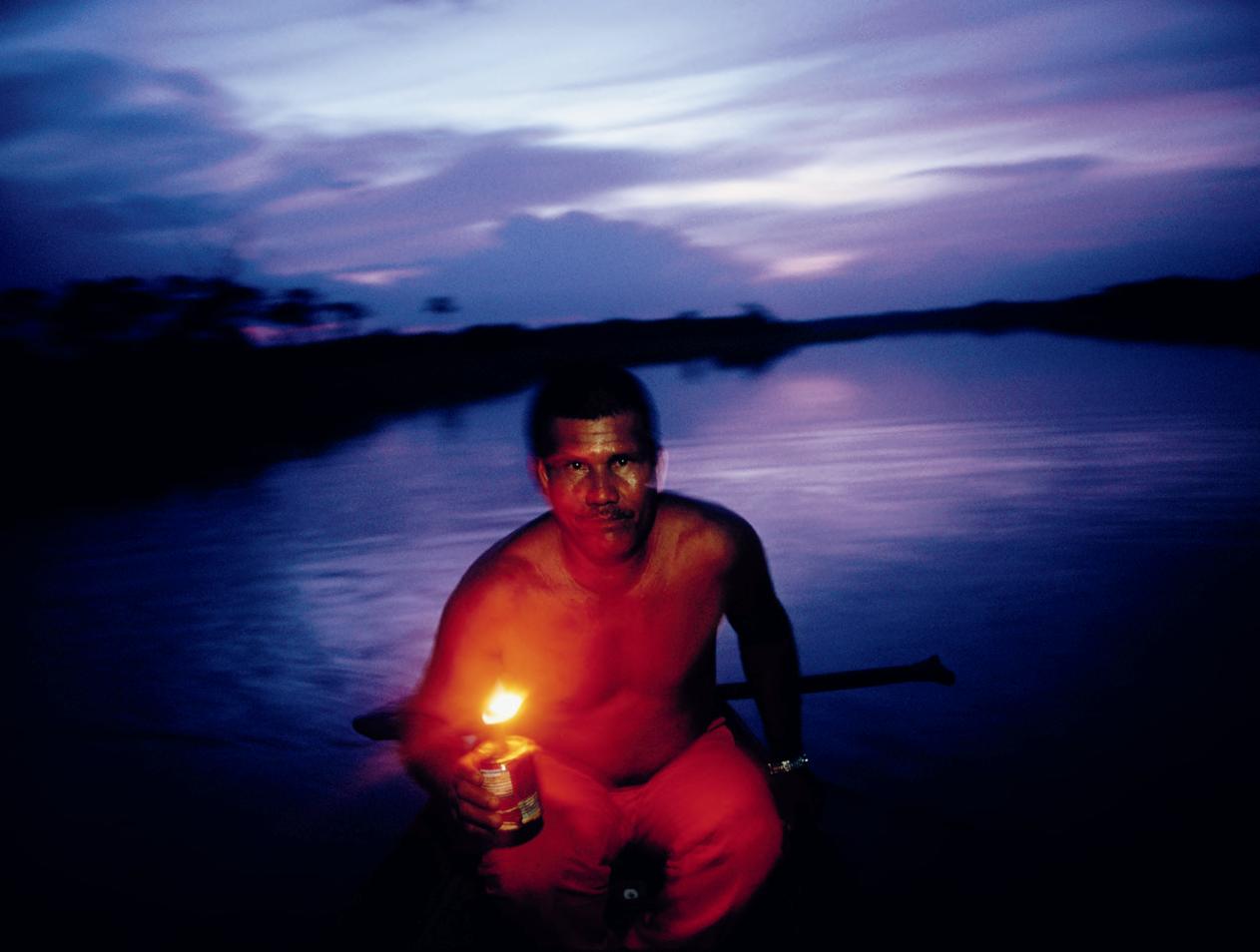
Na Amazônia contemporânea, os caboclos são os grandes guardiões dos sítios arqueológicos. É sobre esses sítios que moram, é nas terras pretas que fazem suas roças, é dali que extraem seus modos de vida e de reprodução. Qualquer política ou ação que vise à valorização ou estudo daquele patrimônio precisa passar por esse reconhecimento. Espero que a beleza do trabalho de Maurício e a possibilidade de divulgá-lo neste livro possam contribuir para tal sensibilização.
Doutor em arqueologia pela Universidade de Indiana (EUA), professor do Museu de Arqueologia e Etnologia da USP e coordenador do Projeto Amazônia Central
It is possible that, in the early sixteenth century, the region was a great mosaic of gardens. They certainly were not gardens as we know them today, made of carefully maintained lawns and flower beds. Those Amazon gardens were “islands” of cultivated areas in different stages of use and neglect; abandoned areas (old cultivated plots or villages, opened by fi re and polished-stone axes, full of fruit-bearing and other economically important species); trails, paths or roads that crossed the forest and led from one village to another; and the villages themselves, some of them large, with hundreds of years of continuous occupation. Such gardens were complemented by the rich aquatic world of rivers, lakes and flood areas. Traveling in this world is an invitation to lose oneself in a labyrinth saturated with water and full of surprises: small channels obstructed by fallen trunks may lead to lakes that open suddenly and announce themselves to sight in flashes that break the darkness of the flooded forest. It is generally in the high escarpments that fall abruptly in cliffs over those lakes that archaeological sites are found.
It is so, in that grand geographic scale, that archaeology and the work of archaeologists in the region fit themselves. To work with archaeology in the Amazon is a way of getting to know it from the perspective of the landscape; it is realizing that the vastness of the rivers and forests hides a rich history whose meaning we are only starting to decipher.
Maurício de Paiva’s work, in addition to its unique beauty, has the strength of capturing that dimension. Maurício’s pictures show a rich archaeological sensibility: women, men, children, animals, plants, objects and the landscape are alive; they are agents. From the static dimension of the images emerges a tension that is nothing more than the manifestation of life that flows continually, even if frozen in an instant image. That operation, going from a static record to the dynamics of life, is exactly what archaeologists perform in their investigations. What are archaeological sites other than present-day static records of complex and dynamic stories that happened in the past? Maurício, in his own way, produces in images an archaeology of the context of archaeology itself in the Amazon; hence the fortunate choice of this book’s title.
In recent years, I have had the chance to work with Maurício in the field throughout the Amazon. This has enabled me to understand his working method. Although the photographer’s talent in producing strong images cannot be denied, they could only be constructed through the choice of staying for hours or even days at the same place, living together with Caboclos and archaeologists, observing their ways of acting, their relationship with each other, with objects and with nature. It is doubtlessly a work of patience, made without hurry, made up of long waits, inspired in contemplation, just in the Amazon’s way.

Featuring the Caboclos as protagonists of many images was a particularly fortunate choice. Science and the government have traditionally relegated them to secondary roles in the history or the development of policies for the Amazon, as if they were only impure heirs of an authentic past that has been lost. Such a view oversimplifies the deep knowledge the Caboclos have about the geographical and ecological context of the places where they live. The rich paradox of the Caboclo way of life is a mix of modernity and tradition. That way of life arose from the
Amazon’s colonial history, but it was the demand for rubber, propelled by the foreign market, that led migrants from Northeastern Brazil to settle there, starting from the late nineteenth century. When the rubber economic cycles ended, those migrants and their descendants, intermixed with the descendants of the Amerindians who have populated the region for thousands of years, remained occupying the banks of rivers and lakes – the places where, as we have seen, archaeological sites often are.
In the contemporary Amazon, Caboclos are the great guardians of archaeological sites. They live on those sites; it is on the terras pretas that they farm their small fields; it is from there that they take and reproduce their ways of life. Whatever policy or action aiming to value or study those riches must necessarily acknowledge this reality. I hope the beauty of Maurício’s work and the possibility of making it known through this book may contribute to make people more aware of that.
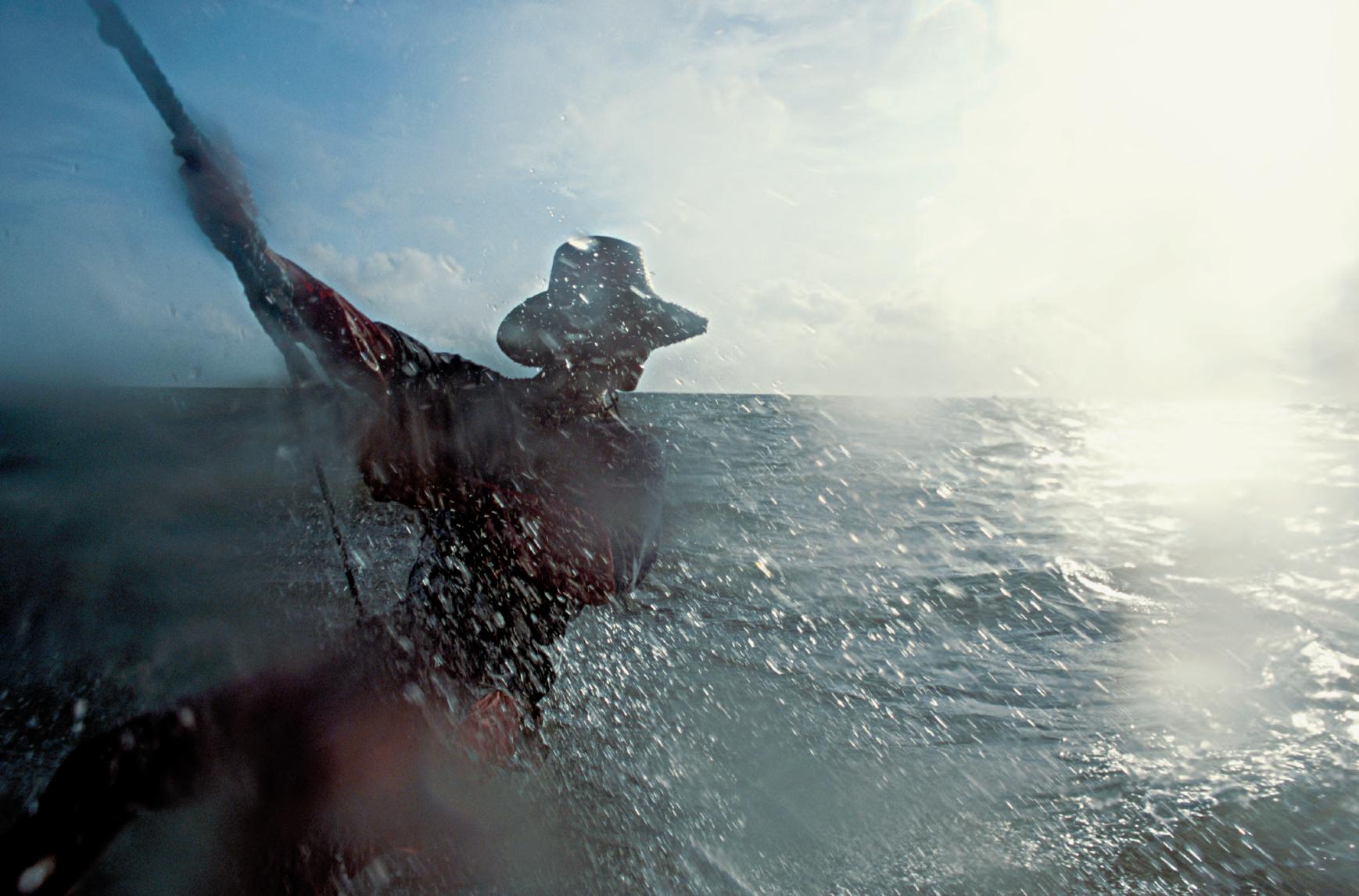
Mais um barco se apronta para sair. Mulheres entram trazendo seus filhos e suas sacolas. E homens, carregando caixas nos ombros. Muita gente embarcando rapidamente, escolhendo o melhor lugar para armar a rede e depositar o aparelho de som, que garantirá a trilha sonora de todo o percurso. Alguns estão voltando para casa, outros vão a um batizado, há quem esteja deixando o lar para encontrar novos destinos. A viagem é longa, são dias pela imensidão do rio. Durante a noite faz muito frio, mas o dia é ensolarado e calmo, como a superfície plana da água. Nas margens, aqui e acolá, algumas casas de madeira, com a pintura azul desbotada, rodeadas de altas palmeiras. E a densa mata, muralha muito verde.
De vez em quando, uma pequena canoa se aproxima do barco. Crianças sobem pela corda. Trazem camarões secos ou açaí batido. Antes que todos possam reparar na mercadoria, voltam para o casco. Não devem se afastar de casa. Um trânsito incessante que se repete a cada dia, levando pessoas de uma grande cidade à outra, parando em outras menores, atravessando as estradas fluviais. Se para mim é uma novidade essa experiência, para o morador da Amazônia são caminhos habituais, rumos que se tomam desde tempos muito remotos, quando outros eram os que dominavam essa paisagem.
Olhar as pequenas casas isoladas e pensar que há quinhentos anos, quando os primeiros europeus trilharam o mesmo caminho em viagem de reconhecimento, boa parte dessa área era bem mais habitada que hoje é uma espécie de volta no tempo. Caminhar por essas
Yet another riverboat gets ready to leave. Women come in, bringing their children and their bags. And men, carrying boxes on their shoulders. Lots of people boarding quickly, choosing the best place to hang their hammocks and lay their sound devices on, to ensure the soundtrack of the whole voyage. Some are coming home; others are going to some baptism ceremony; there are those who are leaving home to find new destinations. The voyage is long, days on the vastness of the river. At night it is very cold, but days are sunny and quiet like the even surface of the water. On the banks, here and there, some wooden houses, with a faded blue paint, surrounded by tall palm trees. And the dense forest, a very green wall.
Once in a while, a little canoe comes close to the boat. Children climb the rope. They bring dried shrimp or mashed açaí fruit. Before all can see their merchandise, they get back to the hull. They must not go far from home. An endless traffic that repeats itself every day, taking people from one city to the other, stopping in small towns, traversing the fluvial roads. While the experience is new for me, for the Amazon dweller these are habitual paths, ways that are taken since very remote times, when other people dominated this landscape.
To look at the small isolated houses and to think that 500 years ago, when the first Europeans traversed the same path in a surveying voyage, a large part of this area was much more populated than today is like a kind of travel back in time. To walk on these banks thousands of years ago might mean finding roads, villages, cultivated plots, unknown
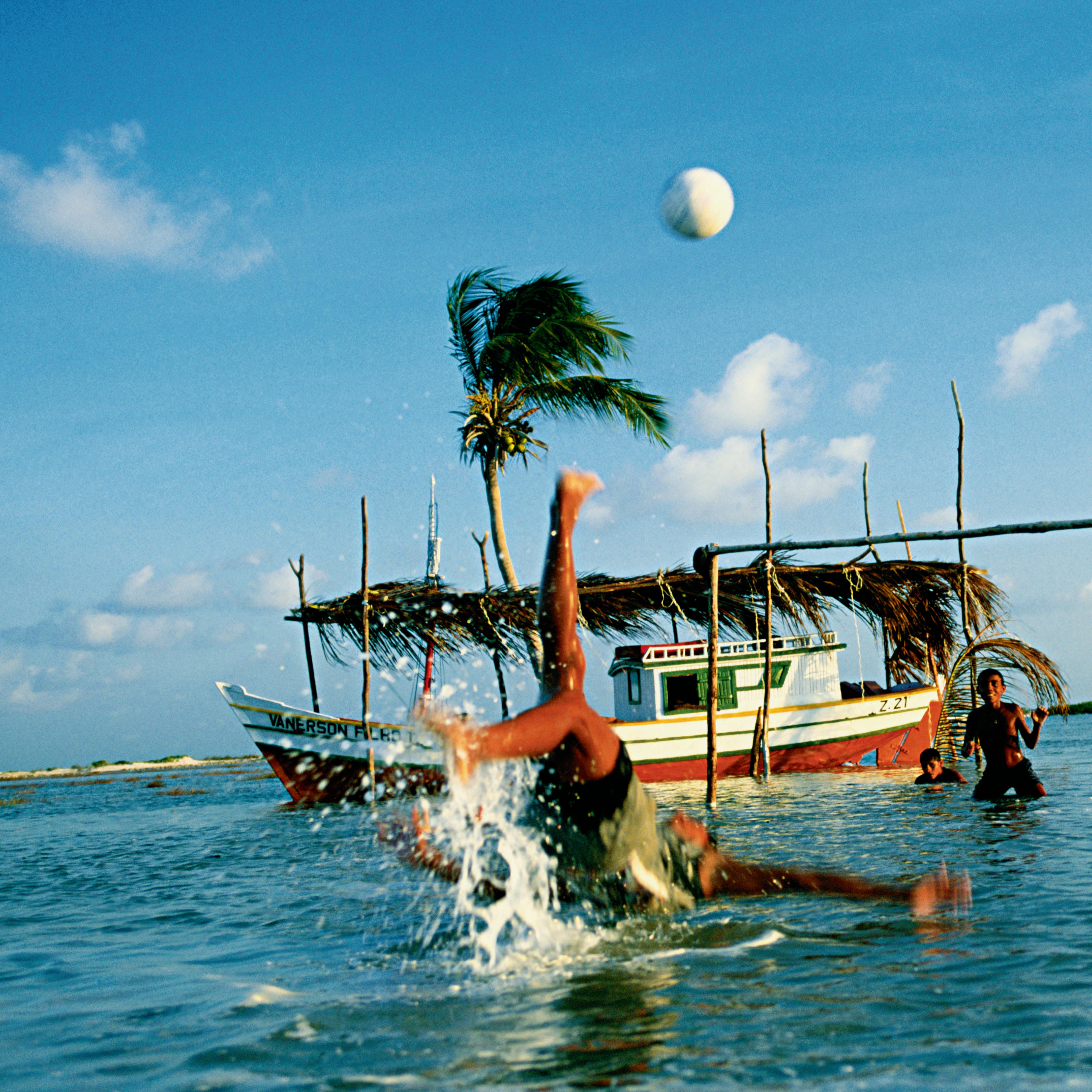
No litoral e nos estuários do Pará e Maranhão, a pesca tradicional sofre forte influência das variações da maré, que apresentam metros de amplitude. Já se identificaram ali sítios com algumas das cerâmicas mais antigas na América do Sul, além de sambaquis em torno de 5500 anos. Ilha de Apeú Salvador, Pará. PP. 20-3, 26-9
In the coast and estuaries of Pará and Maranhão, traditional fishing is under the strong influence of tidal variations, several meters high. Sites have been identified there which yielded some of the oldest ceramic objects in South America, in addition to sambaquis (sand and seashell middens) around 5,500 years old. Apeú Salvador Island, Pará. PP. 20-3, 26-9

margens há milênios podia significar o encontro com estradas, aldeias, plantações, línguas desconhecidas. Adentrar os sertões podia levar a outros povoados, densos agrupamentos situados a vários dias de caminho por terra ou água.
Cada vez que o barco aporta, as pessoas se acotovelam, céleres, para pisar novamente em terra, tão carregadas que estão com suas crianças e seus pertences. Há pressa, sempre há pressa. Próximo ao porto, muitas vezes há também um mercado. Ervas medicinais, frutos da terra, colheitas recentes, peixes de boa carne. E cestos e potes e panos e colares e pulseiras. Analisando vestígios arqueológicos, sabe-se hoje que, unindo toda a Amazônia, bem antes desses atuais mercados, já havia uma complexa rede de intercâmbio comercial. Peixe seco produzido por ribeirinhos, farinha torrada por sertanejos, ferramentas talhadas em rocha, ornamentos dourados que vinham de uma tal aldeia do ouro. Para lá e para cá, havia quem ia e vinha com suas embarcações lotadas de produtos comerciáveis. No estoque fluvial, seguia junto um pouco do saber de cada povo. Um diferente modo de curar uma doença, um trejeito de dança, um desenho na pintura da vasilha. E umas estórias que se espalhavam igarapés adentro, unindo diferentes povos em semelhantes devoções, mostrando que o fio da religiosidade percorria longos caminhos na disseminação do sagrado.
Hoje, os devotos podem estar no Círio de Nazaré, na festa que homenageia santa Rita ou num modesto culto evangélico, como o que presenciei uma noite lá na pequena e pouco conhecida Vila Tessalônica, no arquipélago de Marajó. No dia seguinte, numa construção ao lado, onde funciona um pequeno posto médico, uma funcionária se encarrega de fazer o teste de malária no menino febril, que veio de uma viagem de três horas remadas pelo braço moreno do pai.
Na frente, alheias à presença de qualquer enfermidade, crianças correm divertidas pelo arruado de madeira suspenso.
Mostram-me cacos de cerâmica encontradas à beira do espelhado rio Araramã, vasilhas desenterradas, urnas funerárias. A mãe de uma delas me chama e aponta a “greguinha” –uma urna semienterrada, onde volutas que realmente lembram as gregas me dizem algo que não posso compreender.
Seu José Ferreira, apesar da aparência jovial, é um dos moradores mais antigos do lugar. Sentado num banco sob uma grande árvore que se debruça sobre o rio, ele me esclarece que as urnas serviam para “agasalhar os mortos”. Meu pensamento profano não se entretém por muito tempo imaginando quem tomava agasalho na greguinha. Nessa hora, estou intrigada é com a peça em si, um ícone da cultura marajoara. Os marajoaras, que habitaram todo esse arquipélago paraense entre os anos 450 e 1350, eram exímios ceramistas. No rastro dessas peças, arqueólogos vão estudando os locais que eles ocupavam, suas relações sociais
e políticas, a extensão de seus domínios, a possibilidade de que tivessem uma sociedade hierarquizada, com divisão de trabalho.
Mas é a estética de seus desenhos o que mais diz sobre essa cultura. Num emaranhado de signos, compõem-se narrativas míticas. Entre os traços, há padrões que se repetem em novas combinações a cada peça, um novo conjunto, uma nova estória escrita.
Você leu escrita porque é assim mesmo que se pode definir a iconografia marajoara: uma escrita. Denise Pahl Schaan, arqueóloga que há vários anos estuda tais cerâmicas, defende que se trata realmente de um tipo de código gráfico. Não da forma que se alinham as letras que você está lendo neste papel, já que se tratava não de representações sonoras, mas de representações míticas. Algo talvez muito complexo para a objetividade do nosso pensamento atual.
Pois é… Tanta gente falando de outras culturas pré-colombianas, e de repente alguém nos ensina que, aqui mesmo no Brasil, um grupo indígena chegou a um grau de sofisticação tão elevado que possuía sua própria escrita. Feito que nem os cultuados incas ou seus antecessores mochicas alcançaram. Quantas coisas mais os marajoaras dominavam que nem sequer imaginamos?
E eles não foram os únicos a imprimir suas crenças em cerâmica. De Marajó, na foz do Amazonas, ao limiar dos Andes, outros povos desenvolveram técnicas cerâmicas sofisticadas, inclusive as policromas, recobertas com pinturas em preto e vermelho sobre superfície tingida de branco. Talvez não tivessem escrita própria, ou não sejamos capazes de compreendê-la como tal, mas estão ali seus mitos, suas devoções, suas estórias do dia e da noite. Para o bem viver, generosos pratos de comida que serviam dezenas de pessoas de uma só vez, recipientes para substâncias alucinógenas destinadas a rituais xamânicos, grandes vasilhas para armazenar bebidas. Para o bem morrer, urnas funerárias de diversos feitios. Algumas, em bojudas formas, abrigavam corpos inteiros, acomodados com alguns pertences. Outras, onde iam apenas os ossos, o formato repetia a figura humana. Mulheres com pontudos peitinhos de barro, homens sentados em banquinhos. Interessantes figuras ornadas com suas joias e pinturas, representantes de pessoas que há muito deixaram de pisar esses chãos.
Se os pesquisadores ocupam-se por dias seguidos com um caco de cerâmica tentando extrair dele confissões seculares, os moradores igualmente criam suas próprias teorias. Na comunidade de Santa Rita da Valéria, em Parintins, Amazonas, mora Geraldo França, experiente artesão que faz objetos de madeira para vender a ocasionais turistas. Acostumado à presença de pesquisadores, questiona com sutil sabedoria: “É a mão de Deus? Assim eu vejo estas cerâmicas, como a mão de Deus”. Talvez não o Deus a quem ele faz suas preces diariamente, mas outros deuses, que se faziam gente para tomar as mãos de artesãos habilidosos e inscrever no barro sagrado sua mensagem milenar.
languages. To go further inland could lead to other settlements, dense groupings several days away on foot or by boat.
Now, every time the riverboat docks, people cram themselves speedily to tread on land again, so overloaded are they with their children and their belongings. There is hurry, there is always hurry. Next to the mooring, there is often also a market. Medicinal herbs, local fruit, recent crops, good fish. And baskets, pots, fabrics, collars and wristbands. By analyzing archaeological vestiges, it is now known that well before the current markets there was already a complex trade network. Dried fish produced by riverbank dwellers, toasted manioc flour made by inland people, tools carved in stone, golden ornaments that came from a so-called “village of gold.” There were those who came and went back and forth with their vessels full of trading goods. In the riverine inventory, something of each people’s wisdom went along: a different way of curing a disease, a dance mannerism, a pattern in a pot’s painting, and some stories that were spread inland on the side streams, uniting different peoples in similar devotions, showing that the thread of religiousness fared long ways disseminating the sacred.
Today devouts may be at Belém’s feast of Our Lady of Nazareth, or at the feast in honor of Saint Rita, or in a modest Protestant cult, such as the one I witnessed one night in small and little known Vila Tessalônica, in the Marajó archipelago. The next day, in a neighboring building where a small clinic operates, a female civil servant is testing a febrile boy for malaria; he came on a three-hour canoe journey, with his father’s darkskinned arms rowing all the way.
Ahead, oblivious to any infirmity, amused children run on the suspended wooden paths.
They show me ceramic shards found on the bank of the mirror-like Araramã River, unearthed pots, funeral urns. One of the children’s mother calls me and points to the greguinha (“the little Greek one”), a half-unearthed urn where curved traces that really look Greek tell me something I cannot understand.
José Ferreira, in spite of his jovial appearance, is one of the place’s oldest inhabitants. Sitting on a bench under a large tree that bends itself over the river, he tells me that the urns’ purpose was to “dress the dead warm.” My profane thought does not entertain itself for long imagining who sheltered oneself from the cold inside the greguinha. At this time, I am really intrigued by the piece itself, an icon of the Marajoara culture. The Marajoara, who inhabited that entire archipelago in Pará in the years AD 450-1350, were accomplished potters. On the trail of their pieces, archaeologists keep studying the places they occupied, their social and political relationships, the extension of their domain, the possibility that they may have had a hierarchical society with a division of work.
But it is their drawings’ aesthetics that tells more about their culture. In a complex pattern of intertwined signs, mythical narratives are told. Between the traces, there are patterns that repeat themselves in new combinations in each piece – a new set, a new written story.
You have read “written” because this is exactly how one can define Marajoara iconography: a system of writing. Denise Pahl Schaan, an archaeologist who has been studying such ceramic pieces for several years, maintains that it is really a kind of graphical code. Not in the same way that letters are aligned on the paper you are reading, since those were not phonological representations, but mythical ones. Something maybe too complex for our current, objective way of thinking.
Here we are… So many people talking about other pre-Columbian cultures, and suddenly someone teaches us that right here in Brazil an indigenous group achieved such a high degree of sophistication that it had its own writing, a feat achieved by neither the revered Incas nor their Mochica predecessors. How much more the Marajoara mastered that we cannot even imagine?
And they were not the only ones to imprint their beliefs on ceramic. From Marajó Island, on the mouth of the Amazon River, to the edge of the Andes, other peoples developed sophisticated techniques with ceramic, including the polychromatic one, covered with black and red paintings on a white-coated surface. Maybe they did not have their own writing, or we are unable to understand it as such, but their myths are there, as are their devotions, their tales of the day and the night. For living well, generous food plates that served dozens of people at once, recipients for hallucinogenic substances meant for shamanic rituals, large vessels to store beverages. For dying well, funeral urns in several shapes. Some of those urns were potbellied and contained whole bodies, accommodated with some belongings. Others, wherein only the bones went, repeated the human shape: women with pointed little clay breasts, men sitting on little benches; interesting figures ornated with their jewels and paintings, representing people who stopped treading this ground a long time ago.
While researches busy themselves for days in a row with a shard of ceramic, trying to extract centuries-old confessions from it, the current inhabitants of the Amazon create their own theories. In the settlement of Santa Rita da Valéria, in Parintins, Amazonas, lives Geraldo França, an experienced artisan who makes wooden objects to sell to occasional tourists. Accustomed to the researchers’ presence, he questions with subtle wisdom: “Is it the hand of God? This is how I see these ceramic pieces, as the hand of God.” Perhaps not the God to whom he prays every day, but other gods, who made themselves human to take the hands of skilled craftspeople and inscribe in the sacred clay their thousands-years-old messages.





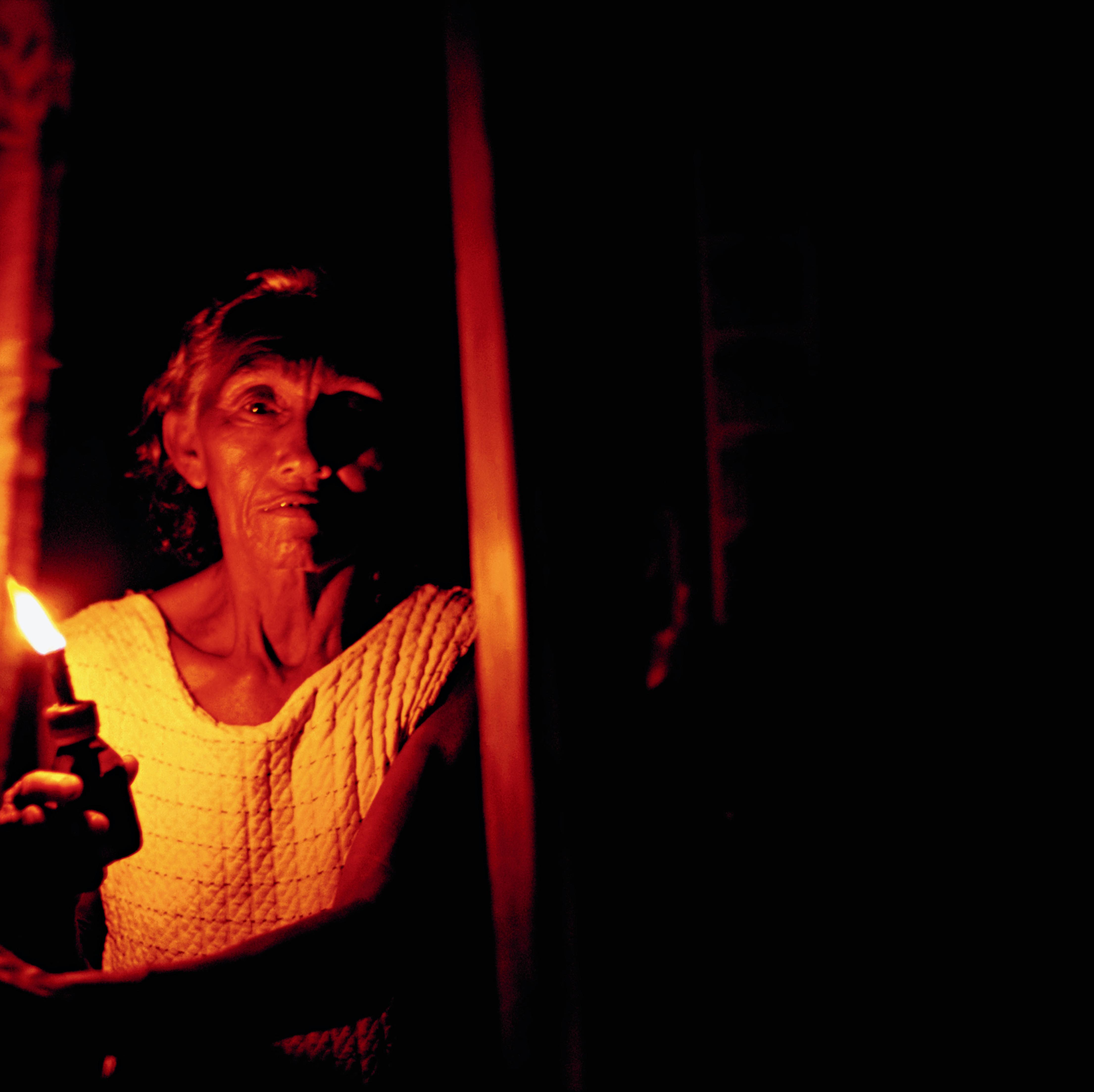



“Eu pescava muito, tudo quanto era peixe – tracajá, curimatã, tambaqui. Era muito. Tucunaré, surubim… Mas, olhe, eu nunca arpoei um peixe-boi neste lago; tem uns aí que escuta até cuspe n’água. […] Numa viagem, eu estava pescando pirarucu no buraco do Caju, vi um focinho, e a bocarra boiô pra mim, de uns três ou quatro metros. Eu gritei, e arpoemos pra descourar e tirar a manta dele. Na boca da noite, saímos na beira do lago comprido, o buritizal nos agasalhando pra outra banda. ‘Aquele fogo ali é a Cobra Grande’, eu disse pro meu parceiro do casco. Ela vinha baixando, passou perto de nós por arriba d’água, deslizando com fogo ou ao menos no feixe. Não vimos a cobra de verdade – mas o fogo sim!”

Nelson Neris, Santa Rita do Lago da Valéria, Parintins, Amazonas
“I used to fish a lot, all kinds of fish – tracajá, curimatã, tambaqui. It was a lot – tucunaré, surubim… But I’ve never been able to harpoon a manatee in this lagoon; there are some manatees out there that can hear even if one spits into the water. […] On a trip, I was fishing for arapaima at Caju Hole when I saw a muzzle and that big mouth mooed at me, some three or four meters away. I screamed, and we harpooned it to skin it and get its pelt. In the early evening, we went out on the edge of the long lake, the buriti palms guiding us to the other side. ‘That fire out there is the Big Snake, the fiery one,’ I said to my boat mate. It came slowly downwards and passed near us over the water, gliding with fire or at least a beam of light. We didn’t see the actual snake – but we did see the fire!”
Nelson Neris, Santa Rita do Lago da Valéria, Parintins, Amazonas

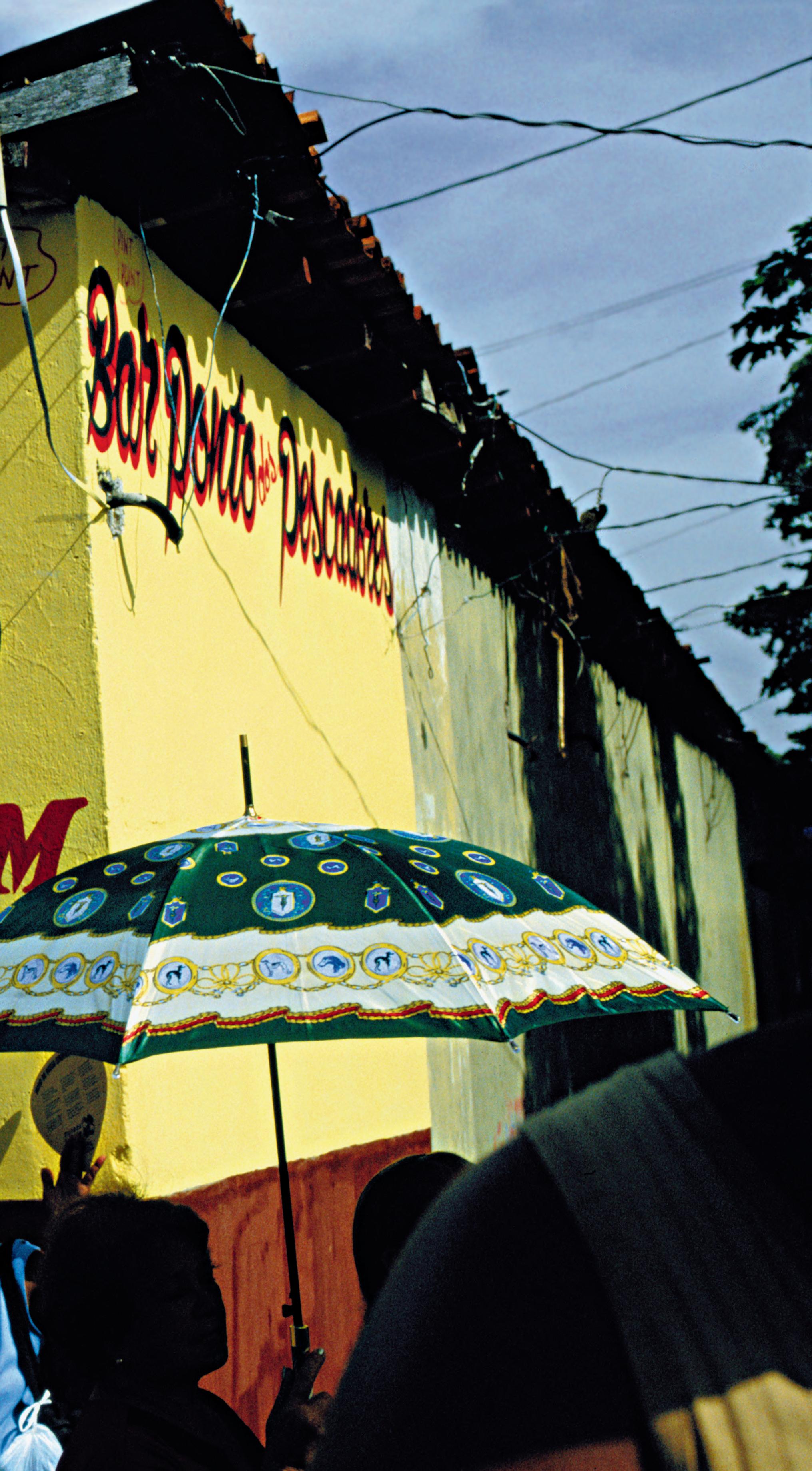



Comunidade Santa Júlia, rio Jurupari, ilha de Marajó O trapiche por onde o menino Comunidade Santa Júlia, rio Jurupari, ilha de Marajó. O por onde o menino caminha com sua lamparina ao crepúsculo foi construído sobre um aterro em que, há caminha com sua ao foi construído sobre um aterro em que, há 1600 anos, viviam os marajoaras 1600 anos, viviam os
Settlement of Santa Júlia, on the Jurupari River, Marajó Island The wooden path the Settlement of Santa Júlia, on the River, Island. The wooden the boy walks with his lamp at twilight was built on a landfill where the Marajoara lived walks with his at was built on a landfill where the lived 1,600 years ago years ago a n c i e n t a m a z o n • ancient amazon • 4 1 41


“E veio a chuva, a água e o aguaceiro. E veio o subterrâneo, vem enterrando e mostrando a lama, enterrando!
[…] Mas, mesmo sem você cavar, afloram aquelas cabecinhas todas que as crianças trazem.”
Um morador da comunidade de Bete Sêmis, rio Solimões, Amazonas
“And then came the rain, the water, the downpour. And there pops the underground, burying and showing the mud! […] But even if you don’t dig, all those little heads appear, and the children bring them.”
A dweller of the settlement of Bete Sêmis, Solimões River, Amazonas
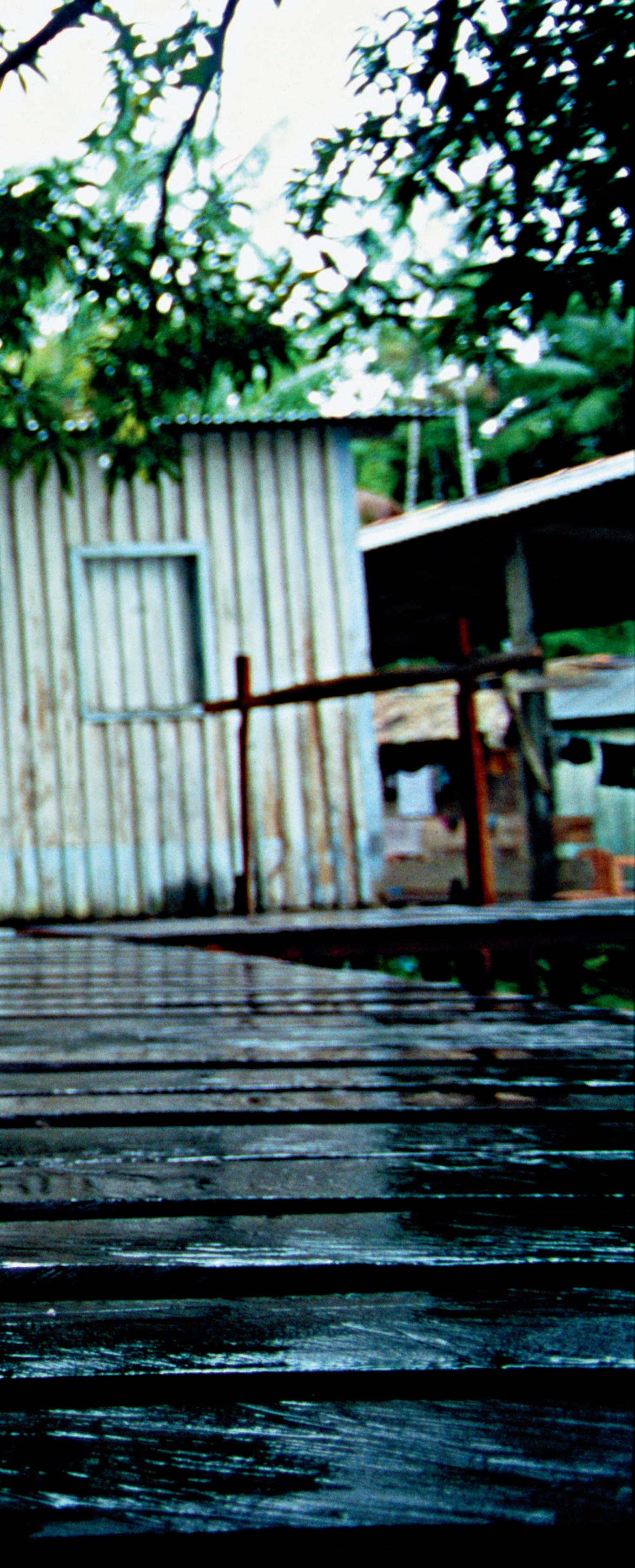
Caboclo em casa da comunidade de Sampaio, Autazes, Amazonas Caboclo em casa da comunidade de Amazonas Caboclo in a house of the settlement of Sampaio, Autazes, Amazonas Caboclo in a house of the settlement of Amazonas

Aqui e ali, esses objetos vão nos contando histórias dessas gentes, povoadores de um imenso território, num caminho temporal que se estende ao passado em mais de dez milênios, sucedendo-se uns aos outros. Até hoje, o caboclo ocupa e revive um modelo cotidiano que não difere muito do que seguiam os antepassados. Em cada sítio arqueológico, os vestígios remotos. Nos seus entornos, os caboclos de hoje.
Corre à boca miúda que, nessa relação, antropólogos preferem não usar a palavra herança . É fato: caboclos são os filhos mestiços de remanescentes indígenas com nordestinos atraídos pela borracha. Mas e esses habitantes do passado? É provável que, com a chegada dos colonizadores europeus, tenham migrado para outros territórios, sido dizimados por epidemias ou assimilados pelas missões religiosas e se desagregado socialmente. O fio dessa meada se perdeu. Mas, ora, não se pode olhar o caboclo de hoje sem perceber quanto ele é a continuidade de um cotidiano milenar. Se não há uma herança genética, material, há a herança dos costumes da terra.
Ainda saem em grupos de homens para espreita e caça de animais da floresta. Ainda pescam, seja a piranha para um breve caldo, seja o pirarucu que alimentará famílias inteiras. Ainda apanham argila nas beiras para modelar seus potes e trançam cestos de cipó, que usam na coleta de castanhas e frutas. E a mandioca reina absoluta, beneficiada em arcaicos fornos de barro, nas toscas casas de farinha. O sagrado atual já não se
Here and there, such objects keep telling us stories of those people, settlers of an immense territory, in a time path that extends itself to a past of over 10,000 years, replacing each other in succession. Even today, Caboclos occupy the place and relive a day-to-day existence that is not much different from what their ancestors lived. In each archaeological site, the remote vestiges. In the sites’ surroundings, today’s Caboclos.
It is widely rumored that anthropologists, when referring to that relationship, would rather not use the word “heritage”. Granted, Caboclos are the mestizo descendants of remaining indigenous people mixed with Northeasterners attracted by rubber. But what about the inhabitants from the past? It is likely that, when European colonizers arrived, those people migrated to other territories, were decimated by epidemics or assimilated by the religious missions, and became socially disjointed. The thread has been lost. But, well, one cannot look at today’s Caboclo without realizing how much he represents the continuity of a daily routine of thousands of years. If there is not a genetic, material heritage, there is the heritage of the customs of the land.
Caboclos still go out in groups of men to watch and hunt animals in the forest. They still fish, whether it is a piranha for a quick broth or an arapaima that will feed whole families. They still gather clay on the river banks to shape their pottery and weave vines into baskets, which they use to collect nuts and fruits. And manioc reigns absolute,
“Estão claras as relações a longa distância que ocorriam há milênios – expansões do baixo rio Orinoco, na Venezuela; do Napo; do norte da Amazônia; das Guianas; uma expansão humana que colonizou o Caribe […]. As paisagens foram transformadas pelas ocupações humanas como um pacote tecnológico de eco-história. A vida não é só manejo econômico: hoje as crianças caboclas brincam nos buracos de terra; a casa de farinha está arraigada na agricultura anterior. Eu diria transformação antrópica, porque houve ação do homem. É o que aparece aqui, no perfil da escavação; vemos que isso fica grudado nas sucessivas ocupações.”
Manuel Arroyo, arqueólogo chileno“The long-distance relationships that happened thousands of years ago are clear – expansions from the lower Orinoco River in Venezuela, from the Napo, from the northern Guyanas, a human expansion that colonized the Caribbean […]. Landscapes were transformed by human occupation like a technological package of ecohistory. Life is not only economic cultivation: today the Caboclo children play in the holes the ancients left in the earth; the manioc meal engine has its roots in earlier agriculture. I would call it anthropic transformation, because there was human action. This is what appears here in the excavation profile; we see that it stays sticked to successive occupations.”
 Manuel Arroyo, Chilean archaeologist
Manuel Arroyo, Chilean archaeologist
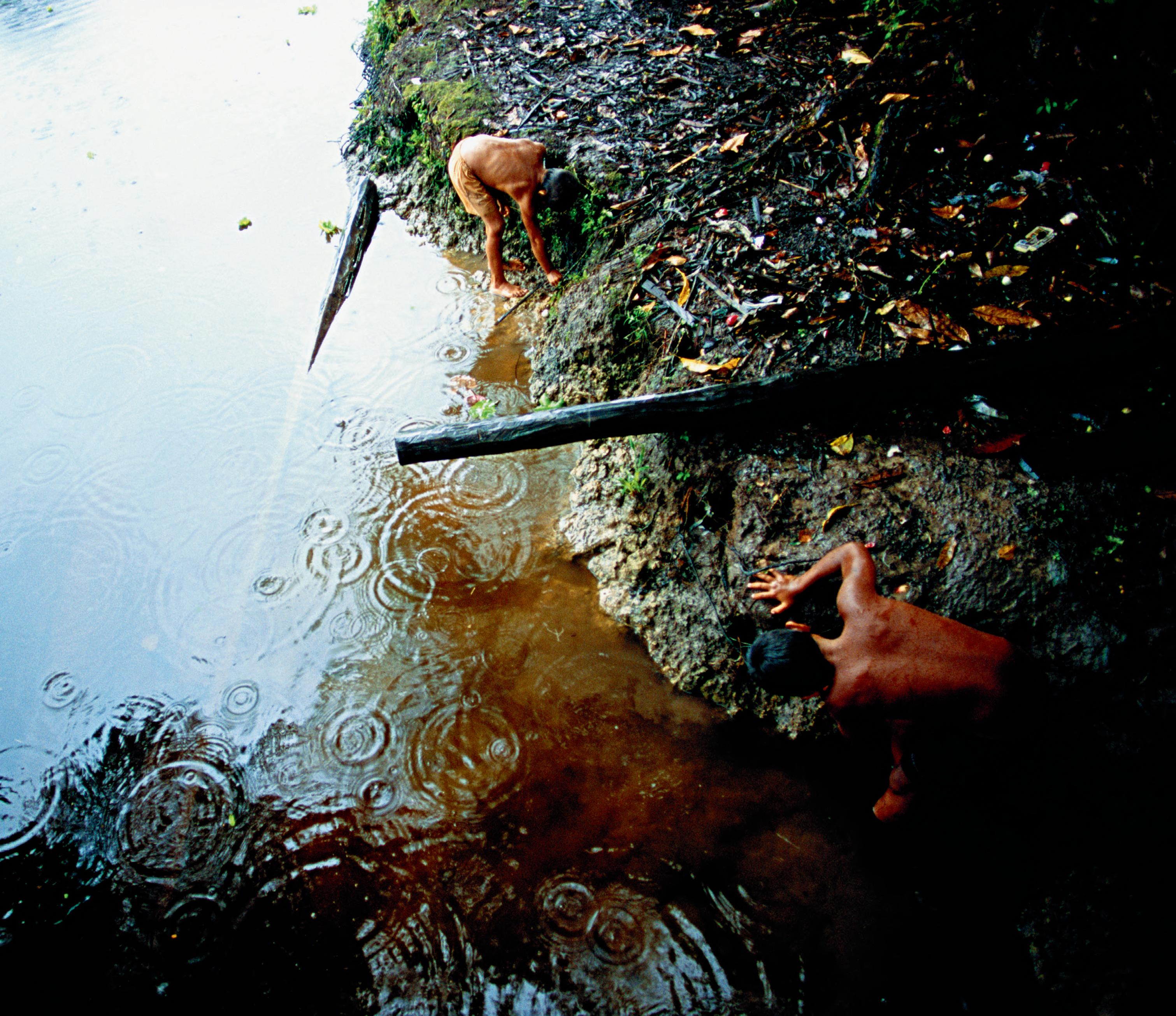
apresenta vestido de híbrido humano e animal; está mesmo é numa pequena igreja de madeira, ora evangélica, ora católica. Mas as festas, estas, sim, continuam a manifestar alegria e fé. Já não adoram a Cobra Grande. Mas mantêm o respeito pelas grandes cobras. Esse homem é o mesmo que esbarra, quando capina a roça fincada na fértil terra preta, em fragmentos de cerâmica arqueológica. É, novamente, o homem ocupando seu lugar no ambiente amazônico.
O que separa esses dois mundos é a direção para onde voltamos nosso olhar: do chão à cabeleira do pé de açaí, onde pode haver um menino agarrado em busca de um cacho de frutos pretinhos, é domínio do presente. Do chão para baixo, onde estão enterrados restos de alimento, objetos esquecidos, corpos descarnados, reside o passado. Se olhamos para cima, vemos os que transitam na liberdade do ar. Para baixo, aprisionados no solo, camada sob camada, pedaços congelados do passado. Dois cotidianos que se espelham: um em constante movimento, outro estacionado na terra.
Os arqueólogos vão lá e raspam suas espátulas no chão que faz a tênue fronteira. Com suas ferramentas, vão desbastando centímetros de terra, procurando a parte oculta do espelho. Mas também estão interessados em conhecer os que ficam por cima, para compreender melhor como é essa relação. Conversam, achegam-se na hora do café, ouvem estórias de visagens, pegam uma carona de canoa.
Numa viagem há alguns anos, estive também abrigada entre esses moradores por alguns dias. Um episódio foi especialmente marcante. Depois de uma cansativa e frustrada caminhada pela mata em busca de um suposto sítio arqueológico, voltamos enfim à margem onde tínhamos aportado. Apenas para descobrir que a maré havia secado. Entre nós e nosso barco: lama. No começo, até que não foi tão difícil. Bastava levantar a perna bem alto, dar um passo largo, afundar o pé novamente. Mas os passos iam ficando cada vez mais pesados, e o sol mais ardido, e a lama mais funda. Quando ela já tinha engolido metade do corpo e o barco ainda estava a uns cinquenta metros de distância, percebi que a vida nunca havia me parecido tão difícil (nessa época, eu ainda não era mãe). Veio o desespero, a birrenta vontade de desistir e dormir na mata, à espera da
cheia da maré. Mas uma olhada rápida nos mostrou que a margem, naquela altura, já estava tão distante quanto a voadeira. Ir em frente era a única opção. O que aconteceu dali em diante não sou capaz de explicar. Um impulso inesperado, um segundo fôlego, um não-sei-quê de força. E já estávamos exaustos dentro do barco, com alguns rapazes caboclos que nos olhavam sem entender e um pequeno jacaré, amordaçado, que não teve a mesma sorte de safar-se.
Algumas horas depois, já tranquilos, compartilhamos o jantar com uma família ribeirinha, sem vizinhos à vista. A casa é de madeira, construída sobre pilares, para a passagem da água nos tempos de cheia. Em cima da mesa, a luz fraca de uma lamparina compete com as chamas do fogão a lenha, onde a mulher prepara graúdos camarões, tirados há pouco da água doce, que vai servindo a todos (o jacaré já era).
Estamos bem em frente ao gigante Amazonas, no ponto em que ele se casa com o oceano Atlântico, e cercados pela mata densa, distante muitas horas de barco da cidade mais próxima. À porta da casa, no alto da escada que leva ao solo, posso observar as crianças que se deliciam barulhentas e risonhas com o banquete singelo e o escuro absoluto que nos rodeia. Experimento compreender como é a vida dessas pessoas, tão isoladas do resto do mundo e, ao mesmo tempo, tão senhoras em sua solidão. Numa noite tão escura como essa, de pouca lua e muitas estrelas, não é difícil vislumbrar fantasmas de outras eras, visagens que caminham pela mata protegendo seus espaços sagrados. Mas não há medo. Só uma sensação de que a solidão é ilusória, de que, por todos os lados, guardiões espreitam. Vejo, aqui, apenas uma família de pai-mãe-e-filhos. Mas quem pode afirmar quantos pés de gente passaram por esse mesmo chão nos últimos milhares de anos?
Quem foram esses antigos habitantes do Brasil? Com que nomes batizavam seus filhos? Que mensagens inscreveram no barro cozido dessas urnas? Segredos guardados por tantos anos, enterrados numa terra que hoje é pisada pelos pés de outros homens. Outros homens que têm, por sua vez, seus próprios segredos para zelar.

processed in archaic clay ovens to make meal. Today’s sacred no longer presents itself dressed as a hybrid of human and animal; it is actually in a little wooden church, sometimes Protestant (mostly Pentecostal), sometimes Catholic. But the feasts do keep expressing joy and faith. They no longer adore the Big Snake, but they still respect large snakes. Those people are the same who stumbles upon fragments of archaeological ceramic when clearing the farming field created on the fertile terra preta . Again, people occupy their place in the Amazon’s environment.
What separates those two worlds is the direction toward which we turn our look: from the ground to the head of the açaí tree, where a boy may be clinging looking for a bunch of small black fruits, that is the domain of the present. From the ground downwards, where food remains, forgotten objects and wasted bodies are buried, that is where the past lives. If we look upwards, we see those who move in the freedom of the air. Downwards, trapped in layer upon layer of soil, are frozen pieces of the past. Two realities mirroring each other: one in constant motion, the other stationary inside the earth.
Archaeologists go there and scrape their spatulas on a ground that functions as the tenuous boundary. With their tools, they scrape off centimeters of dirt, looking for the hidden part of the mirror. But they are also interested in getting to know those who stay above ground, in order to better understand that relationship. They talk, come near at coffee time, listen to ghost stories, take a lift on a canoe.
On a trip a few years ago, I was hosted by those locals for some days as well. There was a particularly remarkable episode. After a tiresome and futile walk in the forest in search of a supposed archaeological site, we returned at last to the river bank where we had landed, only to find out that the tide had ebbed. Between us and our boat, there was only mud. At first, it was not that difficult: it sufficed to raise the leg quite high, make a long step, sink the foot again. But the steps were getting heavier, the sun burned stronger, the mud was getting deeper. When it had already swallowed half my body and the boat was still about fifty meters away, I realized that life had never seemed so difficult to me (at that time, I was not a mother yet). There came despair,

the whimsical willingness to give up and sleep in the forest, waiting for the turn of the tide. But a quick glance showed us that by then the bank was already as far away as the boat. Going ahead was the only choice. What happened afterwards I cannot explain. An unexpected impulse, a second breath, a bout of strength for no apparent reason, and soon we were inside the boat. We were exhausted, with some Caboclo young men who looked at us without understanding and a small gagged caiman that did not have the same luck to save itself.
A few hours later, having already calmed down, we shared dinner with a riverside family, with no neighbors within sight. It was a wooden house, built on pillars to allow water to pass in the high-water season. On the table, the weak light of a night lamp competed with the flames of the wood-fueled stove, where the woman prepared large prawns taken shortly earlier from the fresh water, and she proceeded to serve them to everyone (the caiman had long been finished).
We were right in front of the mighty Amazon River, at the point where it joins the Atlantic Ocean, and were surrounded by the thick forest, several hours away by boat from the nearest town. On the doorway, on top of the stairs that led to the ground, I could watch the children, who delighted themselves, noisy and smiling, with the simple banquet and the absolute darkness that surrounded us. I tried to understand how those people lived, so isolated from the rest of the world and, at the same time, so mastering in their solitude. On such a dark night as that one, with little moonlight and lots of stars, it is not difficult to have a glimpse of ghosts from other ages, visages that walk through the forest protecting their sacred spaces. But there was no fear. There was only a feeling that solitude is an illusion, that guardians watch from all sides. I saw just a family of father, mother and children there. But who can tell how many human feet trod that same ground in the last thousands of years?
Who were those ancient inhabitants of Brazil? What were the names they called their children? What messages did they inscribe in those urns’ baked clay? Secrets kept for so many years, buried in an earth that is now trodden by the feet of other men – who, in their turn, have their own secrets to care for.

O p r o f e s s o r L i n o , a u t o d i d a t a e m a r q u e o l o g i a , d e b r u ç a s e s o b r e f r a g m e n t o s d e u r n a s f u n e r á r i a s a n t r o p o m o r f a s m a r a j o a r a s
O professor Lino, autodidata em arqueologia, debruça-se sobre fragmentos de urnas funerárias antropomorfas marajoaras e r e s g u a r d a o a c e r v o d o M u s e u d o M a r a j ó , e m C a c h o e i r a d o A r a r i , c r i a d o e m 1 9 8 3 p e l o p a d r e G i o v a n n i G a l l o , p r e c u r s o r d a e resguarda o acervo do Museu do Marajó, em Cachoeira do Arari, criado em 1983 pelo padre Giovanni Gallo, precursor da valorização da história ribeirinha da história ribeirinha

Master Lino, a self taught archaeologist, leans over fragments of anthropomorphic Marajoara funerary urns and takes care of the Master Lino, a self-taught leans over of urns and takes care of the Museu do Marajó, created in Cachoeira do Arari in 1983 by Father Giovanni Gallo, who pioneered riverside historiography Museu do created in Cachoeira do Arari in 1983 Father Giovanni who riverside
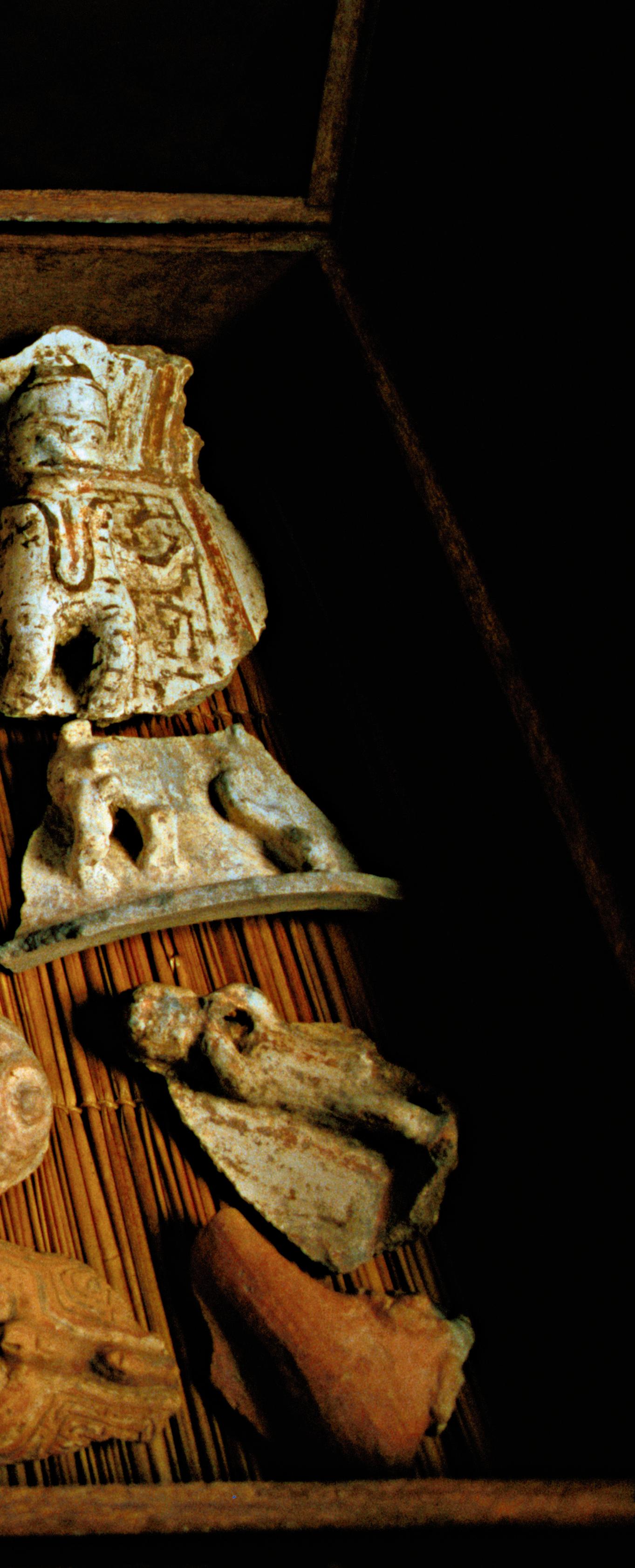
Moradores de fazenda junto ao rio Amapá Grande observam um machado de pedra polida, encontrado no sítio arqueológico do Retiro do Padre, da fase aristé, séculos 4o-16 d. C. Farm dwellers along the Amapá Grande River observe a polished-stone ax, found at the Retiro do Padre archaeological site, from the Aristé phase, fourth to sixteenth century AD


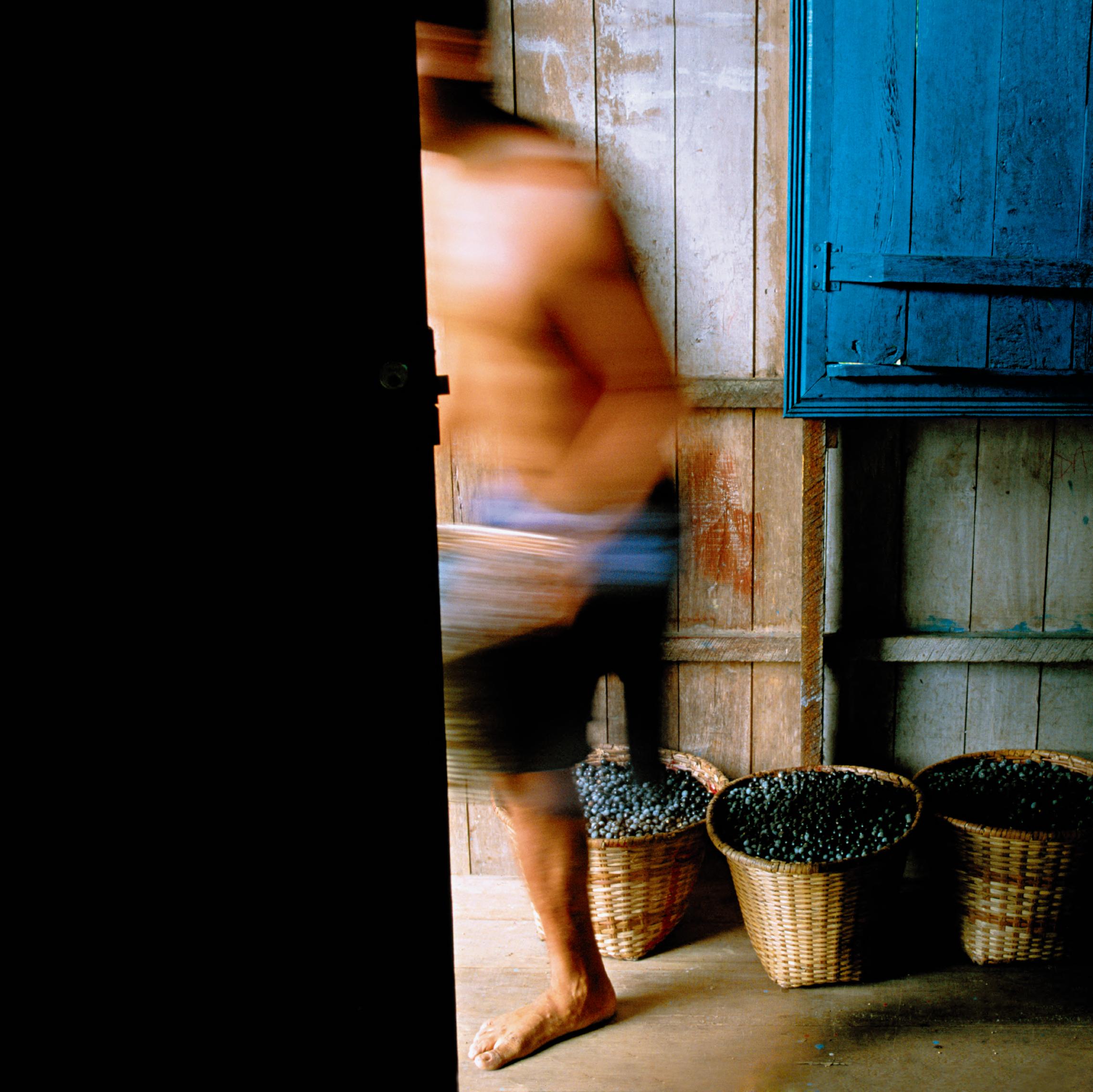
Uma das contribuições dos ameríndios à humanidade foi terem domesticado plantas que hoje ainda se consomem. Na história dos horticultores amazônicos, o cultivo de raízes começou por volta de 5000 AP (antes do presente). Vêm de longe práticas de manejo utilizadas no século 21, de que são exemplo a pesca, a caça de pequenos animais e a coleta de frutos de palmeiras como o açaí (ferro, cálcio e fósforo) e a pupunha (proteína e vitaminas). PP. 54-9
One of the Amerindians’ contributions to mankind was the domestication of plants which are still consumed today. In the history of Amazon horticulturists, the cultivation of roots started around 5000 BP (before present). Cultivation practices used in the 21st century hark back to ancient times; for instance, fishing, hunting small animals and collecting palm tree fruit such as açaí (which provides iron, calcium and phosphorus) and pupunha (protein and vitamins). PP. 54-9



“A criatividade dos antigos é de admirar; faziam as peças sem defeito, com aquelas formas de homem, deuses e animal. Hoje, o caboclo falece e a gente compra o caixão como se queira na hora – tão rápido! Será que no passado, quando morriam, os indígenas já tinham alguma urna mortuária pronta, tão bem-feita, depressa assim, pra hora do enterramento? Eu tenho pra mim que não: já deviam ter uma fórmula pronta, modelada, tipo cada aldeia uma.”
Geraldo França, artesão de Parintins, Amazonas
“The ancient people’s creativity is admirable; they made flawless pieces, with those shapes of men, gods and animals. Today, a man dies and we buy the coffin the way we want it at the same time – so fast! I wonder, in the past did the indigenous people have a funerary urn ready, so well made, so fast for the burial? I believe they didn’t: they must have had a ready, modeled formula, like one for every tribe.”
Geraldo França, an artisan in Parintins, Amazonas
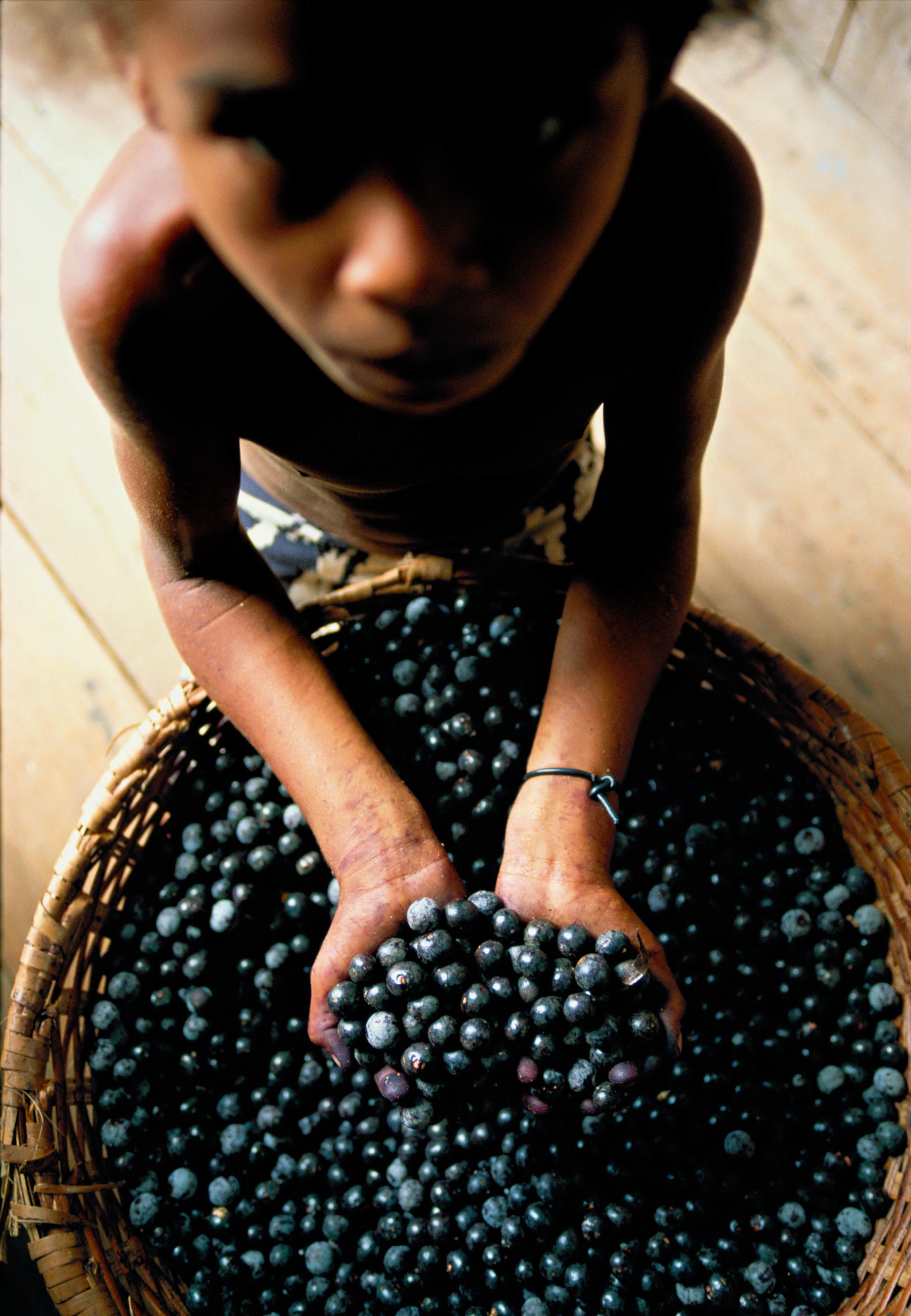
Na bacia amazônica, complexas sociedades hierárquicas pré-coloniais – os cacicados – expandiram-se estabelecendo longas redes regionais de troca. O fluxo de bens de prestígio integrava mercados em que se trocavam matérias-primas, excedentes agrícolas, cerâmica e machados de pedra. O maior entreposto latino-americano, o mercado Ver-o-Peso, em Belém do Pará, existe desde 1688 PP 60-1, 64-5

In the Amazon Basin, complex pre-colonial hierarchical societies – the cacicados – expanded by establishing long regional exchange networks. The flow of prestige goods integrated markets where raw materials, agricultural surpluses, ceramic objects and stone axes were exchanged. The largest entrepôt in Latin America, the Ver-o-Peso market in Belém, Pará, exists since 1688 PP 60-1, 64-5





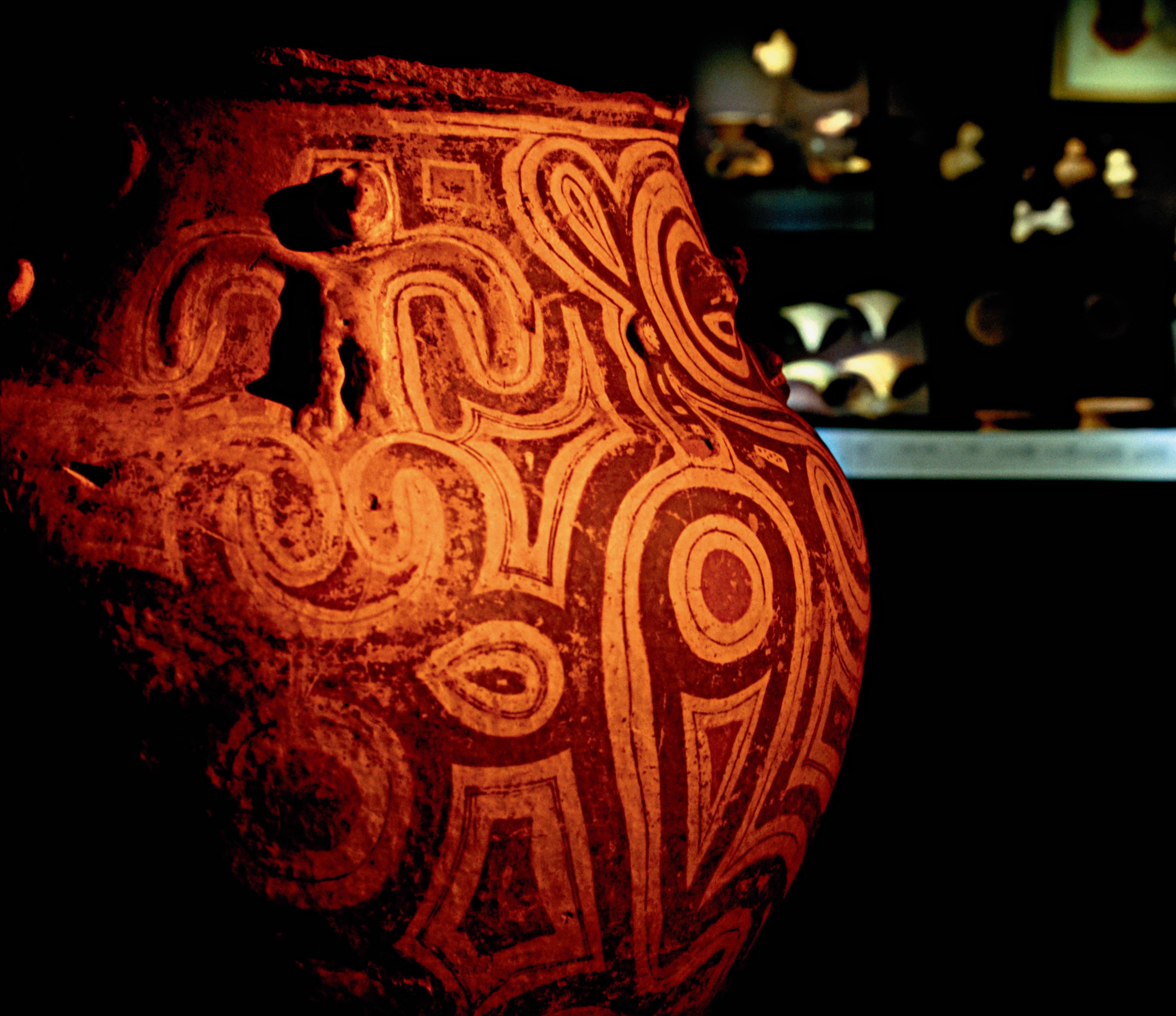
Ao lado: urna funerária policrômica da fase marajoara Representação híbrida de ser humano e coruja A policromia é encontrada em Ao lado: urna funerária da fase marajoara. híbrida de ser humano e coruja. A é encontrada diferentes partes da Amazônia, desde a ilha de Marajó até o sopé dos Andes Os marajoaras, que habitaram a ilha entre 400 e 1350 diferentes partes da Amazônia, desde a ilha de Marajó até o sopé dos Andes. Os marajoaras, que habitaram a ilha entre 400 e 1350 d C , deram origem a essa tradição d. C., deram a essa

Opposite: polychromic funerary urn from the Marajoara phase A hybrid representation of a human and an owl Polychromy is found in urn from the phase. A of a human and an owl. is found several parts of the Amazon, from Marajó Island to the foothills of the Andes The Marajoara, who inhabited the island between 400 several parts of the Amazon, from Island to the foothills of the Andes. The who inhabited the island between and 1350 AD, originated this tradition and 1350 this tradition


“Na roça, onde os arqueólogos escavavam, era uma série de caretinhas que eles achavam sempre. Foi um ponto de progresso aqui para a comunidade do Parauá a vinda da arqueóloga; deu uma luz no rio Tapajós. A primeira vez, foi meu companheiro que descobriu na plantação de mandioca nessa terra preta. Quem dera antes de eu morrer da gente ter um museu aqui!”
Zenaide, comunidade Parauá, rio Tapajós, Pará
“In the field where the archaeologists excavated, what they were always finding was a number of small ugly faces. It was a milestone of progress here for Parauá when the woman archaeologist came; it was as if a light had come to the Tapajós River. The first time it was my mate who discovered things in the terra preta of the manioc field. I wish we have a museum here before I die!”
Zenaide, settlement of Parauá, Tapajós River, Pará


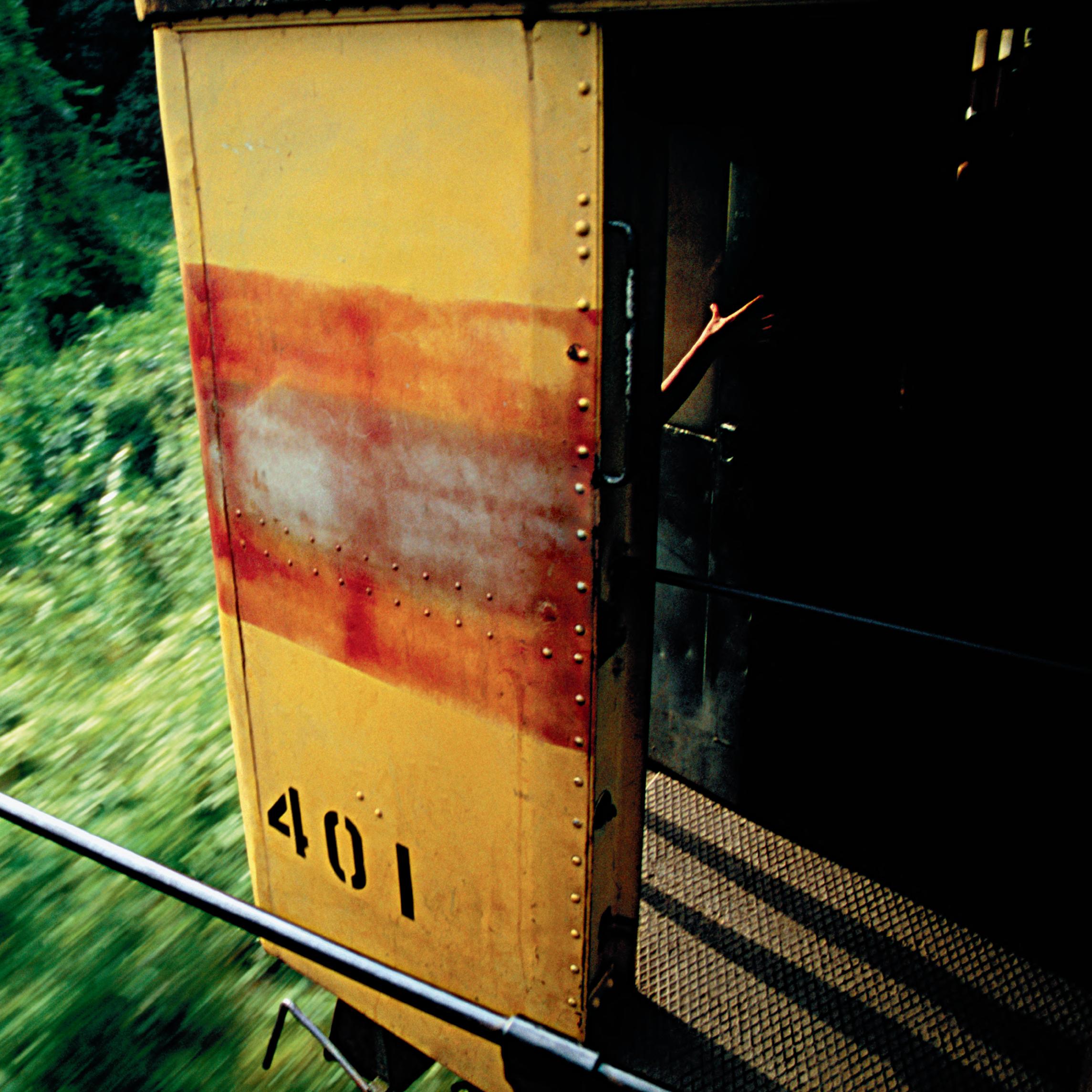


“Não é bem bonito chegar numa caverna dessas aqui do Maracá e pôr a mão nas peças – nós não sabemos do que ao certo o índio morreu, pode estar algo contaminado nesses restos. […] Deixavam essas urnas para ter um reconhecimento deles, masculino e feminino; por isso punham esses desenhos, essa arte boa. Tive uma fissura – para melhor explicar sobre o meu descobrimento delas. Como não se destrói, como é a matéria do barro, a fornada, aí depositavam os ossos e oferendas dentro. Os mais velhos da antiguidade diziam que esses potes costumavam dar ouro dentro, mas Deus o livre fazer uma alma dessas pegar!”
Antônio José de Oliveira, morador mais próximo de sítios de grutas, Vila Maracá, Amapá
“It is not exactly nice to come to one of these caves here in Maracá and lay one’s hands in the pieces – we don’t know for sure how the Indian died, something may be contaminated in these remains. […] They left these urns so that they could be recognized as male or female; this is why they put these drawings, this good art. I had a craving – to explain better my discovery of them. Since it is not destroyed, the way the material of clay is, the firing, they deposited their bones and offerings in there. The elders of ancient times used to say that these pots could have gold inside, but God forbid making one of these souls get it!”
Antônio José de Oliveira, the nearest dweller to the cave sites of Vila Maracá, Amapá
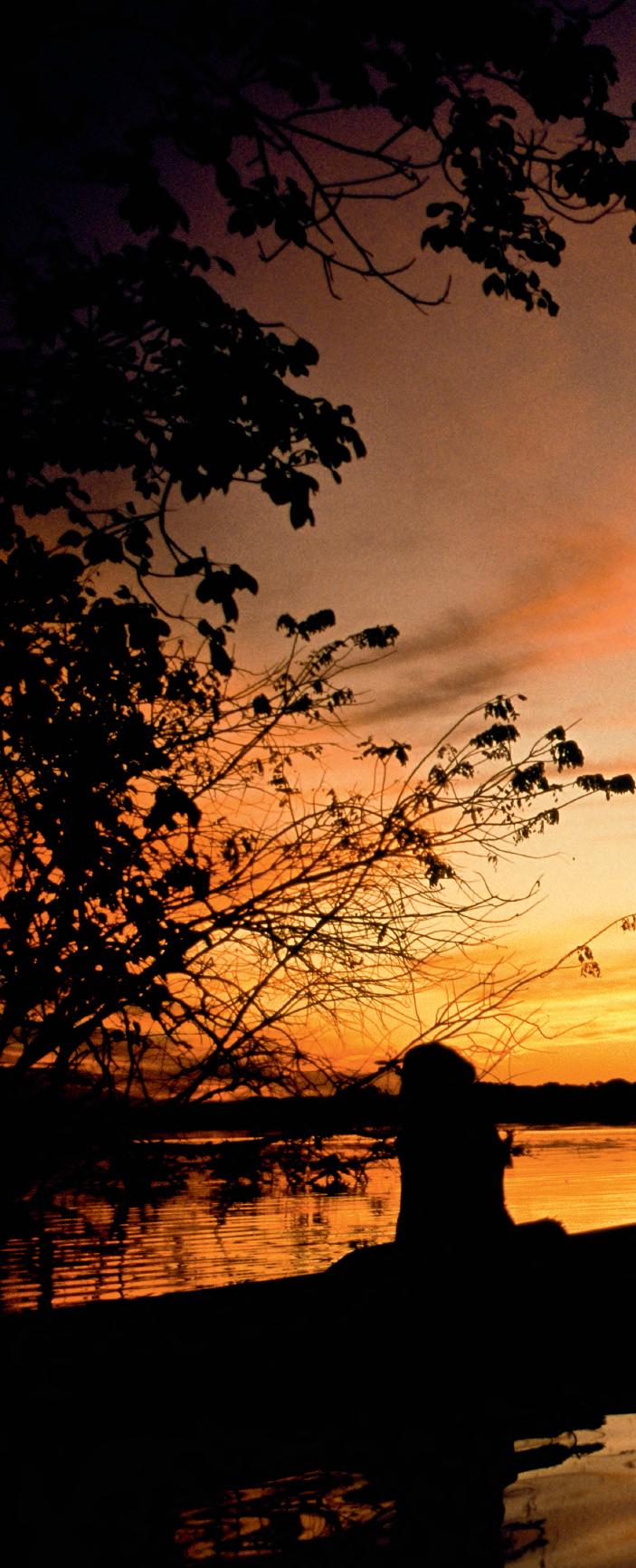

“Na região do Maracá, no sul do Amapá, sítios caracterizados pela presença de urnas funerárias dispostas em salões no interior de cavernas. Os vestígios arqueológicos no Amapá indicam a presença de pelo menos quatro culturas a partir do século 11, estendendo-se até a chegada dos europeus.” Mariana Petry Cabral e João Saldanha, arqueólogos
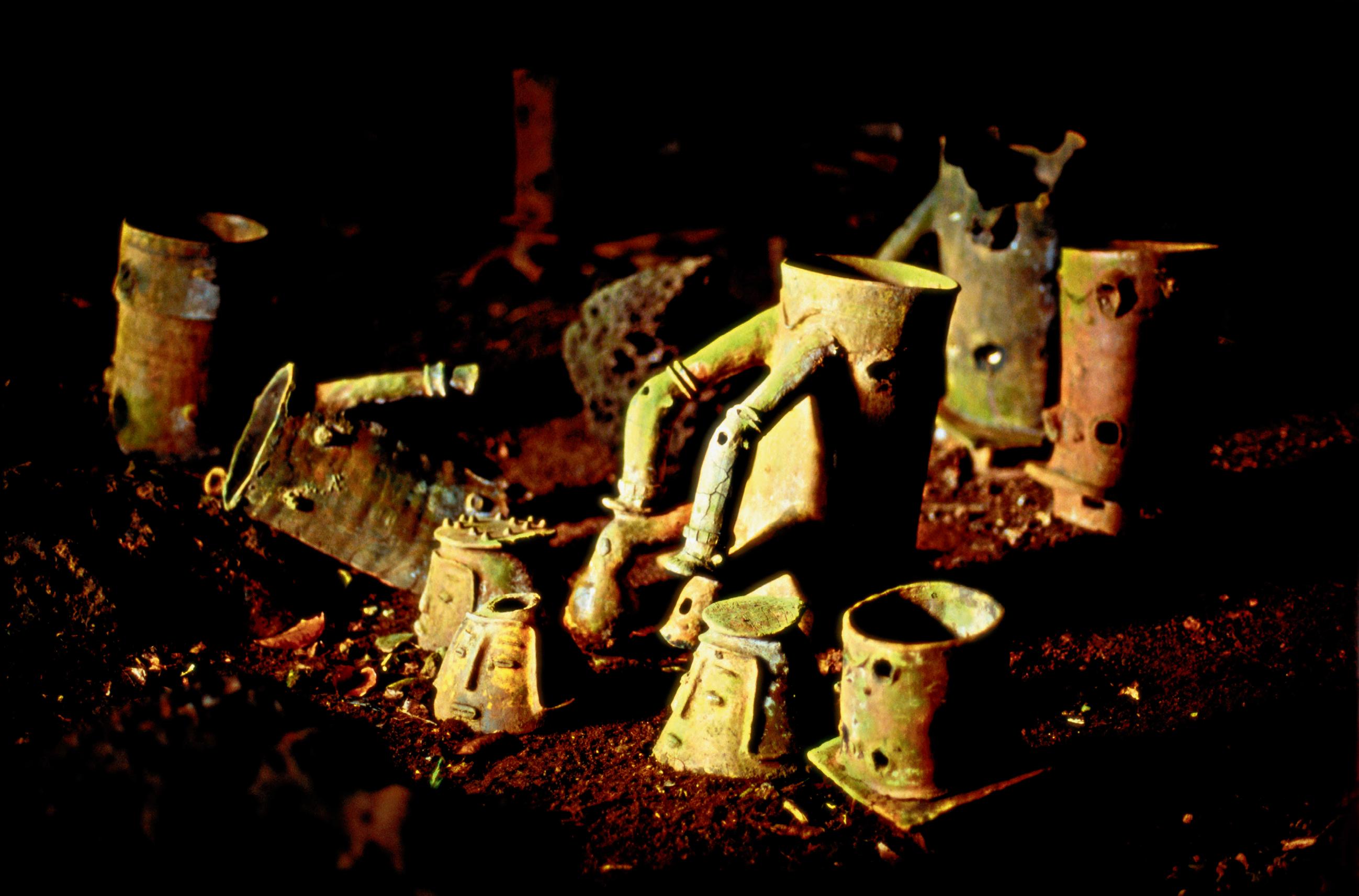
‘In the Maracá region, southern Amapá, sites characteristically have funerary urns arranged in chambers ‘In the Maracá southern sites have urns in chambers inside caves Archaeological vestiges in Amapá indicate the presence of at least four cultures, starting from inside caves. in indicate the presence of at least four cultures, from the eleventh century and going until the arrival of Europeans ’ the eleventh century and until the arrival of Europeans.’ Mariana Petry Cabral and João Saldanha, archaeologists Mariana Cabral and João Saldanha, a n c i e n t a m a z o n

Arqueóloga e morador em sítio megalítico de aspectos arqueoastronômicos Calçoene Amapá Há ligações desse sítio não só com e morador em sítio de aspectos arqueoastronômicos, Calçoene, Amapá. Há desse sítio não só com outros, de rituais funerários e deposição de cerâmica, mas também com grutas No local, solidificaram se como cultura material outros, de rituais funerários e de cerâmica, mas também com grutas. No local, solidificaram-se como cultura material antigos conhecimentos sobre o céu, quando grupos pré colombianos da fase aristé, séculos 1 conhecimentos sobre o céu, grupos pré-colombianos da fase aristé, séculos 1o 9 -9o d C , erigiram pedras alinhadas de d. C., alinhadas de até três metros de altura

An archaeologist and a resident at a megalithic site with archaeoastronomical aspects, Calçoene, Amapá There are funerary rituals An archaeologist and a resident at a megalithic site with archaeoastronomical aspects, Amapá. There are funerary rituals and ceramic deposition links from this site not only with other ones but also with caves At this place, ancient knowledge about the sky and ceramic links from this site not with other ones but also with caves. At this ancient about the consolidated itself as a material culture when pre Columbian groups from the Aristé phase, first to ninth century AD, erected aligned consolidated itself as a material culture when pre-Columbian groups from the Aristé first to ninth century AD, erected stones up to three meters high stones up to three meters


Peça antropomorfa da fase aristé, encontrada no Amapá e datada entre os séculos 1º e 9º da fase aristé, encontrada no e datada entre os séculos 1º e 9º
Anthropomorphic piece from the Aristé period, found in Amapá and dated from between the first and ninth centuries AD from the Aristé found in and dated from between the first and ninth centuries AD
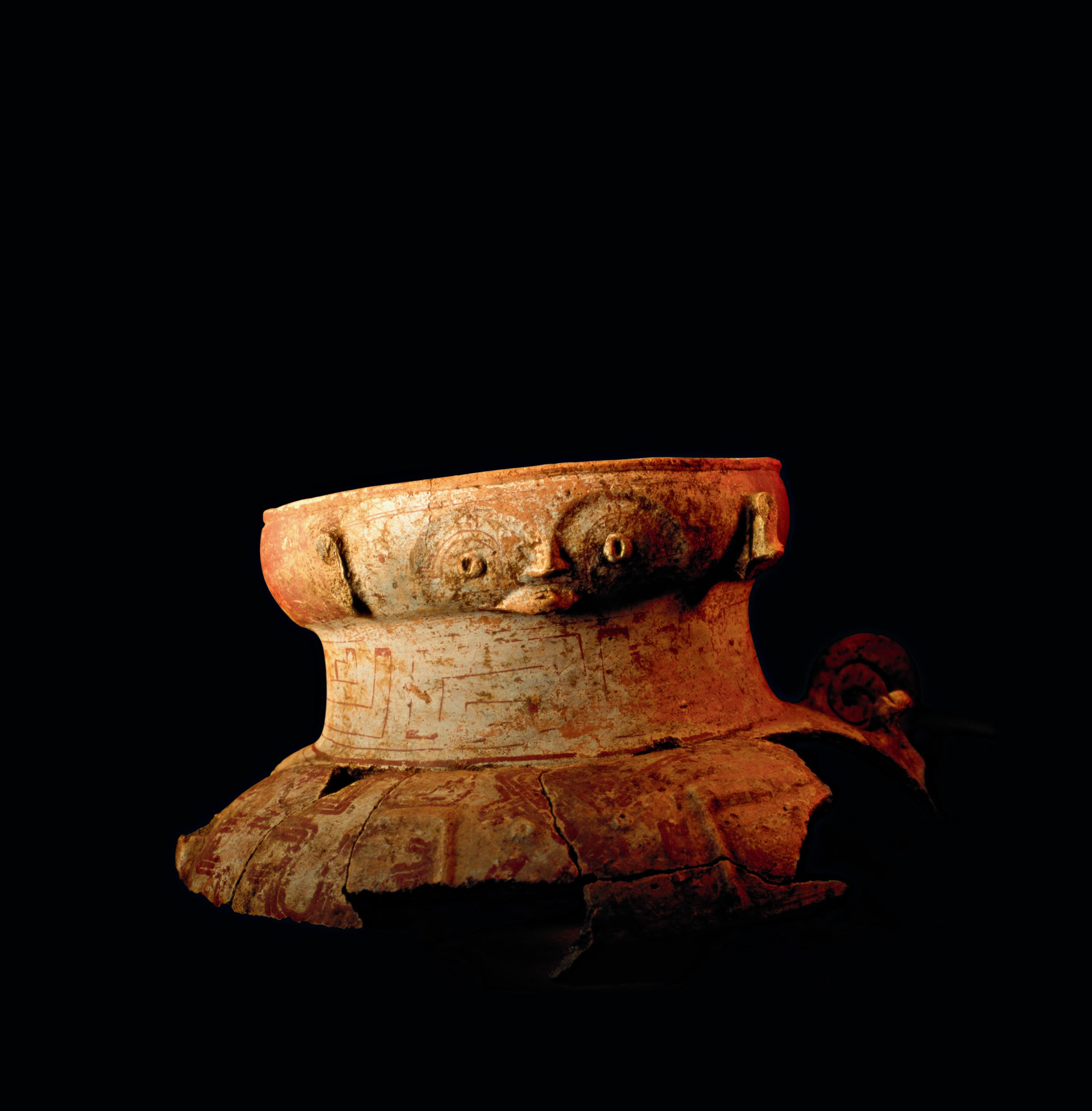
A milhares de quilômetros daquela solitária casa na ilha paraense de Mexiana, outras pessoas se fazem as mesmas perguntas. Numa pequena e lotada sala de aula no Museu de Arqueologia e Etnologia da USP, me aperto entre a cadeira e a mesa para assistir às disputadas aulas de pósgraduação do professor Eduardo Góes Neves. Ágil, ele preenche o quadro com sua letra miúda e o ar com sua voz grave. Fala sobre o ambiente natural das florestas tropicais. Sobre os principais teóricos da disciplina. Cita ambientalistas. Geógrafos. Antropólogos. Arqueologia é assim, uma ciência que está sempre se enroscando com as outras em busca de referências.
Boa parte das aulas, Eduardo a ocupa falando sobre as possíveis migrações dos povos remotos da Amazônia e as línguas que falavam. Boa parte das dúvidas dos pesquisadores está ligada a compreender como os troncos linguísticos se disseminaram pelos territórios. E, assim, seguir o rastro até chegar aos tataravôs dos índios de hoje. Mas não vamos dar poderes mediúnicos ao professor – Eduardo não sabe exatamente que línguas eles falavam.
Por essas e outras, há até quem questione se arqueologia é mesmo ciência, tal sua relação um tanto rebelde com a apresentação de provas. Se a matemática e a física vivem de trazer respostas, ela vive de fazer perguntas. E, cada vez que uma delas é respondida, descobre-se que ela trouxe uma mala repleta de novas perguntas, como as cabeças da hidra de Lerna, que renascem multiplicadas cada vez que uma delas é cortada. O mais provável é que a maioria das perguntas nunca seja respondida. Mas perguntar é preciso.
Thousands of kilometers away from that solitary house on the island of Mexiana, Pará, other people ask themselves the same questions. In a small, crowded classroom in the University of São Paulo’s Museum of Archaeology and Ethnology, I squeeze myself between the chair and the desk to watch Professor Eduardo Góes Neves’s much sought-after graduated classes. Agile, he fills the slate with his small handwriting and the air with his low-pitched voice. He talks about the natural environment of rain forests, about the subject’s main theorists. He cites environmentalists, geographers, anthropologists. This is how archaeology is, a science that, in its search for references, is always entangling itself with others.
Eduardo devotes a large part of his classes to talking about the possible migrations of long past peoples of the Amazon and the languages they spoke. To a large extent, researchers’ doubts relate to understanding how the linguistic families spread themselves over the territories – and, in this way, to following the trail to the great-grandparents of today’s Amerindians. But let us not attribute spiritual channeling powers to the Professor – Eduardo does not know exactly what languages they spoke.
For these and other reasons, there are even those who question whether archaeology is really a science, given its somewhat rebellious relationship with the production of evidence. If mathematics and physics live out of bringing answers, archaeology lives out of making questions. And every time one of them is answered, it is found that it has brought
Em 2002, quando o americano James B. Petersen encontrou uma ponta de flecha no município amazonense de Iranduba, soube que ela despertava novas e velhas dúvidas. Petersen, no entanto, nem teve tempo de ouvir a todas. Ele podia ter optado por ser neurocirurgião ou professor de literatura. Mas veio para a Amazônia brasileira investigar nosso passado distante. Com essa escolha, definiu não só sua vida, mas também sua morte. Em 2005, sentado à mesa de um restaurante na estrada que liga Manacapuru a Manaus, foi surpreendido num rápido assalto. E morreu ali, com a maioria das questões ainda na fila de espera e algumas respostas que não teve tempo de expressar.
Quando vejo de perto a herança que ele deixou, a ponta de flecha, emociono-me mais do que podia esperar. Datada em 8500 anos, ela é o item confeccionado por mãos humanas mais antigo que já foi encontrado na Amazônia. Cabendo na palma da mão, sua forma é simétrica, e suas bordas, afiadas. É feita de sílex, uma rocha translúcida, com pequenas manchas escuras no interior. De perto, percebe-se que foi lascada muitas vezes, em cortes leves, por mãos habilidosas. Parece tão intacta que faz crer que nem chegou a ser usada. Uma pessoa com melhor capacidade de análise, como o próprio Petersen, poderia ficar horas observando os detalhes de seu feitio. Ora, o que estou dizendo! Arqueólogos já estão há anos tirando respostas desse objeto que eu olho sem compreender bem. Penso que talvez tenha sido confeccionado para a caça. Ou para rituais. Para eles, ela pode ser uma chave que indica soluções a respeito da antiguidade da presença do homem, rastros de migrações, intercâmbios culturais. Para mim, ela é portadora de uma mensagem misteriosa, guardada durante milhares de anos. Uma a uma, as questões racionais vão saindo de mansinho, deixando espaço livre para a subjetividade. Ao alcance de meus dedos, está uma peça carregada de traços humanos, que fez parte da vida de uma pessoa real, de uma história perdida nas pastas arquivadas do tempo, esse senhor que governa a tudo e a todos. Sempre as águas vão e vêm? Em meus olhos, é tempo de maré cheia.
Enquanto as lágrimas deslizam pelo meu rosto, digo baixinho, numa pergunta longa e insistente:
– Quem foi que fez você? Quem é essa pessoa? Como era, o que fazia, quantos anos tinha? Como morreu? Me diz, quem foi?
Olho sua transparência vítrea, de um cinza quase verde, sua simetria perfeita, sua delicadeza de menina. Procuro descobrir quantas mãos a tocaram, em quantos corpos penetrou, se já se sujou de sangue. Eu mesma duvido que possa manter diálogo com um artefato lítico tão antigo, mas chego a acreditar que essa flecha me fita com um sorriso
desafiador. Quantas coisas, em seus mais de 8 mil anos de existência, ela testemunhou! Ela sabe, principalmente, quem foi o artista que a esculpiu.
Essa é, sempre foi, a grande pergunta da arqueologia. Quem? Escavam-se cemitérios, desenterram-se objetos, analisam-se “perfis estratigráficos”, “feições”, “unidades”. Vislumbram-se praças e portos. A única busca, no entanto, é: quem? Como se necessitássemos desesperadamente compreender o passado, recriando a linha que se perde atrás de nossas próprias vidas para podermos seguir adiante. Será que, ao sabermos quem foi esse homem a quem não tivemos o prazer de ser apresentados, conheceremos melhor a nós mesmos?
– Flecha – e já estou implorando –, me diga: quem?
Tenho certeza de que os arqueólogos, com seu arsenal de teorias, seus laboratórios sofisticados, seus testes de DNA, sua tenacidade, sua alta dose de intuição e suas mentes brilhantes, poderão um dia me dar algumas respostas.
Assim, chegará um momento em que as pesquisas estarão tão avançadas, e tantas descobertas serão feitas, que alguém terá a ousadia de traçar um perfil de remotos moradores da Amazônia. Mas, por mais que se desvendem sinais, eles continuarão sendo nossos desconhecidos, mesmo despertando essa espécie de amor ancestral que nos obriga a respeitá-los.
Quantas e quantas vezes essa história se repetiu ao longo dos milênios em que se perde a existência da humanidade? E quantas vezes ainda se repetirá?
Um dia – quem poderá saber? – talvez advenha a nós mesmos uma qualquer hecatombe. Talvez as previsões apocalípticas que nos ameaçam com marés diluvianas ou meteoros perdidos não estejam erradas. Um dia – quem poderá saber? – nossa civilização também se perca, sem deixar mais que poucos vestígios de nosso cotidiano.
Arqueólogos do futuro – reencarnações de Eduardo Góes Neves e Betty Meggers –quiçá venham escavar onde hoje se ergue a metrópole São Paulo ou a desenhada Brasília em busca de nossos fantasmas.
Vão conversar com os novos moradores. Vão comer de sua comida. Vão se embriagar com sua aguardente. Vão dançar em suas festas. Vão chorar seus mortos. Vão atolar os pés na sua lama. Vão atravessar o espelho. Acreditarão que, compreendendo um pouco esses novos ocupantes, descascando velhos fios, refazendo velhas tramas, talvez cheguem perto da vida que vivemos hoje.
Mas, por mais perto que cheguem – mesmo que rocem de leve em nossas peles já inexistentes e decifrem nossas letras –, nunca conhecerão verdadeiramente os nossos deuses.
a whole suitcase of new questions, like the heads of the hydra of Lerna, which were reborn manifold each time one of them was cut off. Most likely, the bulk of the questions will never be answered. But it is necessary to ask.
In 2002, when American researcher James B. Petersen found the tip of an arrow in the town of Iranduba, Amazonas, he knew that it would arise new and old doubts. Petersen, however, was not granted the time to listen to all of them. He could have chosen to be a neurosurgeon or a literature professor. But he came to the Brazilian Amazon to investigate the country’s distant past. With that choice, he defined not only his life, but also his death. In 2005, sitting in a restaurant by the road linking Manacapuru and Manaus, he was caught by surprise in a quick mugging. And he died there, with most questions still in the waiting line and some answers he had no time to express.
When I look closely at the estate he left, the arrow tip, I get more emotional than I could expect. Dated from 8,500 years ago, it is the oldest human-made item ever found in the Amazon. It fits into the palm of a hand; its shape is symmetric, and its edges are sharp. It is made of flint, a translucent rock with tiny dark spots inside. Up close, one notices that it was splintered many times, in light cuts, by skilled hands. It looks so intact that it makes believe that it did not even come to be used. A person with better analytical skills, such as Petersen himself, could spend hours watching the details of its craftsmanship.
Now, what am I saying? Archaeologists have been getting answers for years from this object that I look without understanding it well. I think that maybe it was made for hunting. Or for rituals. For archaeologists, it can be a key to solutions for the age of human presence, migration trails, cultural exchanges. For me, it is the bearer of a mysterious message, kept for thousands of years. One by one, rational questions slip away quietly, leaving free room for subjectivity. Within reach of my fingers is a piece loaded with human traces, a piece that was part of the life of a real person, of a lost story in the archived folders of time, that master who governs everything and everyone. Do waters always come and go? In my eyes, it is flow time.
While tears slide down my face, I whisper a long and insistent question: “Who was it that made you? Who was that person? How he was, what he did, how old was he? How did he die? Tell me, who was he?”
I look at its glass-like transparency, of an almost greenish grey, its perfect symmetry, its girl-like delicateness. I try to discover how many hands have touched it, how many bodies it has penetrated, if it has ever been stained with blood. I doubt myself that I can have a dialog with such an ancient stone artifact, but I come to believe that this arrow looks at
me with a defying smile. How many things it has witnessed in all of its more than 8,000 years’ existence! Most importantly, it knows who was the artist who sculpted it.
This is, and has always been, archaeology’s greatest question. Who? Graveyards are dug, objects are unearthed, “stratigraphic profiles”, “features” and “units” are analyzed. Settlements and moorings are glimpsed. The only search, however, is: who? As if we desperately needed to understand the past, recreating the line that gets lost behind our own lives so that we can go ahead. Can it be that we will know ourselves better when we learn who was this man to whom we did not have the pleasure to be introduced?
“Arrow,” I am already imploring, “tell me: who?”
I am sure that archaeologists, with their arsenal of theories, their sophisticated laboratories, their DNA tests, their tenacity, their large amounts of intuition and their brilliant minds, will be able to give me some answers one day.
So, a moment will come when research will be so advanced and so many discoveries will be made that someone will dare to trace a profile of the long past dwellers of the Amazon. But no matter how many signals are deciphered, these people will remain unknown to us, even as they cause that kind of ancestral love that forces us to respect them.
How many times that story has repeated itself throughout the millennia during which mankind has existed? And how many times will it still repeat itself?
One day – who are we to know? – maybe we will be hit by some kind of catastrophe ourselves. Maybe the apocalyptic predictions that threaten us with diluvian tides or stray meteors are not wrong. One day – who might possibly know? – maybe our own civilization is lost, leaving no more than a few traces of our daily lives.
Archaeologists of the future – reincarnations of Eduardo Góes Neves and Betty Meggers – maybe will dig where today the metropolis of São Paulo or the designed city of Brasília stand, in search of our ghosts.
They will talk to the new inhabitants. They will eat their food. They will get drunk with their booze. They will dance in their feasts. They will mourn their dead. They will stick their feet in their mud. They will go through the mirror. They will believe that by understanding those new occupants, peeling old wires, remaking old meshes, maybe they will get closer to the life we live today.
But no matter how close they get – even if they slightly touch our then already nonexistent skins and decipher our languages –, they will never really know our gods.
Há 2500 anos, deu-se uma reorganização dos modos de vida amazônicos: cresceu o número de aldeias, que seriam sedentárias por décadas. A colonização europeia modificou profundamente a vida das antigas sociedades amazônicas. A arqueologia é fonte privilegiada para o entendimento desse processo. Jogos indígenas, Altamira, Pará

Around 2,500 years ago, Amazonian ways of life were reorganized: the number of villages grew, and they would be sedentary for decades. European colonization profoundly changed the life of old Amazonian societies. Archaeology is a privileged source for understanding that process. Indian games, Altamira, Pará




“As urnas têm formatura de pessoa. Esse material é tão bem-feitinho desde antes dos meus avós, que já moravam aqui. Faziam aquilo pela família, pra demonstrar o que era cultura aqui. Será que eles faziam pra demonstrar que a terra era indígena? Acho que foi pra gente ver e entender o que significava.”
Edmilson Junior, pastor em Sampaio, Autazes, Amazonas
“The urns are shaped like people. This material is so well made! And it was made before the time of my grandparents, who already lived here. The ancient ones made that for their families, to show what the culture was like here. I wonder, did they make it to show that the land was theirs? I think it was for us to see and understand what it meant.”
Edmilson Junior, an Evangelical preacher at Sampaio, Autazes, Amazonas

• 90 No início da era cristã, os grupos humanos amazônicos se elevaram tecnologicamente, transformando a paisagem. Queimadas antrópicas, assentamentos, diques, terra preta, redes de transporte e comunicação e manejo da água apontam para a ideia de organização social
In the early Christian era, human groups in the Amazon reached a higher technological level, transforming the landscape. Slash-and-burn areas, settlements, dykes, terra preta, transportation, communication and water management all strongly suggest a picture of social organization


No curso do rio Tapajós, aí incluída sua embocadura, viveu uma sociedade densa e complexa, a cultura Santarém, com xamãs, escravos e abundância de alimentos. No trecho médio do rio, datações indicam peças arqueológicas produzidas por um povo desconhecido, de até 1600 a. C., o que coincide com o início da agricultura no baixo Amazonas

In the course of the Tapajós River, including its mouth, there once lived a dense and complex society: the Santarém culture, with shamans, slaves and plenty of food. In the river’s middle course, dating indicates archaeological pieces produced by an unknown people up to 1600 BC, which coincides with the start of agriculture in the lower Amazon
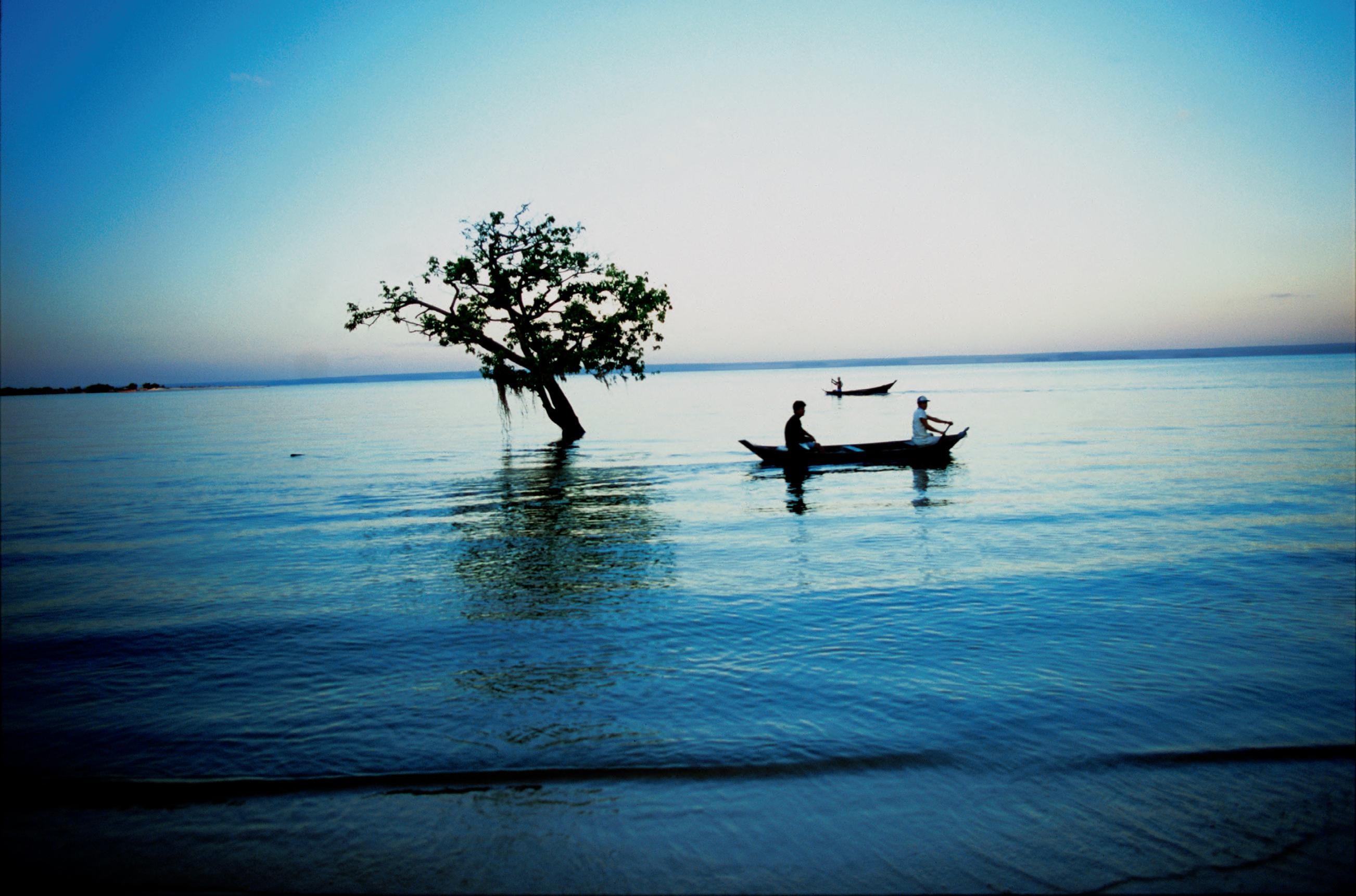
A agricultura pré-colombiana gerou um processo coevolutivo em que humanos e plantas desenvolveram mútua dependência. A mandioca, domesticada há cerca de 3 mil anos na Amazônia, é hoje consumida em larga escala na América Latina, Antilhas, África e Ásia. Os índios do passado criaram sofisticada tecnologia no uso de instrumentos como o tipiti e o cumatá – que transformam aquela planta venenosa em produtos como o beiju, a farinha, a tapioca e o caxiri
Pre-Columbian agriculture generated a co-evolutionary process where humans and plants developed a mutual dependence. Manioc, domesticated about 3,000 years ago in the Amazon, is now consumed in large scale in Latin America, the Caribbean, Africa and Asia. Amerindians of the past created a sophisticated technology in the use of devices such as the tipiti and the cumatá, which transform that poisonous plant into products such as beiju, manioc meal, tapioca and caxiri
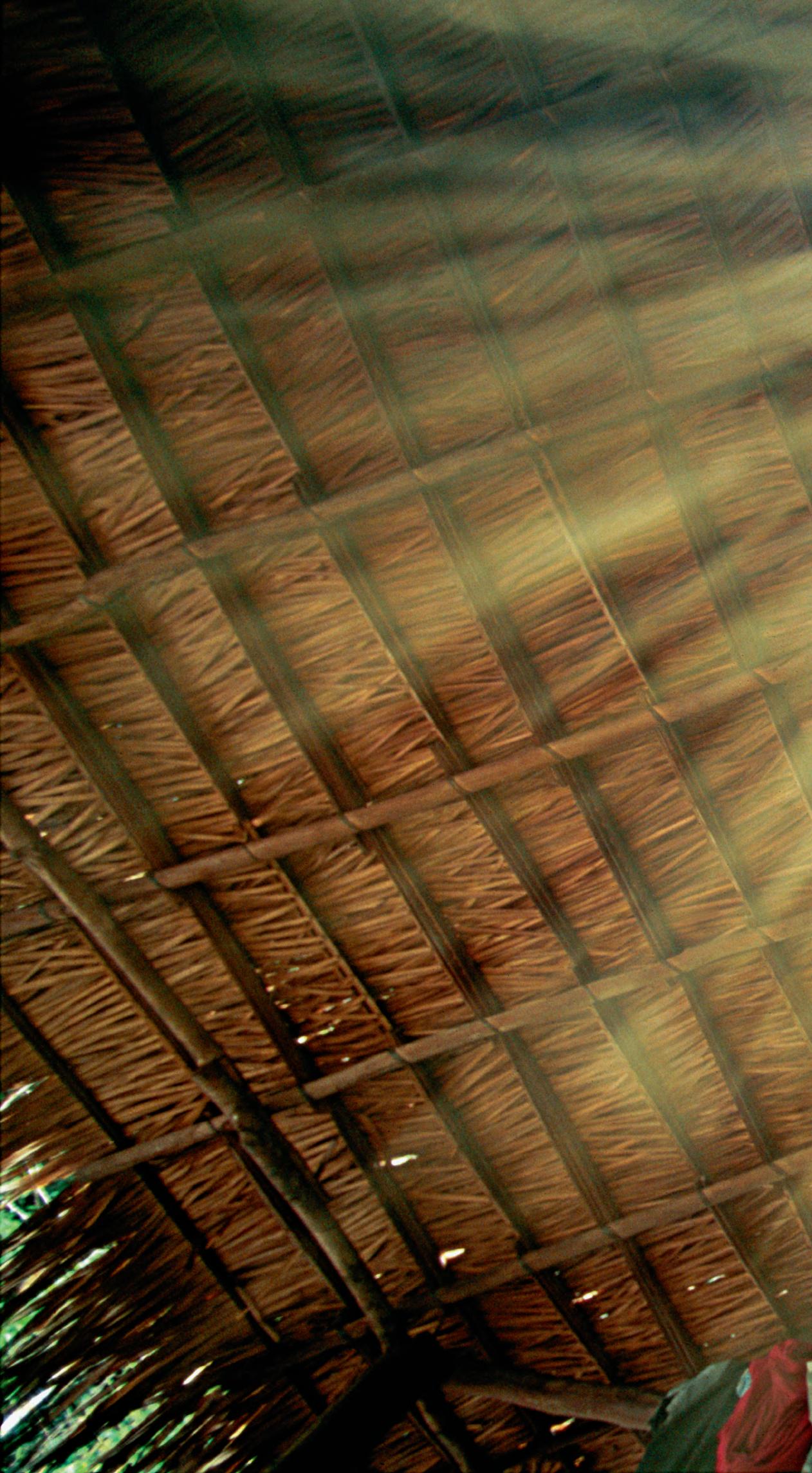
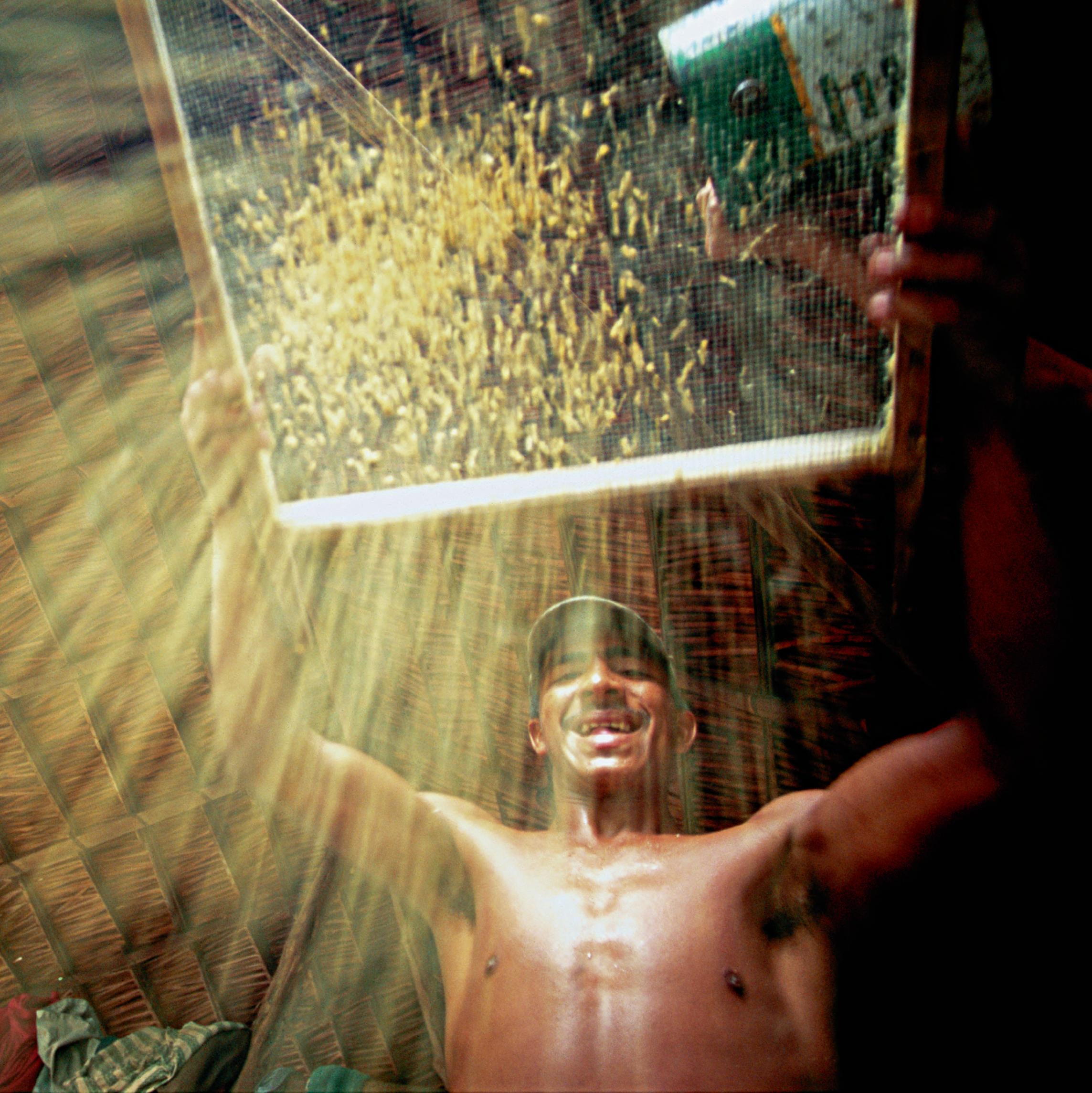
“Lendas e mitos falam do cotidiano e do imaginário de grupos tradicionais amazônicos. A lenda das amazonas – guerreiras celibatárias cujo encontro com Francisco de Orellana, no século 16, serviu de inspiração para batizar o grande rio – reforça e impõe a visão do colonizador sobre as sociedades amazônicas, estigmatizando-as. Tais ‘guerreiras’ eram uma antiga lenda helênica que animava a cabeça dos conquistadores do Novo Mundo.”
Denise Pahl Schaan, doutora em antropologia e arqueóloga

“Legends and myths tell about the routine and the collective imagination of the Amazon’s traditional groups. The legend of the Amazons – maiden warriors whose encounter with Francisco de Orellana, in the sixteenth century, was the inspiration for naming the great river – reinforces and imposes the colonizer’s view about the Amazon’s societies, stigmatizing them. Such ‘women warriors’ were an old Hellenic legend that excited the minds of the New World’s conquerors.”
Denise Pahl Schaan, PhD in anthropology andarchaeologist



Ao lado: urna funerária antropomorfa da fase guarita, encontrada na região de Manaus Séculos 9º 16 Acervo particular de Luiz Neves, Urucurituba, Amazonas
Ao lado: urna funerária da fase encontrada na de Manaus. Séculos 9º-16. Acervo de Luiz Amazonas.
Opposite: anthropomorphic urn from the Guarita period, found in the Manaus region Ninth to sixteenth century AD Luiz Neves’s private collection, Urucurituba, Amazonas urn from the Guarita found in the Manaus region. Ninth to sixteenth century AD. Luiz Neves’s Amazonas
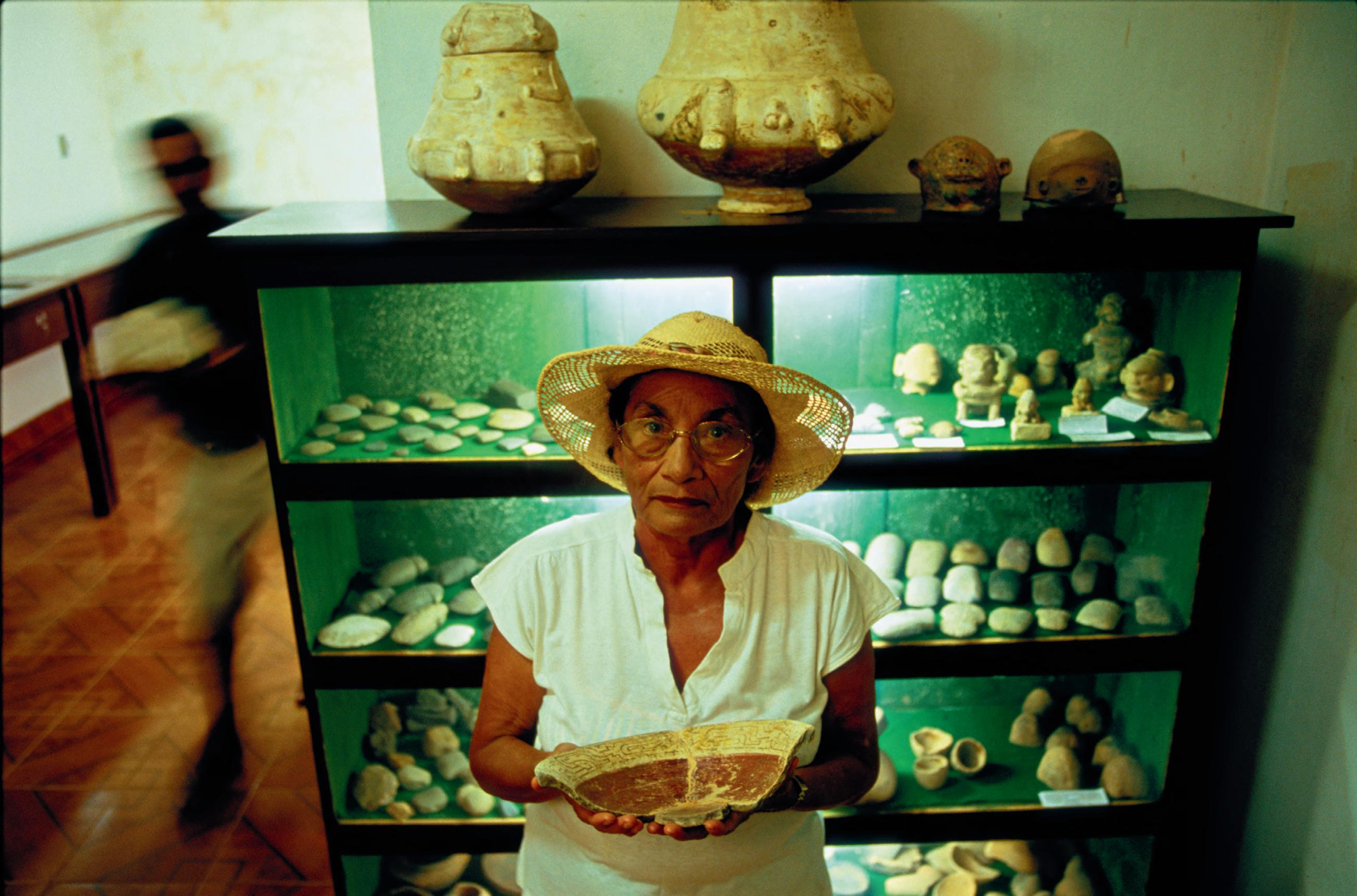

“Isso só pode ser coisa dos indígenas, coisa de índio mesmo. Olhe, certa vez uma delas estava no barranco do Valdivino, com o pescoço pra fora. Esse unzinho vaso nesse pescoço. Daí, repara uns retratos de peixes, de figuras quase ‘escrita de gente’, por exemplo. Eles deviam tratar a imagem de peixe ou animal como o ‘deus da água’, como o pote do dinheiro, entende?”
Tarquino L. da Cruz, comunidade Lauro Sodré, rio Solimões, AM
“This can only be an indigenous thing, an Indian thing really. Look, once one of them was at Valdivino’s escarpment, with the neck out. This very same vase on this neck. Now, look at some images of fish, figures almost like ‘people’s writing,’ for example. They must have treated the image of a fish or animal as the ‘god of water,’ as the pot of money, do you understand?”
Tarquino L. da Cruz, settlement of Lauro Sodré, rio Solimões, AM


Caboclos e migrantes nordestinos lidam artesanalmente com a tradição que os índios sateré-maués lançaram há seiscentos anos. O fruto do guaraná é colhido, torrado, pilado, defumado e enrolado em bastão. Para beberem, muitos ainda o ralam na língua do peixe pirarucu

Caboclos and migrants from northeastern Brazil work in artisan fashion with the tradition inaugurated by Sateré-Maué Amerindians 600 years ago. The guaraná fruit is harvested, roasted, mashed, smoked and rolled into a stick. For drinking, many further grate it with the tongue of the arapaima fish

E m i l h a s e c o m u n i d a d e s d o A m a z o n a s e d o P a r á , s ã o e n c o n t r a d a s c e r â m i c a s d a c u l t u r a k o n d u r i ( i n í c i o d o s e g u n d o m i l ê n i o
Em ilhas e comunidades do Amazonas e do Pará, são encontradas cerâmicas da cultura konduri (início do segundo milênio d C ) Tê m d e c o r a ç ã o p i n t a d a c o m m o t i v o s a n t r o p o z o o m o r f o s C r i a n ç a s b r i n c a m c o m e s s e s f r a g m e n t o s , o s q u a i s a f l o r a m d a d. C.). Têm decoração pintada com motivos antropozoomorfos. Crianças brincam com esses fragmentos, os quais afloram da b e i r a d o s r i o s e e l a s a p e l i d a m beira dos rios e elas apelidam c a r e t a s caretas
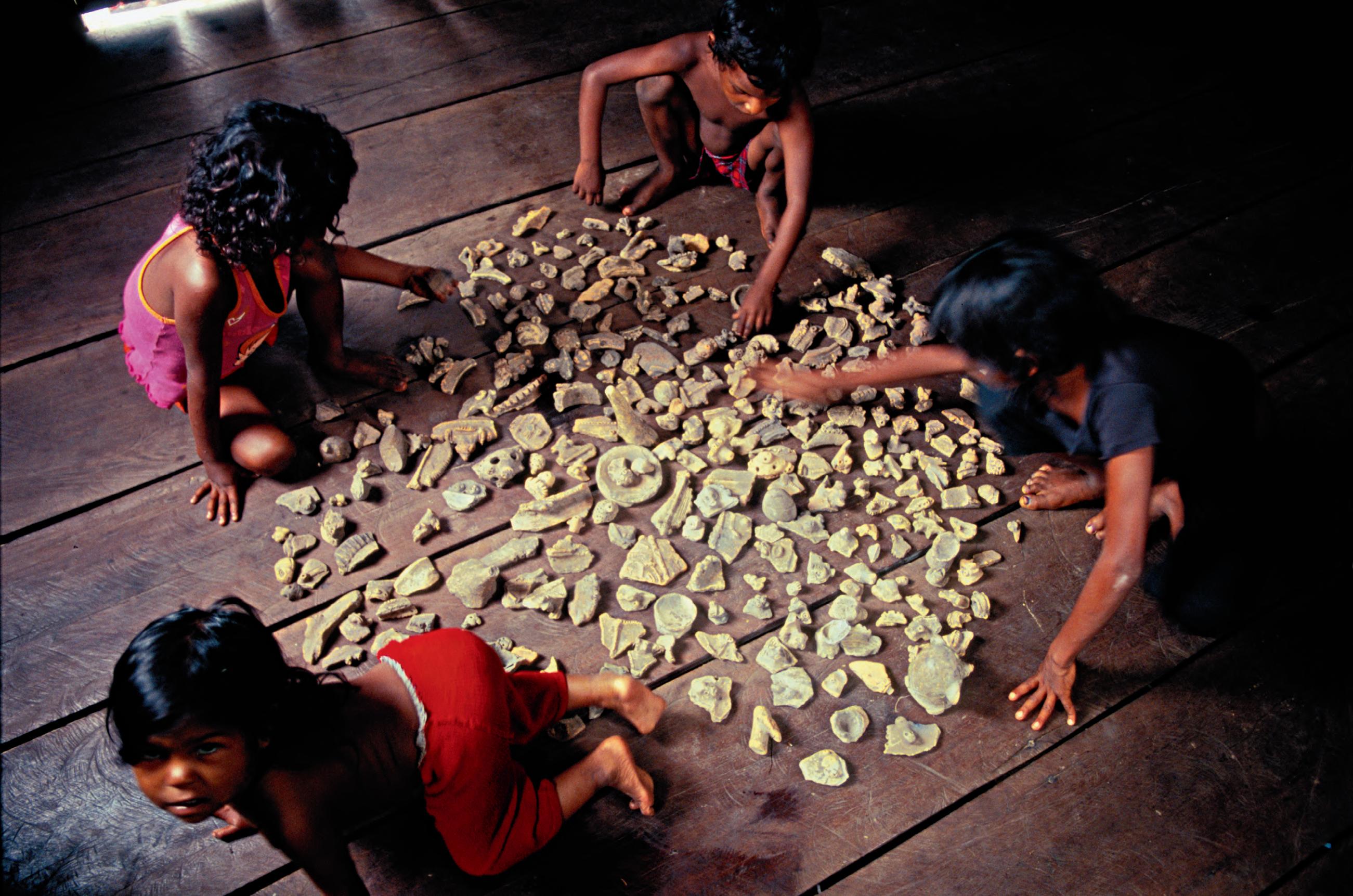
I n r i v e r i s l a n d s a n d c o m m u n i t i e s o f A m a z o n a s a n d P a r á , o n e f i n d s c e r a m i c p i e c e s f r o m t h e K o n d u r i c u l t u r e ( e a r l y s e c o n d
In river islands and communities of Amazonas and Pará, one finds ceramic pieces from the Konduri culture (early second m i l l e n n i u m A D ) T h e i r d e c o r a t i o n i s p a i n t e d w i t h a n t h r o p o z o o m o r p h i c m o t i f s C h i l d r e n p l a y w i t h s u c h f r a g m e n t s , w h i c h f l o a t o u t millennium AD). Their decoration is painted with anthropozoomorphic motifs. Children play with such fragments, which float out o f t h e r i v e r b a n k s a n d t h e k i d s n i c k n a m e of the river banks and the kids nickname c a r e t a s caretas

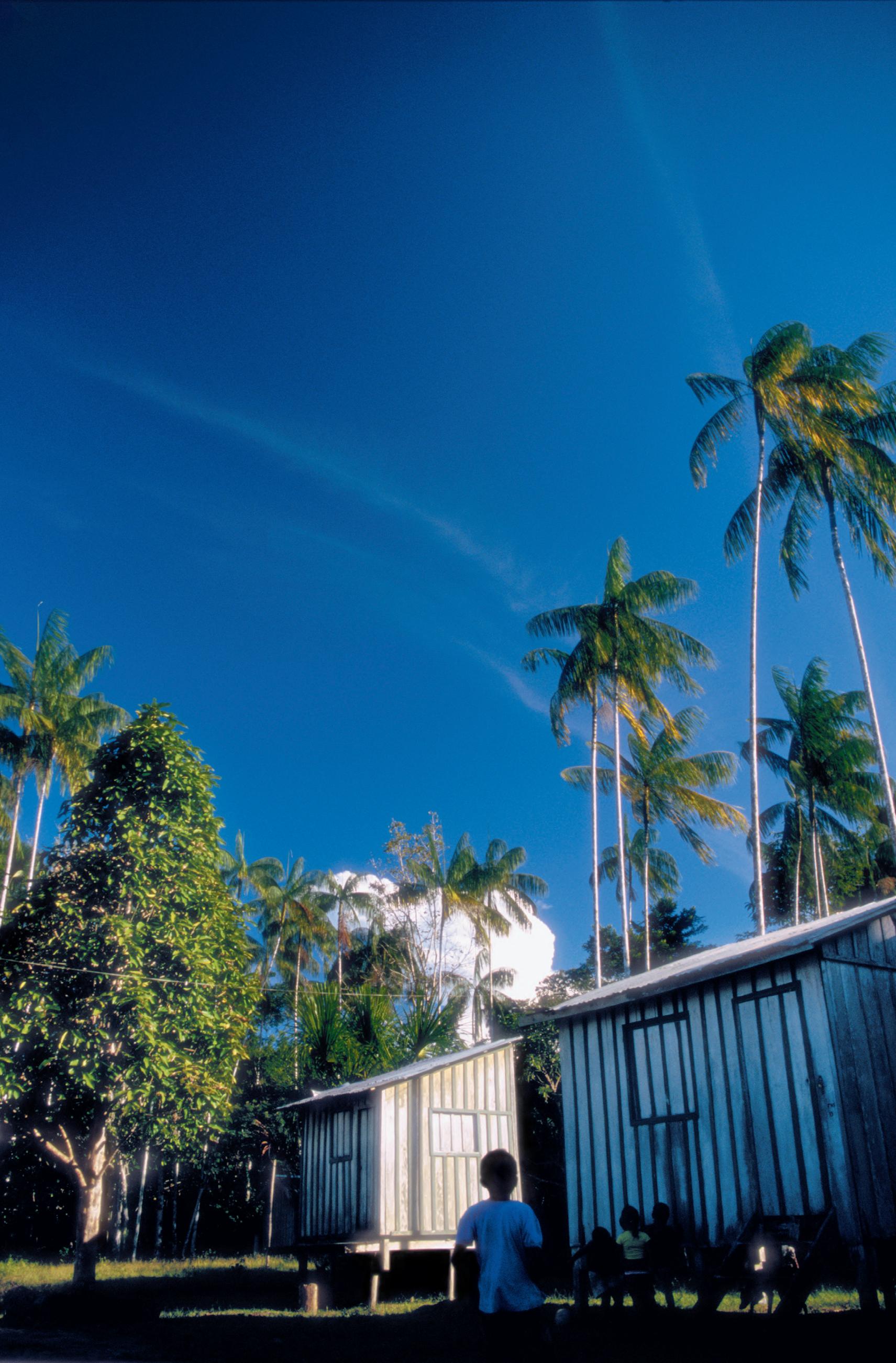

“O solo é a memória da história da paisagem.”
Arnaldo Carneiro, geomorfólogo
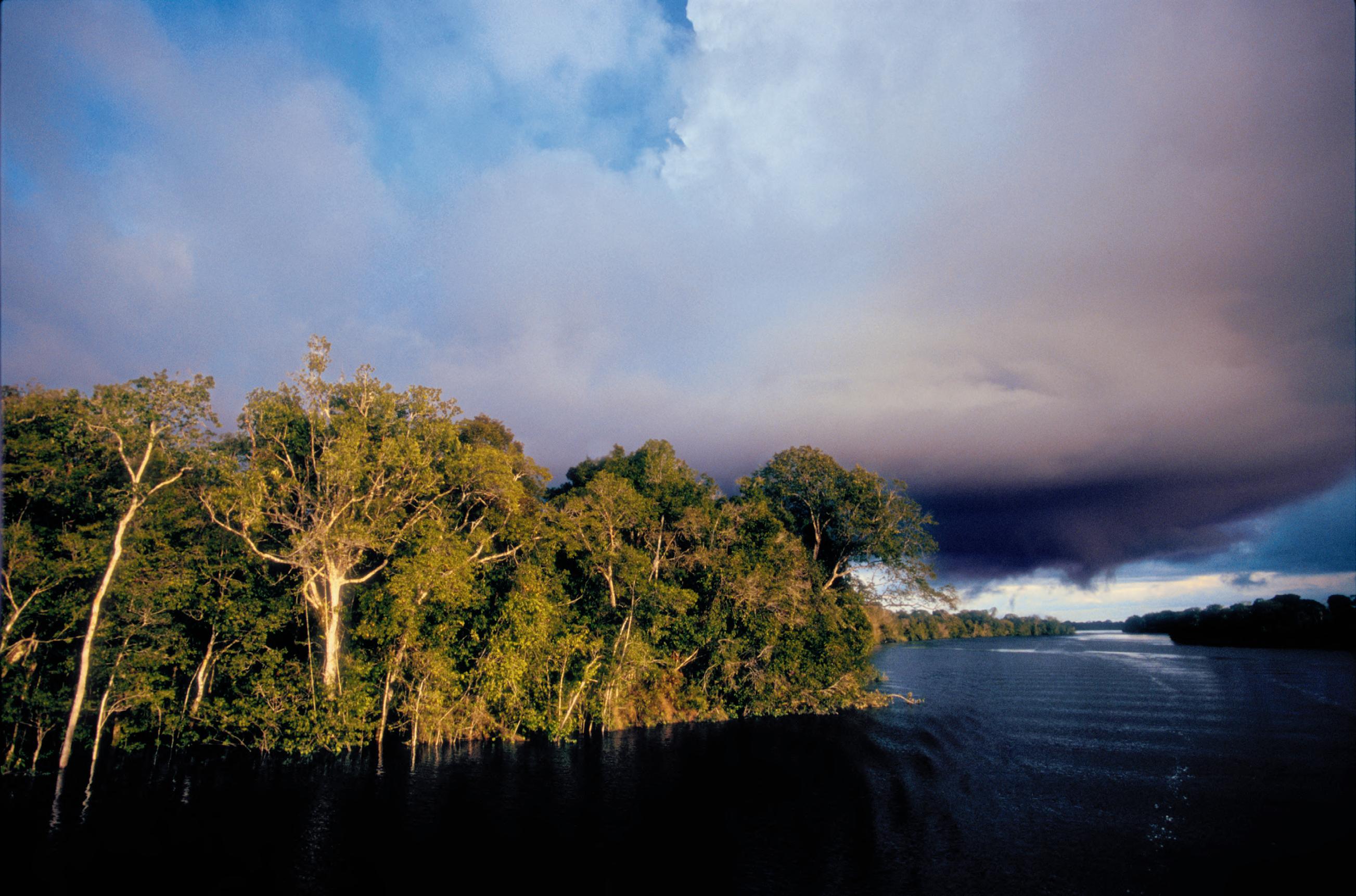

“The soil is the memory of the landscape’s history.”
Arnaldo Carneiro, geomorphologist


A ocupação humana da Amazônia pode ter-se iniciado 14 mil anos atrás. Indícios muito claros datam de 11 200 anos, na caverna da Pedra Pintada, em Monte Alegre, Pará, ocupada por caçadores-coletores. No mesmo local, produziram-se há 8 mil anos as primeiras cerâmicas do Novo Mundo, provavelmente por grupos mais sedentários, de pescadores-caçadores, que se expandiram pela floresta durante o Holoceno PP. 112-5

Human occupation of the Amazon may have started 14,000 years ago. Very clear vestiges date from 11,200 years, at Pedra Pintada Cave (Monte Alegre, Pará), occupied by hunter-gatherers. At the same place, 8,000 years ago, the first ceramic objects of the New World were produced, probably by more sedentary groups of fisher-hunters, who expanded through the forest during the Holocene PP . 112-5
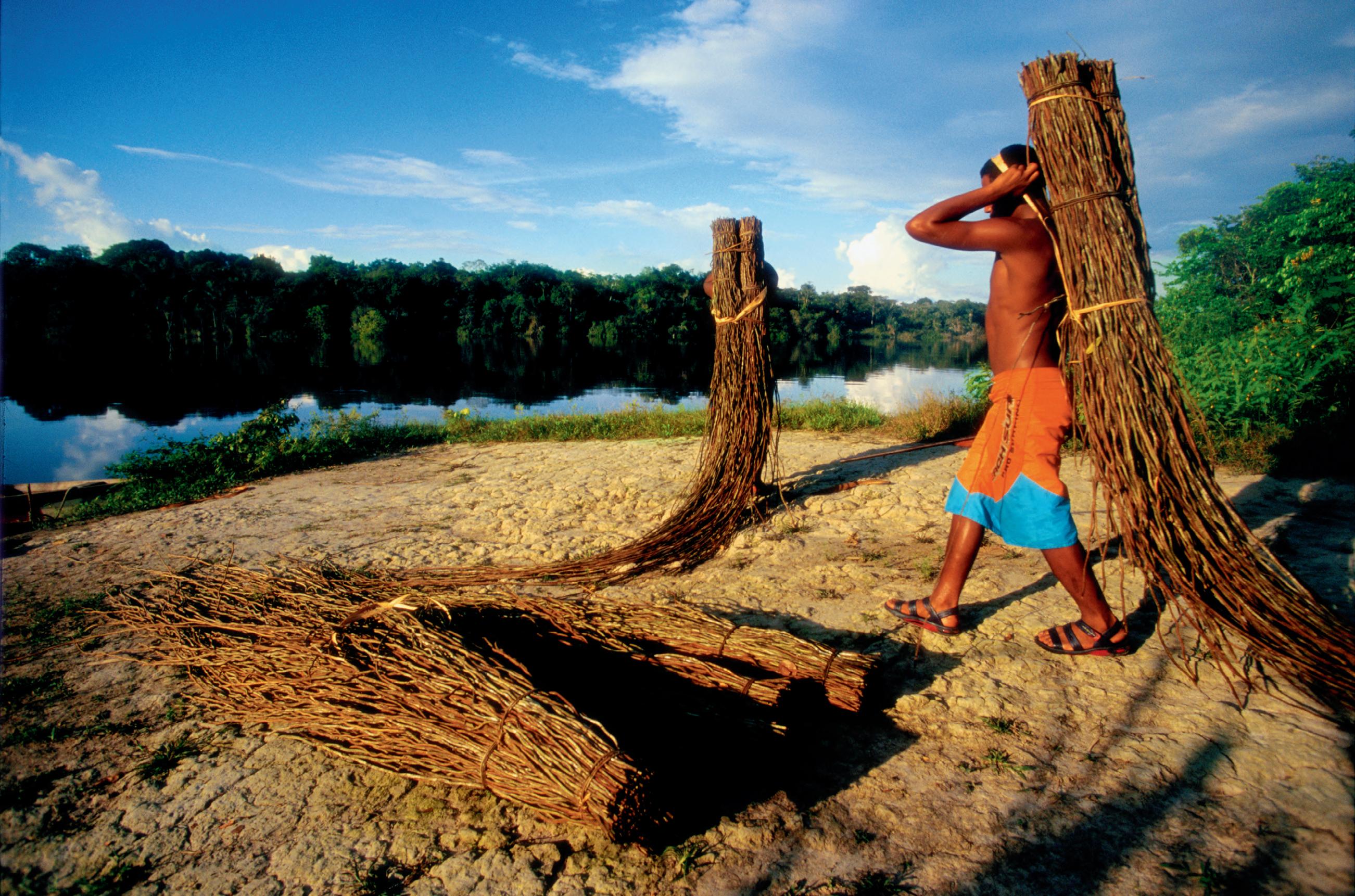
“Aqui embaixo da terra, pra todo canto, deve ter peças. Eu mesma sonhei certa vez. No sonho, a pessoa me disse pra eu cavar; era uma voz somente, e eu escutava: ‘Do lado dessa urna tem ouro… Nas vasilhas têm concha de feijão e colheres douradas…’ Eu não quis no sonho ir desenterrar – iam mangar de mim, fiquei sem muita coragem. Já pensou achar uma botija de ouro dessa praça cheia de mistério? Deus o livre!”
Maria Mendes da Silva, comunidade de Santa Luzia do Pacuí, Amapá
“Down beneath the earth here, everywhere there must be ancient pieces. I dreamed it once myself. In the dream, a person told me to dig out the soil; it was only one voice, and I listened: ‘Beside that urn there is gold… In the pots there are golden bean ladles and spoons…’ In the dream I didn’t want to go and dig for them – people would mock me, I didn’t have much courage. Can you imagine it, finding a pot of gold in this place full of mysteries? God forbid!”
Maria Mendes da Silva, settlement of Santa Luzia do Pacuí, Amapá

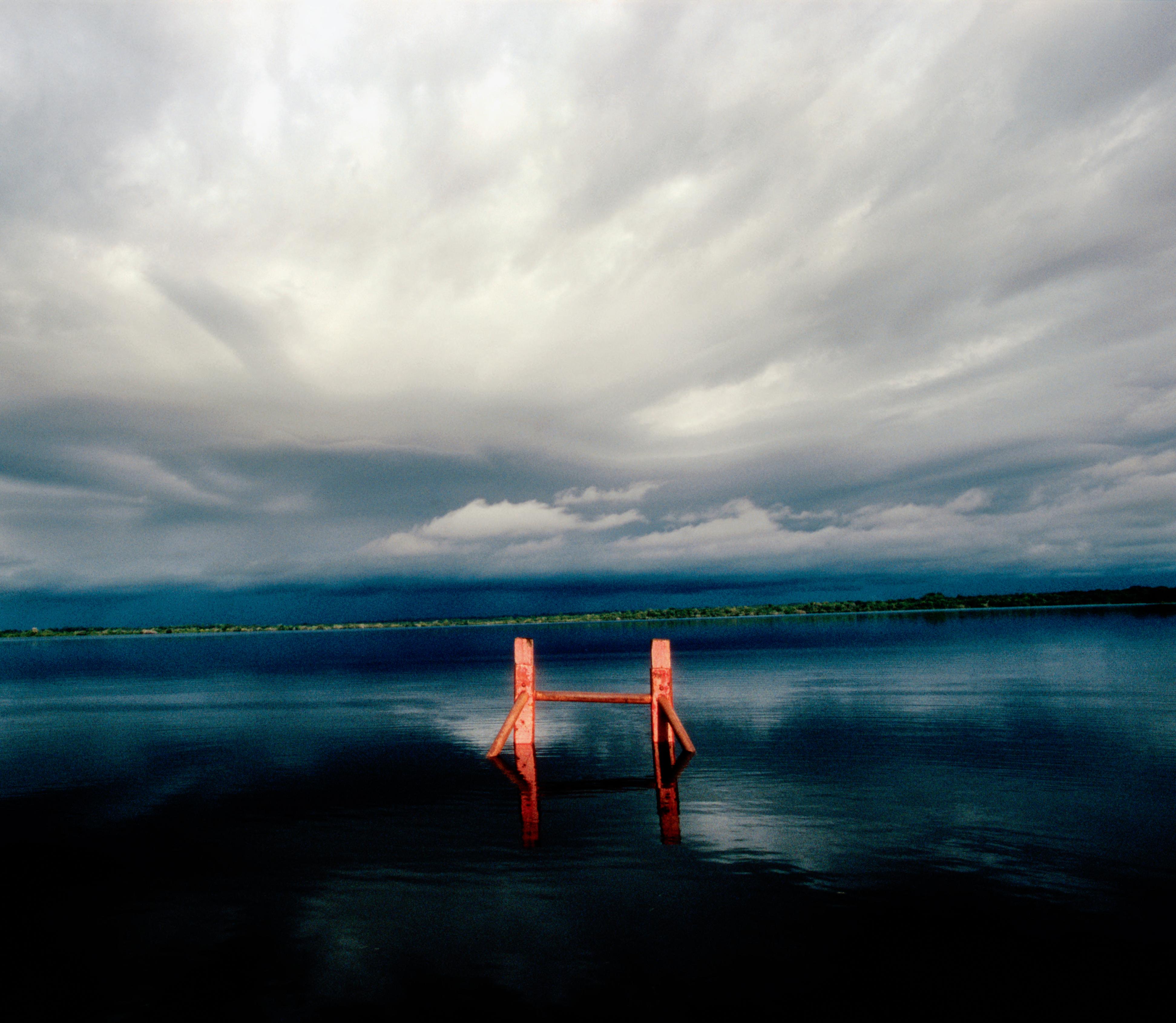

“Tinha um forno; eu achei uma cabeça de cachorro feita de barro. Os antigos faziam muita coisa; eles moravam na terra. Quando morria um deles, não ficavam mais no lugar. Faziam essa arte – é, sim – pra deixar pra nós ver. Eles queriam deixar pra nós.”
Dona Domingas, região de Santarém, Pará

“There was an oven; I found a dog’s head made of clay. The old people made a lot of things; they lived off the land. When one of them died, they didn’t stay at that place. They made this art – yes, it is an art – to leave for us to see. They wanted to leave it for us.”
Domingas, Santarém region, Pará
“Aqui o cemitério é novo. Eu sou o mais velho daqui, mais do que o cemitério. Agora, essas peças são mais velhas do que eu próprio!”
Nelson Neris, Santa Rita do Lago da Valéria, Parintins, Amazonas

“The graveyard is recent here. I am the oldest inhabitant, older than the graveyard. Now, these pieces are older than me!” Nelson Neris, Santa Rita do Lago da Valéria, Parintins, Amazonas




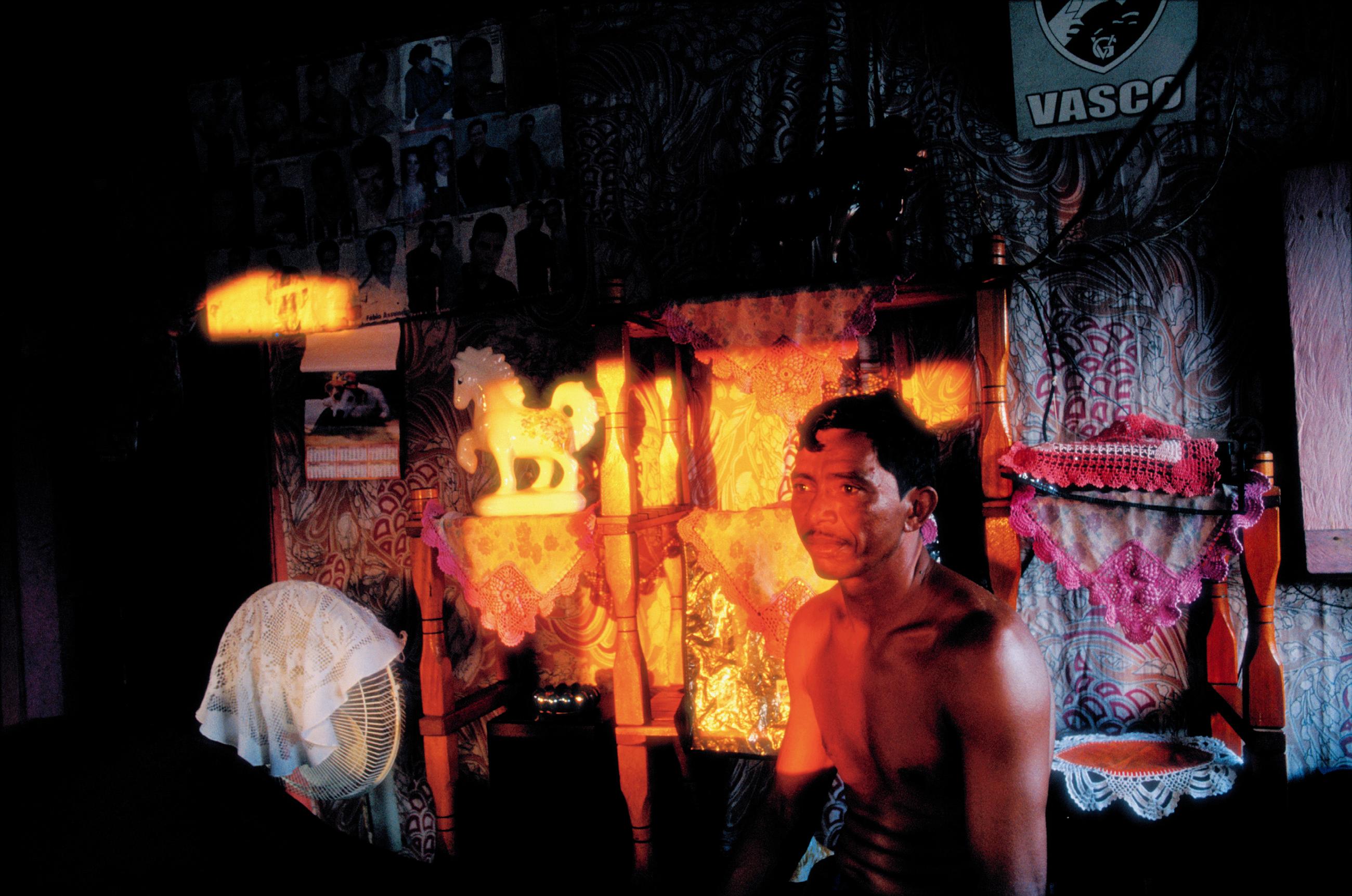
“A parede todinha são os caquinhos. Eu tive a impressão que foi como uma inundação nas camadas e mais camadas. Olhando assim, melhor, parece uma coisa como se fossem prateleiras na parede, como se fosse uma loja de cerâmica ou uma biblioteca de livros de história.”
Marli Braga, ao ver uma unidade de escavação em Iranduba, Amazonas
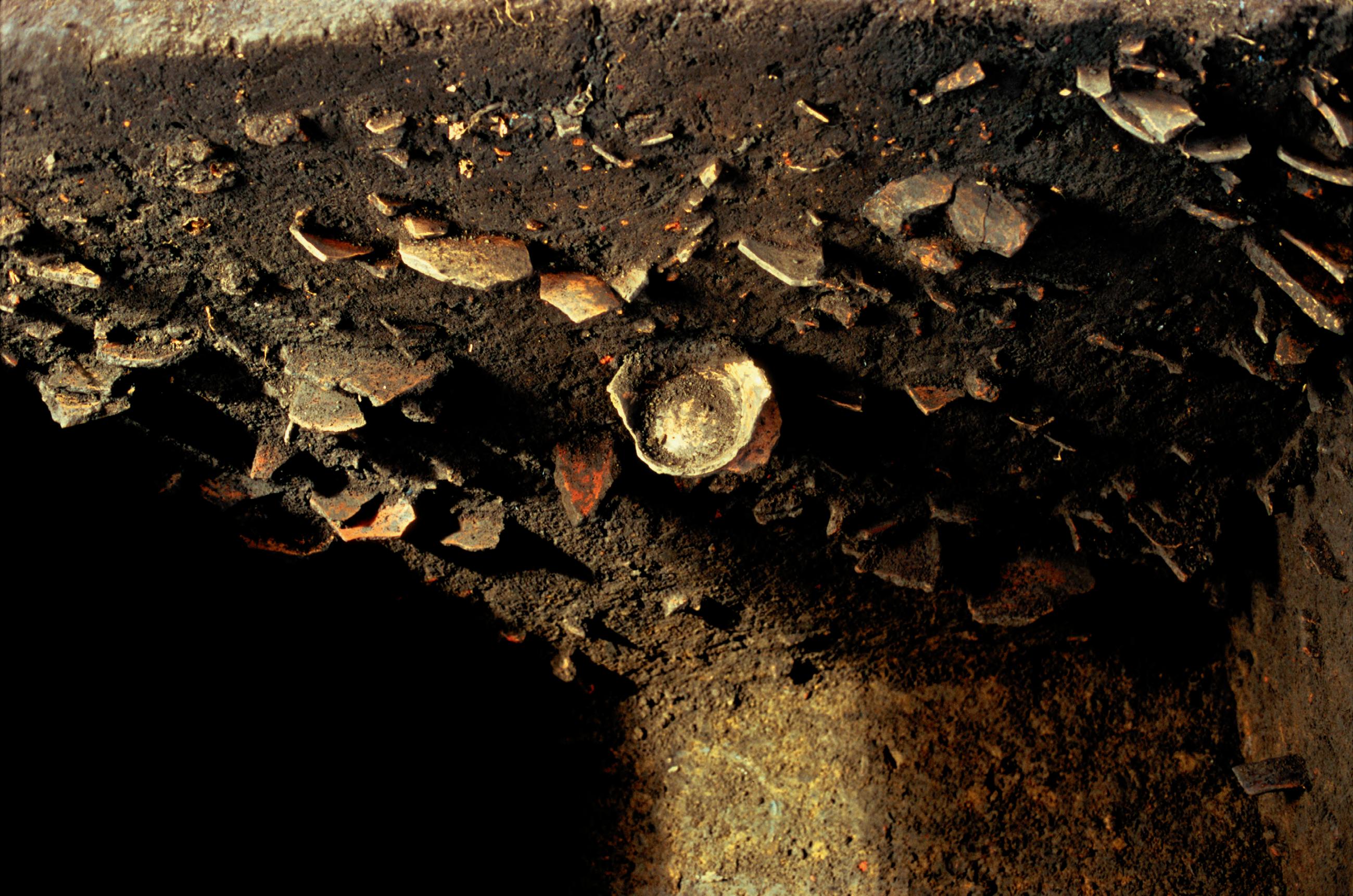
“The entire wall has little shards. I had the impression that it must have been like a flood in the layers, one after the other. Looking this way, better, it looks as if they were racks on the wall, as if it was a pottery shop or a library of history books.”
Marli Braga, upon seeing some excavation work in Iranduba, Amazonas



• 130
Em áreas adjacentes ao rio Solimões, o solo bastante fértil é importante para o sustento de caboclos que cultivam frutos como o mamão. Faz cerca de 2 mil anos, formaram-se ali as terras pretas, pelo acúmulo dos restos orgânicos – ossos de peixe, cascas de frutos e raízes, fezes, carvão vegetal – que as aldeias indígenas depositavam. Essas terras pretas, ricas em fósforo e caracterizadas por pH neutro, coincidem com sítios de grandes depósitos cerâmicos
In the areas next to the Solimões River, the very fertile soil is important to sustain the Caboclos who plant fruit such as papaya. About 2,000 years ago, terras pretas were formed there by accumulating organic remains – fish bones, fruit and root skins, feces, charcoal – which the indigenous villages deposited. Such phosphorus-rich soils, characterized by a neutral pH, coincide with sites of large ceramic deposits






Ao lado: urna funerária antropomorfa da fase guarita Séculos 9º 16 Acervo do Museu Amazônico, Manaus
Ao lado: urna funerária da fase guarita. Séculos 9º-16. Acervo do Museu Manaus
Opposite: anthropomorphic funerary urn from the Guarita phase Ninth to sixteenth century AD Collection of the Museu Amazônico, Manaus urn from the Guarita phase. Ninth to sixteenth century AD. Collection of the Museu Manaus
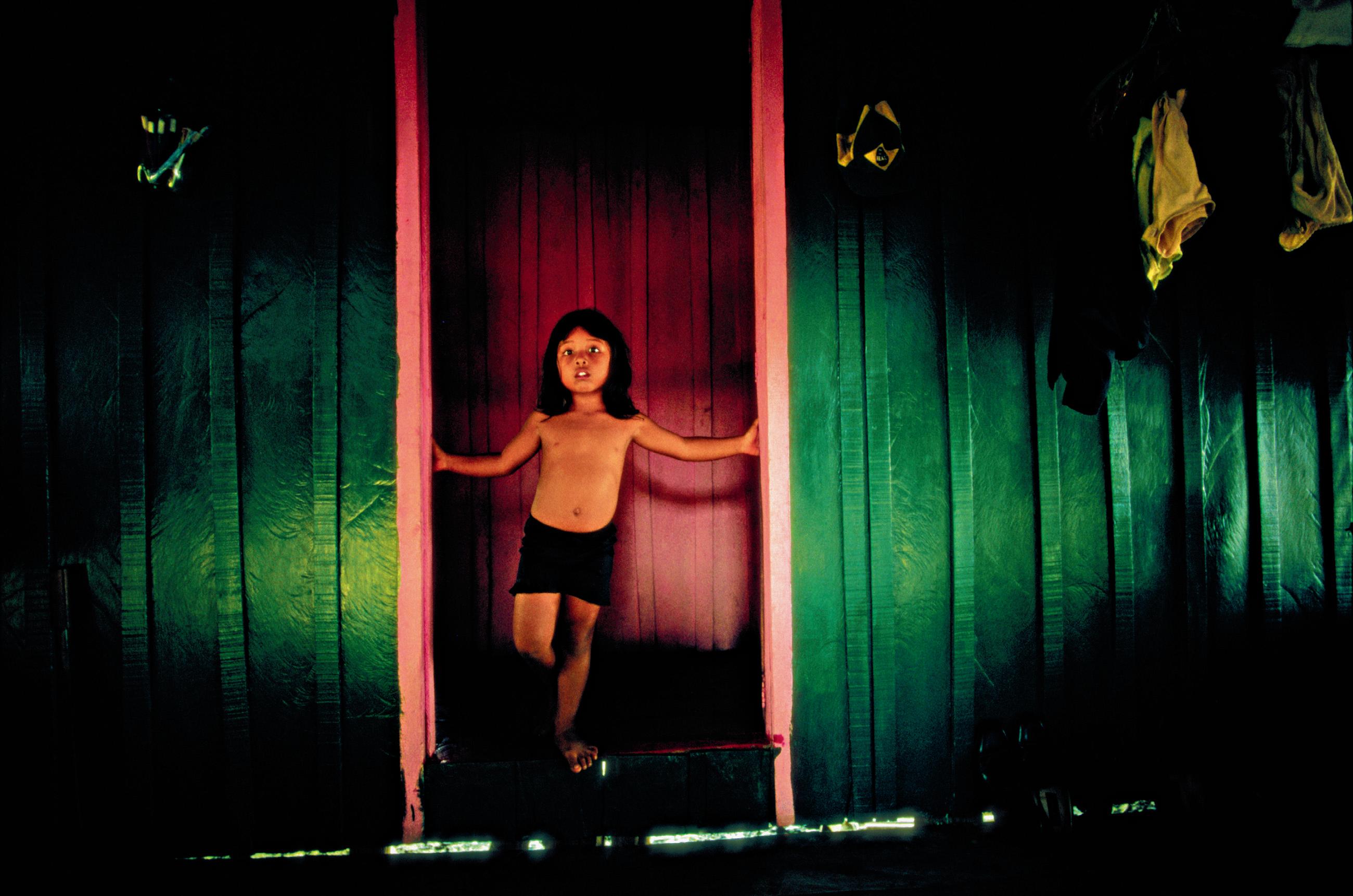
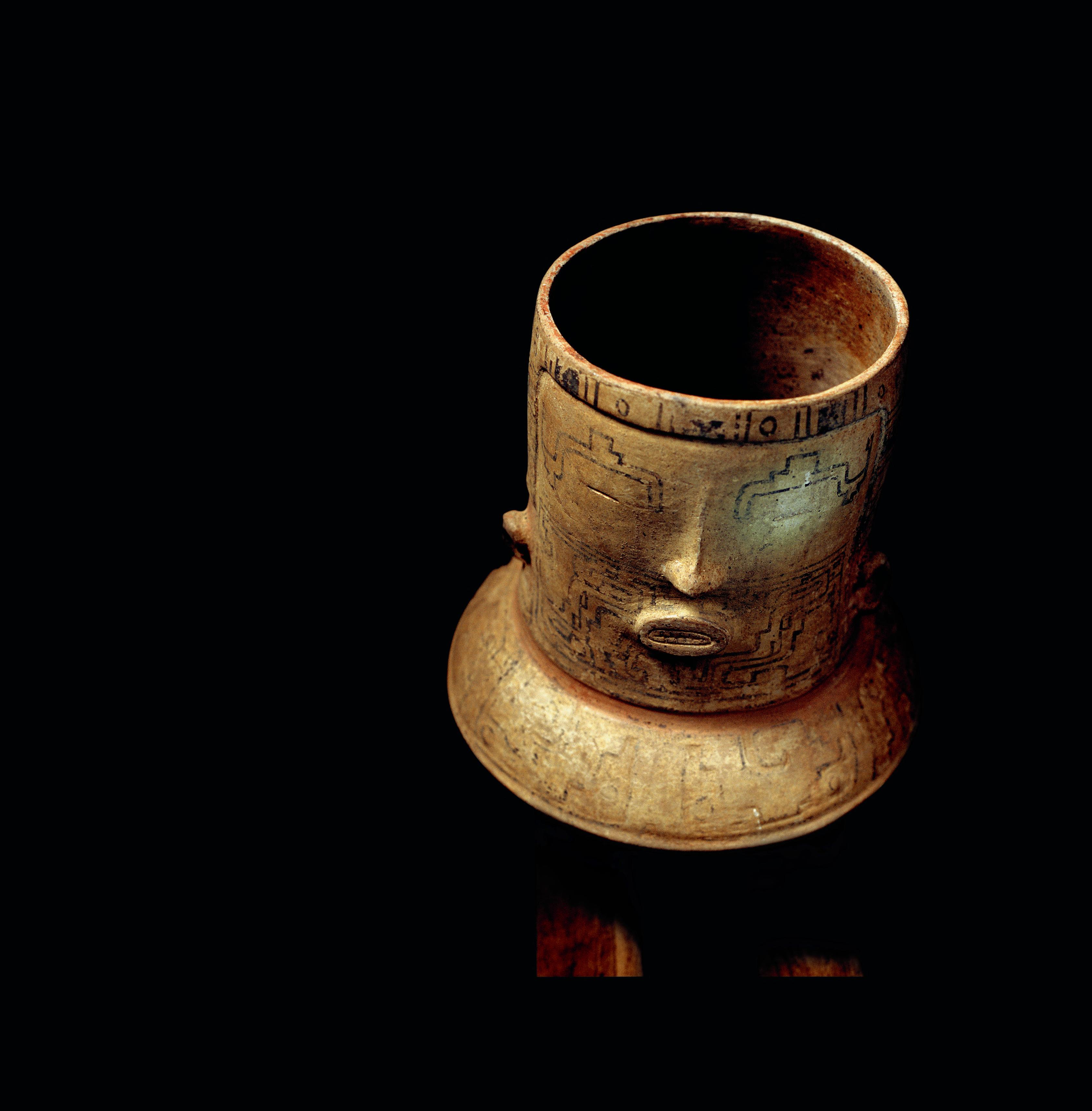
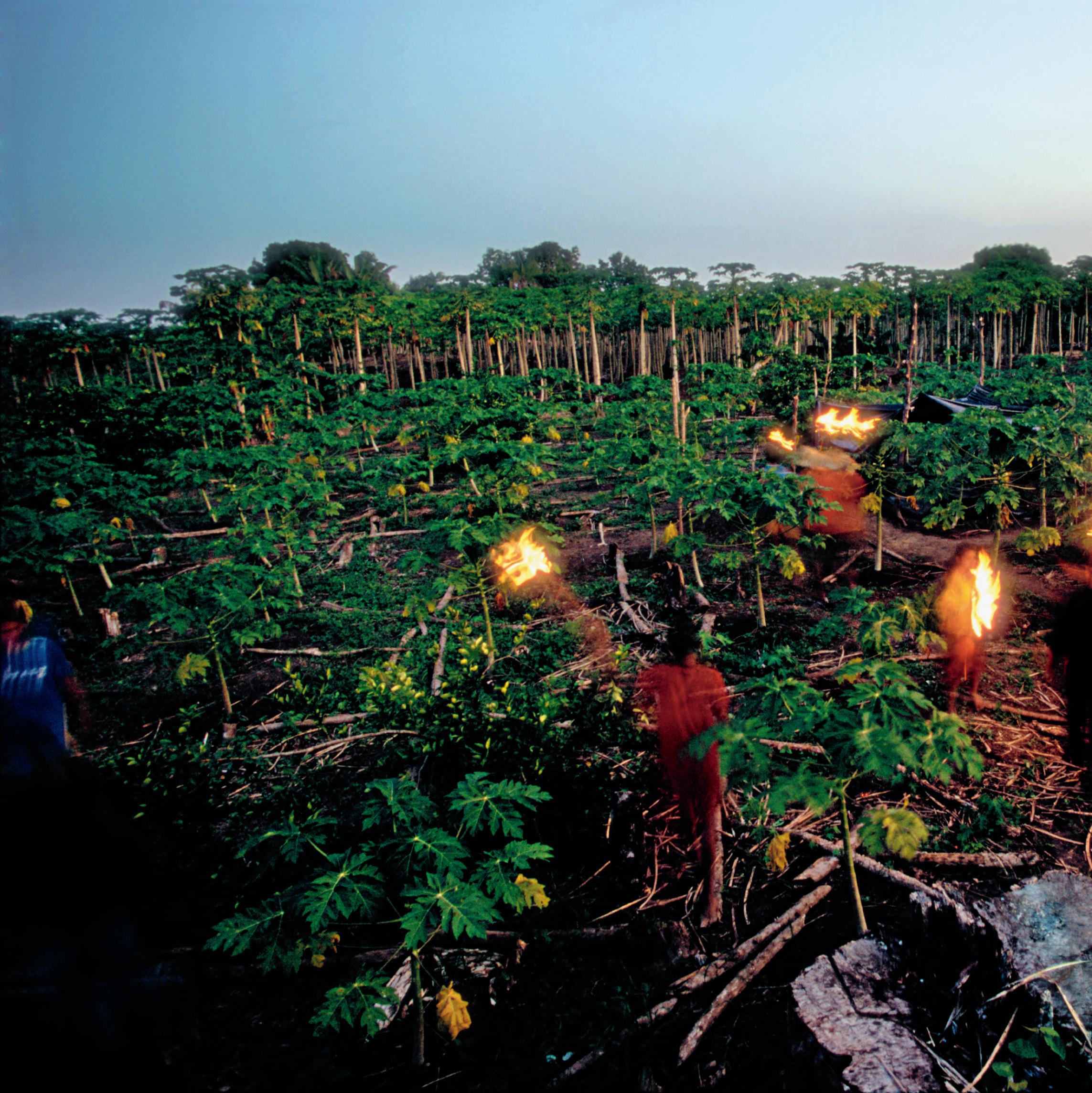
Moradores e arqueólogos com tochas no sítio arqueológico de Laguinho O sítio de Moradores e arqueólogos, com tochas, no sítio de Laguinho. O sítio, de terra preta antrópica fica na várzea do rio Solimões em Iranduba Amazonas e viu quatro terra preta antrópica, fica na várzea do rio Solimões, em Iranduba, Amazonas, e viu quatro fases distintas de ocupação, desde o século 6 fases distintas de desde o século 6o até o 14 Sua parte central é formada de até o 14. Sua parte central é formada de uma série de montículos, erigidos no século 10 uma série de montículos, no século 10o
R e s i d e n t s a n d a r c h a e o l o g i s t s w i t h t o r c h e s a t t h e a r c h a e o l o g i c a l s i t e o f L a g u i n h o Residents and archaeologists with torches at the archaeological site of Laguinho. T h i s a n t h r o p i c This anthropic t e r r a p r e t a terra preta s i t e i s l o c a t e d i n t h e f l o o d p l a i n o f t h e S o l i m õ e s R i v e r site is located in the flood plain of the Solimões River a t I r a n d u b a , A m a z o n a s , a n d h a s s e e n f o u r d i s t i n c t p h a s e s o f o c c u p a t i o n , f r o m t h e at Iranduba, Amazonas, and has seen four distinct phases of occupation, from the s i x t h t o t h e f o u r t e e n t h c e n t u r y I t s c e n t r a l p a r t i s f o r m e d b y a s e r i e s o f sixth to the fourteenth century. Its central part is formed by a series of m o n t í c u l o s montículos , e r e c t e d i n t h e t e n t h c e n t u r y erected in the tenth century

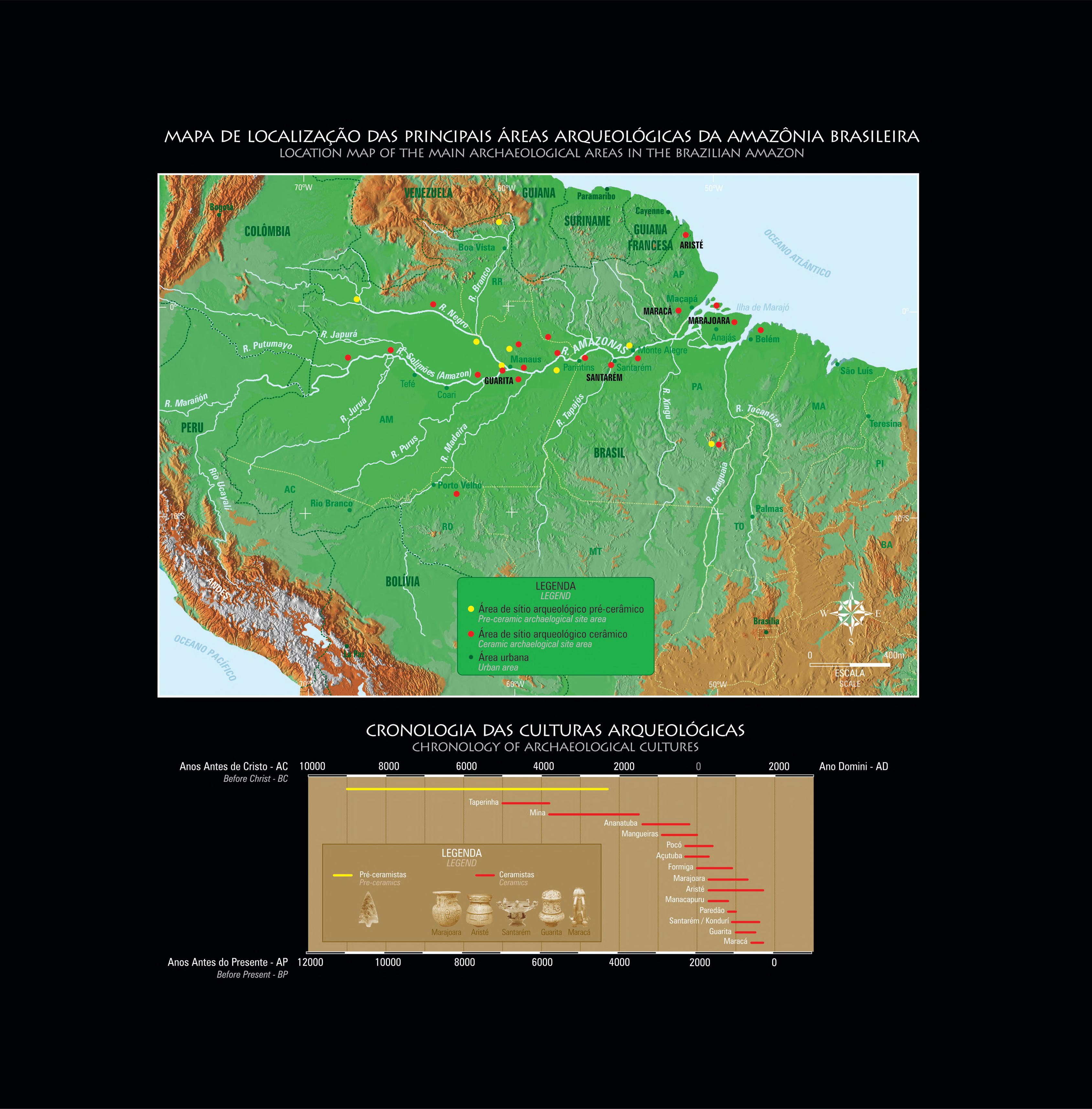
Açaí Fruto da palmeira Euterpe oleracea , nativa da Amazônia. Até hoje indispensável na dieta do paraense, já era (segundo vestígios encontrados em cerâmicas arqueológicas) consumido bem antes da chegada dos europeus.
Antiplástico Elemento (casca de madeira, cacos triturados, conchas etc.) que se adiciona à argila para dar maior resistência aos objetos cerâmicos. Também é conhecido como tempero
Antropomorfo Com forma humana.
Arqueologia Área do conhecimento que busca, pela análise de vestígios materiais, estudar o modo de vida de sociedades do passado.
Cacicados Sociedades estratificadas em que um poder político centralizado comandava diversos grupos, abrangendo áreas de até dezenas de quilômetros de raio. A maioria dos cacicados amazônicos surgiu no final do primeiro milênio d. C.
Casco Na Amazônia, nome popular para canoa
Engobo Camada de argila associada a substâncias vegetais que pode recobrir a superfície de peças cerâmicas. Pode ser ou não pigmentado.
Estratigrafia Ramo da geologia que estuda as camadas de rocha, buscando compreender seu processo de formação.
Excisão Retirada de áreas da superfície da cerâmica, antes ou depois da queima, para produzir desenhos em alto-relevo.
Fase Modo pelo qual são classificados artefatos com semelhante confecção e decoração e com disposição espacial e temporal em comum. Por exemplo, fase guarita, fase marajoara.
Feição Manchas escuras no solo resultantes de combustão.
Geóglifos Grandes figuras geométricas traçadas no solo. No Brasil, são encontradas no Acre.
Incisão Motivo produzido em baixo-relevo quando se pressiona um instrumento contra a superfície da cerâmica.
Lítico Produzido com pedra. Por exemplo, machadinhas e pontas de flecha.
Monólito Grande bloco inteiriço de rocha sobre um terreno.
Montículo Espécie de monte construído com terra preta e grande quantidade de fragmentos de cerâmica arqueológica.
Policromia Emprego de muitas cores numa mesma obra. Aqui, tipo de acabamento em peças cerâmicas que se caracteriza por pinturas em preto e vermelho sobre engobo branco. Cerâmicas policrômicas são encontradas em praticamente toda a região amazônica.
Pré-história Período que antecede a escrita. No Brasil, é considerado pré-histórico o que é anterior à chegada dos colonizadores europeus.
Sambaquis Aterros arqueológicos produzidos com areia e conchas. Estão presentes em boa parte do litoral brasileiro.
Sítio arqueológico Local onde se encontram vestígios deixados por sociedades do passado.
Sítio-escola Pesquisas realizadas em sítios arqueológicos periodicamente, quando alunos de diversas áreas têm oportunidade de participar de escavações.
Terra preta arqueológica Tipo de solo constituído ao longo de séculos pelo acúmulo de dejetos orgânicos derivados de atividades humanas.
Tesos Grandes montes artificiais com altura de até doze metros e área de até três hectares. São comuns no arquipélago de Marajó, no Pará, e podem ter sido construídos para moradia da elite marajoara.
Tradagem Retirada em sentido vertical de volumes de terra para amostra. Para definir as camadas arqueológicas, essas amostras são geralmente separadas a cada vinte centímetros.
Tradição Modo pelo qual se classificam artefatos com confecção e decoração semelhantes, mas com disposição espacial e temporal diversa. Por exemplo, tradição policrômica da Amazônia.
Voadeira Espécie de pequena embarcação dotada de motor.
Zoomorfo Em forma de animal.
Açaí Fruit of the Euterpe oleracea palm, native of the Amazon. It was consumed well before Europeans arrived, according to vestiges found in archaeological ceramic pieces, and it is still indispensable in the diet of Pará.
Anthropomorphic With a human-like shape.
Antiplastic A material (tree bark, ground shards, shells, etc.) which is added to clay in order to increase the resistance of ceramic objects. Also known locally as tempero (“seasoning”).
Archaeological site A place where vestiges left by societies from the past can be found.
Archaeology A field of knowledge that seeks to study the way of living of societies from the past by analyzing material vestiges.
Cacicados Stratified societies in which a centralized political power ruled over several groups, comprising areas up to a radius of tens of kilometers. Most Amazonian cacicados appeared in the late first millennium AD.
Casco A popular name for a canoe in the Amazon.
Engobe A layer of clay mixed with vegetable substances which may coat the surface of ceramic pieces. It may or may not be pigmented.
Excision Removal of areas from the surface of ceramic pieces, either before or after firing, to produce drawings in relief.
Feição Dark stains on the soil originating from combustion.
Geoglyphs Large geometric figures traced on the ground. In Brazil, they are found in Acre.
Incision A motif produced in bas-relief when an instrument is pressed against the surface of the ceramic.
Lithic Something produced with stones. For example, axes and arrow points.
Monolith A large single block of rock on terrain.
Montículo A kind of mound built with terra preta and a large number of archaeological ceramic fragments.
Period The way artifacts with similar workmanship and decoration and common spatial and temporal disposition are classified. For example, Guarita and Marajoara periods.
Polychromy The use of many colors in the same work. In Amazonian archaeology, a kind of finish in ceramic pieces marked by paintings in black and red on a white engobe. Polychromatic ceramic pieces are found in virtually the entire Amazon region.
Prehistory The period before the use of writing. In Brazil, something is said to be prehistoric if it dates from before the arrival of European colonizers.
Sambaquis Archaeological mounds or middens made with sand and seashells. They can be found in a large portion of the Brazilian coast.
School site Research performed periodically at archaeological sites in which students from several fields have the opportunity to take part in excavations.
Stratigraphy A branch of geology that studies layers of rock, aiming to understand their forming process.
Terra preta Portuguese for “black earth”. A kind of soil formed by accumulating organic reject from human activities for centuries.
Tesos Large artificial mounds, up to twelve meters high and three hectares in area. They are common in the Marajó archipelago of Pará, and may have been built as living places for the Marajoara élite.
Tradagem Vertical removal of amounts of soil for sampling. In order to define archaeological layers, such samples are usually spaced twenty centimeters apart.
Tradition A way of classifying similarly produced and decorated artifacts with different spatial and temporal arrangements. For example, “polychromatic tradition of the Amazon”.
Voadeira A kind of small boat with a motor.
Zoomorphic Shaped as an animal.
Para iniciar, usamos com apreço o argumento impressionista do arqueólogo Claide de Paula Moraes, em homenagem e força: “As fotografias sempre têm uma sombra que dela é não vista, escura, […] não-vista sobre o passado”.
Algo de morte, de antiluz? Linguagem? Enigma ou cor de terra profunda? Afoiteza de hipóteses e impermanências da arqueologia afora, raízes e fendas úmidas, em camadas barrocas e pré-ocupadas? Tudo isso os desafios de intentar captar na imagem alguma sinergia, a entrelinha de fazer ficção com certo bálsamo científico que é a arqueologia.
Eu e Mônica, acreditando na união, lançamos uma luz sobre o passado e agradecemos a todos os que – desde cinco anos atrás – viram este projeto com bons olhos:
À Consigo Som e Imagem, pelo apoio cultural e material, nas pessoas de Mayra Lamy Xavier e Amilton Oliveira Xavier, que agiram no espírito de promover a fotografia com seriedade e postura profissional.
Ao Iphan, sub-regional Amapá-2SR, na destreza de Luciano Souza e Simone Macêdo; a Bepy Neves Cyrino, superintendente do Iphan-AM; e ao Sebrae e à Secretária Municipal de Educação de Macapá (Semec), pelos muitos créditos.
Ao Museu de Arqueologia e Etnologia da USP, nas figuras de Adriana Sampaio Neves, Cristiana Barreto e Carla Gibertone Carneiro; dos integrantes da equipe de Educação Patrimonial e Reserva Técnica; do diretor, José Luiz de Morais; e de Maria Cristina Oliveira Bruno. Ao Museu Paraense Emílio Goeldi, de Belém, nas pessoas da antropóloga Lourdes Furtado, de Rafael Nascimento (in memoriam) e de Edithe Pereira. E ao Museu Nacional do Rio de Janeiro, em particular à arqueóloga Denise Maria Cavalcante Gomes. À arqueóloga Denise Pahl Schaan, da Universidade Federal do Pará, elo hábil que nos recebe desde 2005.
A Nickolas Cabral, da Amazonastur; Benigna Soares e Adenauer Góes, da Paratur; Arnoudo Cunha, da Semtur; e Arnaldo Carneiro, Fabiano Silva e Inácio Oliete, da Fundação Vitória Amazônica (FVA).
Aos arqueólogos João Saldanha e Mariana Cabral, do Iepa. Ao Programa Arqueológico Gasoduto Coari-Manaus (Petrobras). E aos profissionais e pesquisadores do Projeto Amazônia Central (PAC): dr. Fernando da Silva Costa, Adriana Meinking, Alexandro Namem, Anne Rapp Py-Daniel, Bernardo Lacale, Bob Bartone, Carlos Augusto da Silva (“Tijolo”), Claide Moraes, Eduardo Kazuo Tamanaha, Elaine Wanderley, Fabio de Almeida, Helena Pinto Lima e Bruno,
Juliana Machado, Julio Dui, Leandro Cascon, Luis B. Pinto, Manuel Arroyo, Maria Tereza Parente, Marjorie Lima, Miguel Espino, Marcio Castro, Marcos Brito, Michael Heckenberger, Morgan Schmidt, Raoni do Vale, Regivaldo da Silva, Silvia Cunha Lima, Valdirene Moraes e Willian Woods.
A Wenceslau Teixeira, da Embrapa.
Aos moradores e técnicos em arqueologia do Amazonas: Claudio Roberto Cunha, Francisco Villaça Nunes (“Pupunha”), Levemilson Mendonça da Silva (“Delegado”), Leandro Camilo da Silva e Edimar da Silva Alves e família. A José Natalino e Luiz Neves, em Maués (AM). A Laílson Camelo da Silva (“Garrafa”) e esposa, Nilza, em Calçoene (AP). Aos agricultores Pedro Gomes Dias e Jafé, João e Raimunda Braga, em Iranduba (AM). Aos pescadores Manuel Nazareno (“Roxo”) e família e Zeca Barata, em Apeú Salvador (PA). Ao seu Lino, do Museu do Marajó. A Raimundo Socorro (“Sarito”), em Afuá (PA), e Sindomar e Otávia, na comunidade de Parauá, rio Tapajós (PA). E ao artesão mestre Cardoso e dona Dita, em Belém (ambos in memoriam).
À revista National Geographic Brasil , na confiança e segurança de Ronaldo Ribeiro, Cristina Veit, Cristina Catussato, Roberto Sakai e Matthew Shirts. Ao singular editor João Bittar. A Eder Chiodetto, Ricardo Franca Cruz, Luiz Pellegrini, Liana John, José Augusto Bezerra, Henrique Skujis e Tetê Martinho. Aos fotógrafos André Esquivel, André Douek, Araquém Alcântara, Everton Ballardin, João Wainer, Luciano Candisani, Miguel Chikaoka, Pisco Del Gaiso e Rogério Assis. A Gabriel Boieiras e Luciana Cattani, do Território da Foto. Aos escritores Nei Duclós e Luis Roberto Guedes. Ao poeta Frederico Barbosa, da Casa das Rosas. Aos irmãos Reinaldo e Marcelo Paiva. Às mães Margarida Barros e Delmira Trindade Canejo. A Márcio Wagner, da Caixa Preta Propaganda. Ao amigo Paulo Ribeiro. E a Alexander Buehler, de Hamburgo.
Ao dr. Eduardo Góes Neves. Ao publisher Alexandre Dórea, a Carmem Carvalho e a Andrea M. Santos, todos da DBA, uma presença constante, consciente e assertiva no projeto – obrigado por terem aceitado. Aos artistas do Estúdio DBA. E aos préstimos de Ernandes Melo, artista plástico amapaense que foi acompanhante nas viagens e se tornou um grande amigo, e às portas que sua família generosamente nos abriu.
Just for a start, we have used as a tribute archaeologist Claide de Paula Moraes’s impressionist argument: “Photographs always have a shadow that is not seen from it, dark, […] unseen about the past.”
Something about death, about anti-light? Enigma or deep-earth color? Through hasty hypotheses and the impermanences of archaeology, humid roots and crevices, in Baroque and pre-occupied layers? All that, the challenges of trying to capture in images some synergy, making fiction between the lines with a certain scientific balsam that is archaeology.
Mônica and I, believing in union, have shed a light on the past and thank all those who – since five years ago – have seen this project in a good light:
For the cultural and material support, thanks to Consigo Som e Imagem, particularly Mayra Lamy Xavier and Amilton Oliveira Xavier, who acted in the spirit of promoting photography with a serious and professional attitude;
TO IPHAN (the Brazilian Institute for the National Historical and Artistic Heritage), subregional section Amapá-2SR, for the dexterity of Luciano Souza and Simone Macêdo; to Bepy Neves Cyrino, IPHAN’s superintendent in Amazonas; and to SEBRAE (the Brazilian Service of Support for Micro and Small Enterprises) and SEMEC (the City of Macapá Education Department), for the many credits they granted us.
To the University of São Paulo’s Museum of Archaeology and Ethnology, in the persons of Adriana Sampaio Neves, Cristiana Barreto and Carla Gibertone Carneiro; to the members of the Heritage Education and Technical Reserve teams; to the director, José Luiz de Morais; and to Maria Cristina Oliveira Bruno. To the Emílio Goeldi Museum of Pará, in Belém, in the persons of anthropologist Lourdes Furtado, Rafael Nascimento (in memoriam) and Edithe Pereira. And to the National Museum of Rio de Janeiro, particularly to archaeologist Denise Maria Cavalcante Gomes. To archaeologist Denise Pahl Schaan, of the Federal University of Pará, an able link who has been receiving us since 2005.
To Nickolas Cabral, of Amazonastur; Benigna Soares and Adenauer Góes, of Paratur; Arnoudo Cunha, of SEMTUR; and Arnaldo Carneiro, Fabiano Silva and Inácio Oliete, of FVA (Vitória Amazônica Foundation).
To archaeologists João Saldanha and Mariana Cabral, of IEPA (State of Amapá Institute for Scientific and Technological Research). To the Archaeological Program of the Coari-Manaus Gas Pipeline (Petrobras). And to the professionals and researchers of PAC (the Central Amazon Project):
Dr. Fernando da Silva Costa, Adriana Meinking, Alexandro Namem, Anne Rapp Py-Daniel, Bernardo Lacale, Bob Bartone, Carlos Augusto da Silva (“Tijolo”), Claide Moraes, Eduardo Kazuo Tamanaha, Elaine Wanderley, Fabio de Almeida, Helena Pinto Lima and Bruno, Juliana Machado, Julio Dui, Leandro Cascon, Luis B. Pinto, Manuel Arroyo, Maria Tereza Parente, Marjorie Lima, Miguel Espino, Marcio Castro, Marcos Brito, Michael Heckenberger, Morgan Schmidt, Raoni do Vale, Regivaldo da Silva, Silvia Cunha Lima, Valdirene Moraes and Willian Woods.
To Wenceslau Teixeira, of EMBRAPA (the Brazilian Company for Agricultural Research).
To the inhabitants and archaeology technicians of Amazonas: Claudio Roberto Cunha, Francisco Villaça Nunes (“Pupunha”), Levemilson Mendonça da Silva (“Delegado”), Leandro Camilo da Silva and Edimar da Silva Alves and his family. To José Natalino and Luiz Neves, in Maués, Amazonas. To Laílson Camelo da Silva (“Garrafa”) and his wife, Nilza, in Calçoene, Amapá. To farmers Pedro Gomes Dias and Jafé, João and Raimunda Braga, in Iranduba, Amazonas. To fishermen Manuel Nazareno (“Roxo”) and his family and Zeca Barata, in Apeú Salvador, Pará. To Mr. Lino, of the Marajó Museum. To Raimundo Socorro (“Sarito”), in Afuá, Pará, and Sindomar and Otávia, in the settlement of Parauá, Tapajós River, Pará. And to master artisan Cardoso and Ms. Dita (both in memoriam), in Belém.
To National Geographic Brasil magazine, for the trust and security that Ronaldo Ribeiro, Cristina Veit, Cristina Catussato, Roberto Sakai and Matthew Shirts have granted us. To João Bittar, editor extraordinaire. To Eder Chiodetto, Ricardo Franca Cruz, Luiz Pellegrini, Liana John, José Augusto Bezerra, Henrique Skujis and Tetê Martinho. To photographers André Esquivel, André Douek, Araquém Alcântara, Everton Ballardin, João Wainer, Luciano Candisani, Miguel Chikaoka, Pisco Del Gaiso and Rogério Assis. To Gabriel Boieiras and Luciana Cattani, of Território da Foto. To writers Nei Duclós and Luis Roberto Guedes. To poet Frederico Barbosa, of the House of Roses in São Paulo. To the brothers Reinaldo and Marcelo Paiva. To our mothers, Margarida Barros and Delmira Trindade Canejo. To Márcio Wagner, of Caixa Preta Propaganda. To our friend Paulo Ribeiro. And to Alexander Buehler, from Hamburg.
To Dr. Eduardo Góes Neves. To publisher Alexandre Dórea, Carmem Carvalho and Andrea M. Santos, all of them at DBA, a constant, conscious and assertive presence in this project – thanks for having accepted it. To the graphic artists of DBA Studio. And to the services of Ernandes Melo, a fine artist from Amapá who accompanied us in our travels and became a great friend, and to the doors that his family generously opened to us.
Estatueta cerâmica da cultura tapajônica, região de Santarém, Pará Estatueta cerâmica da cultura tapajônica, região de Santarém, Pará.
Provavelmente início do segundo milênio d C Acervo do MAE USP Provavelmente início do milênio d. C. Acervo do MAE-USP
Ceramic statuette of the Tapajós culture, Santarém region, Pará Prob Ceramic statuette of the culture, Santarém Pará. Probably from the early second millennium A D Collection of the MAE USP from the second millennium A.D. Collection of the MAE-USP

I m p r e s s o n o B r a s i l Impresso no Brasil | P r i n t e d i n B r a z i l Printed in Brazil
DBA Dórea Books and Art
Al Franca, 1185 cj 31/32 Al. Franca, 1185 cj. • CEP 01422 001 01422-001
Cerqueira César César • São Paulo Paulo • SP • Brasil tel tel. phone phone: (55 11) 3062 1643 : 3062 1643 • fax: (55 11) 3088 3361 fax: 3088 3361 dba@dbaeditora com br dba@dbaeditora.com.br • www dbaeditora com br www.dbaeditora.com.br
Dados Internacionais de na (CIP) (Câmara Bras leira do Livro, SP, Brasil) Brasileira do Amazônia antiga : arqueologia no entorno = Ancient Amazon an archaeology in the surround ngs Amazônia : no entorno = Ancient Amazon an in the surroundings /fotografias/photos Maur c o de Paiva ; textos/texts Mônica Canejo ; rev são de texto e tradução/ Maurício de Paiva ; textos/texts Mônica ; [revisão de texto e proofreading and Engl sh version Mário Vilela São Pau o : DBA Artes Gráficas 2009 and English version Mário Vilela]. -- São Paulo : DBA Artes Gráficas, 2009.
Dados Internacionais de Catalogação na Publicação (CIP)
